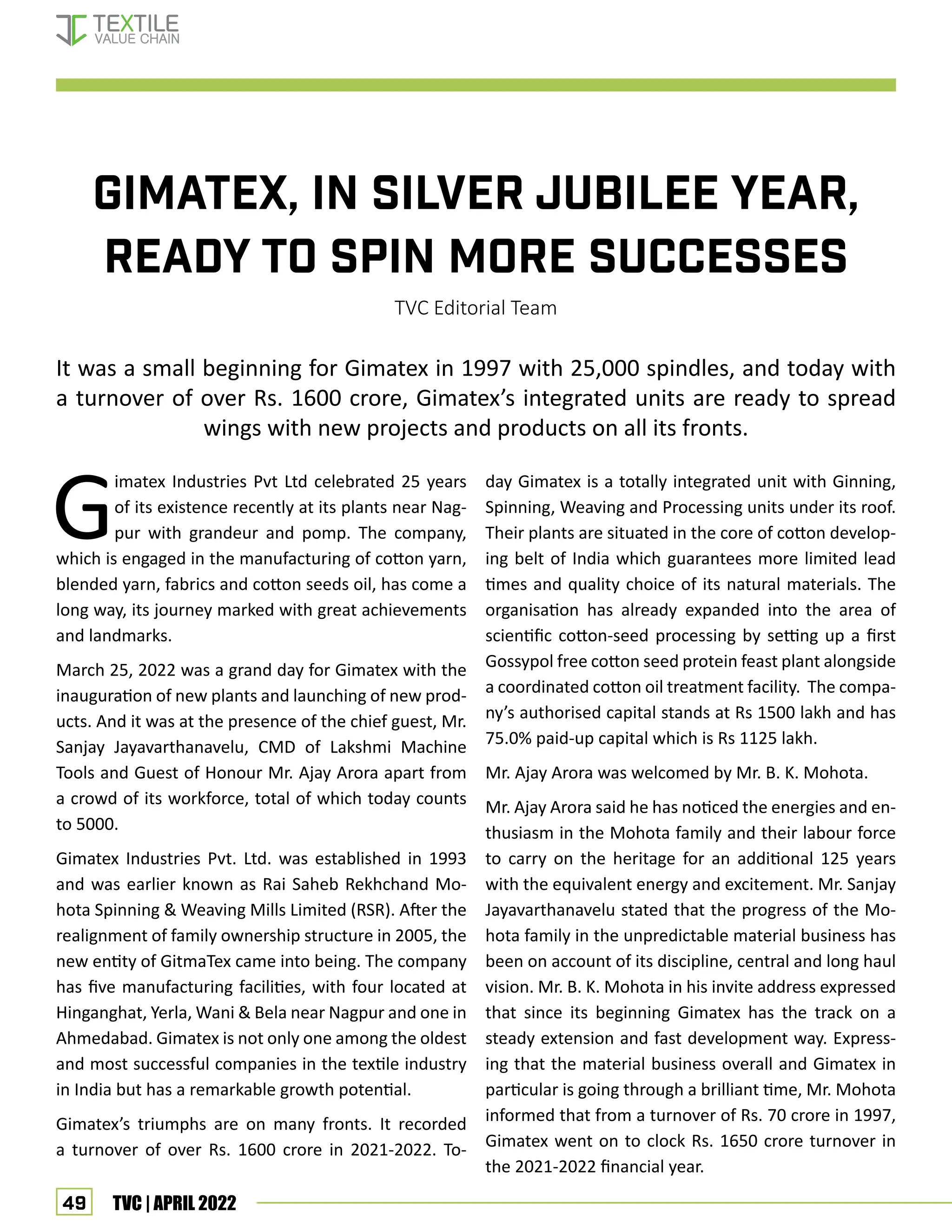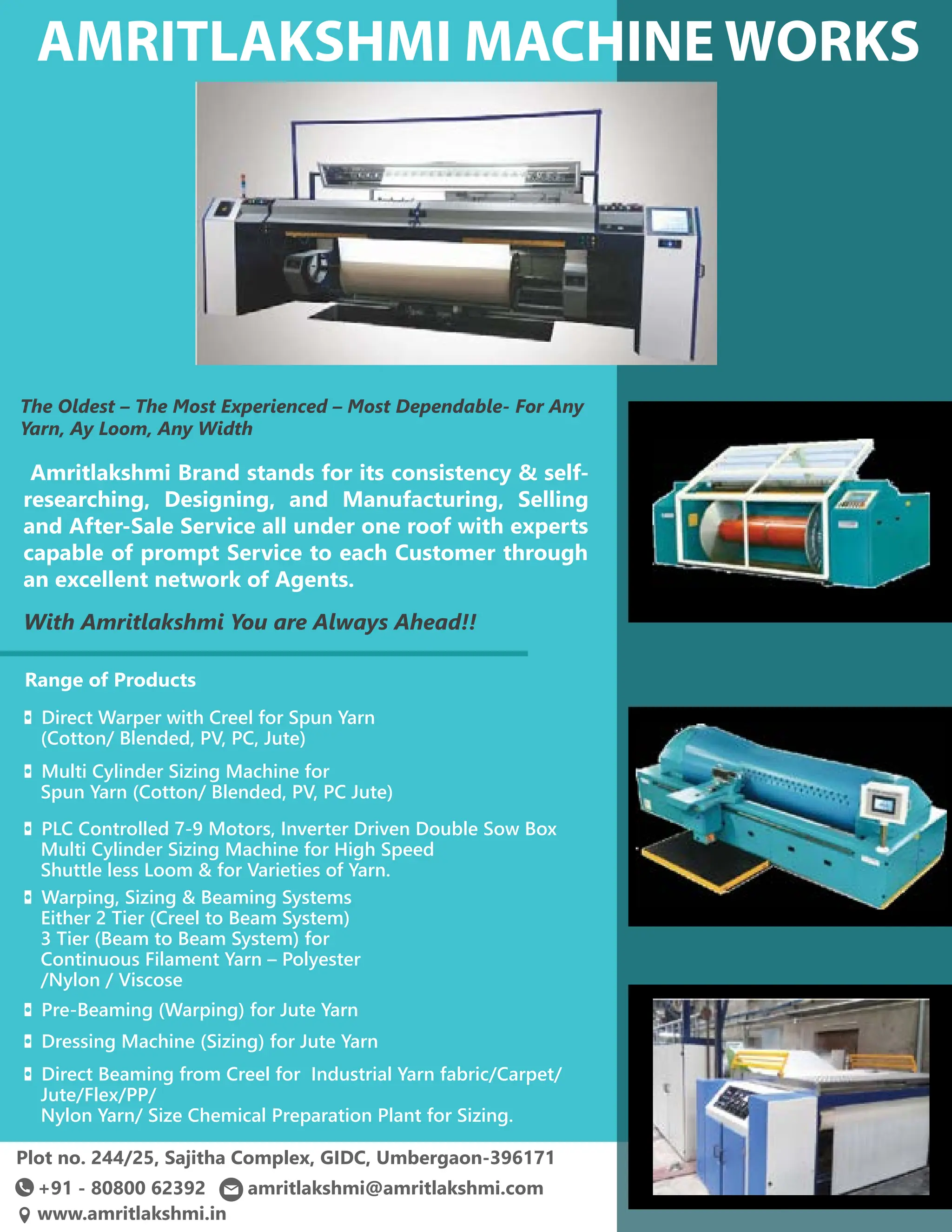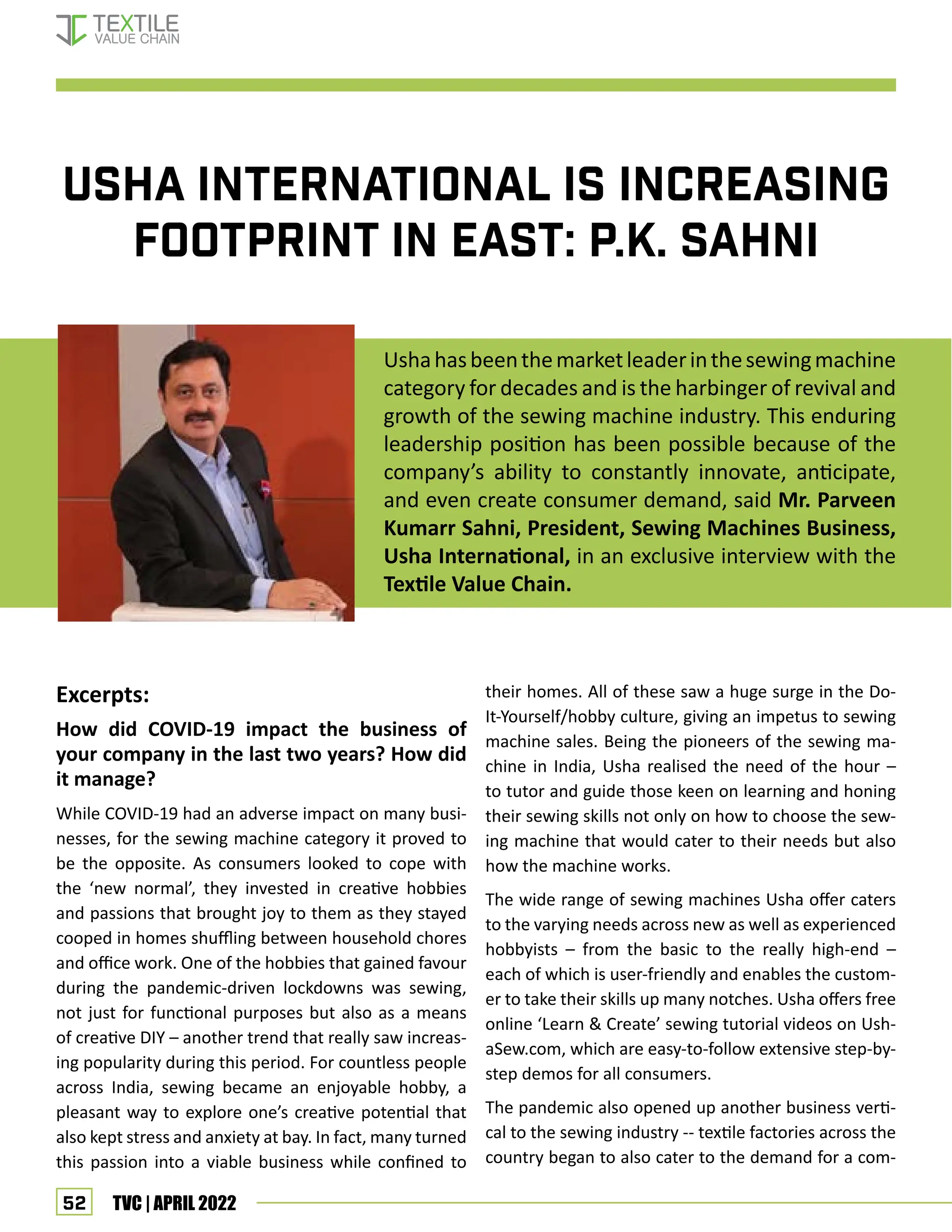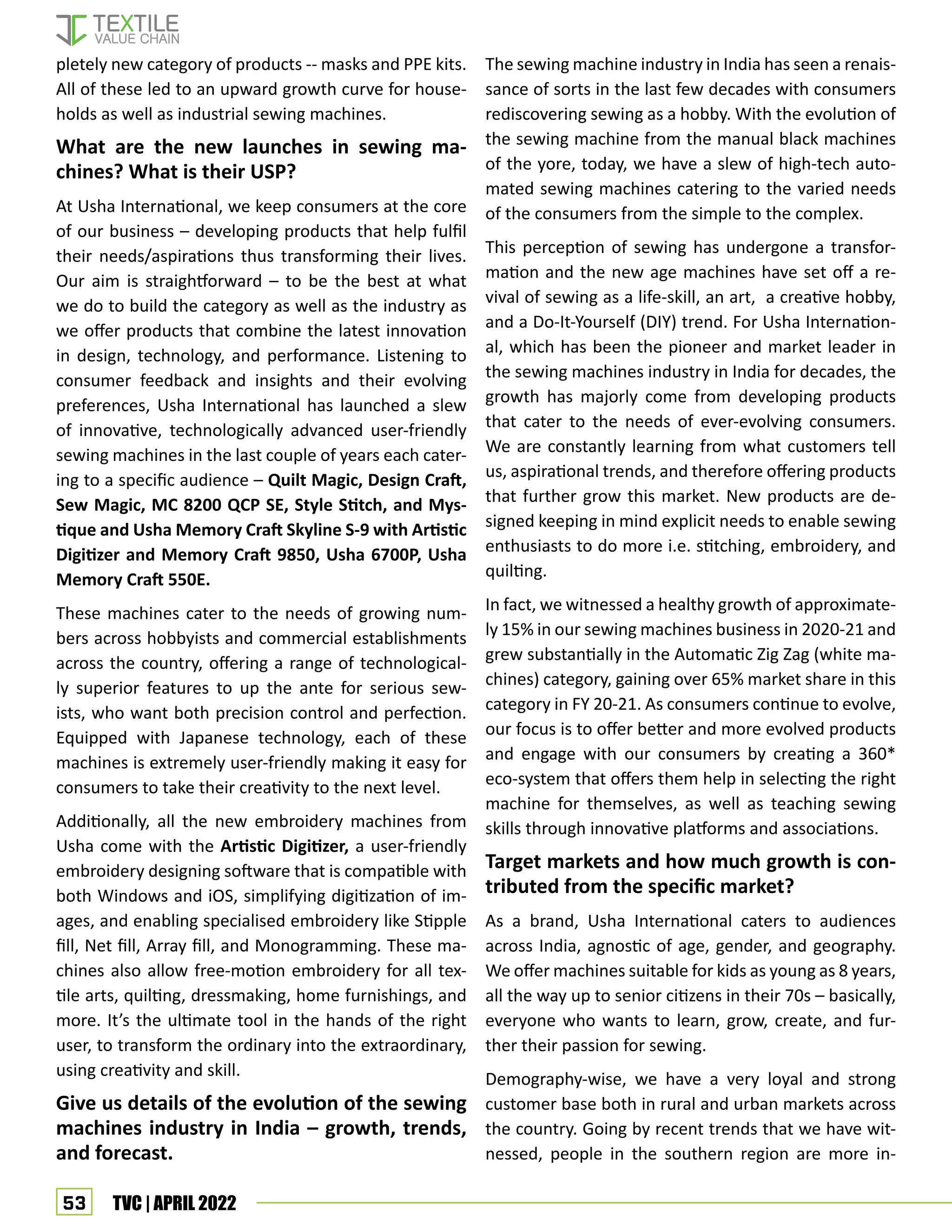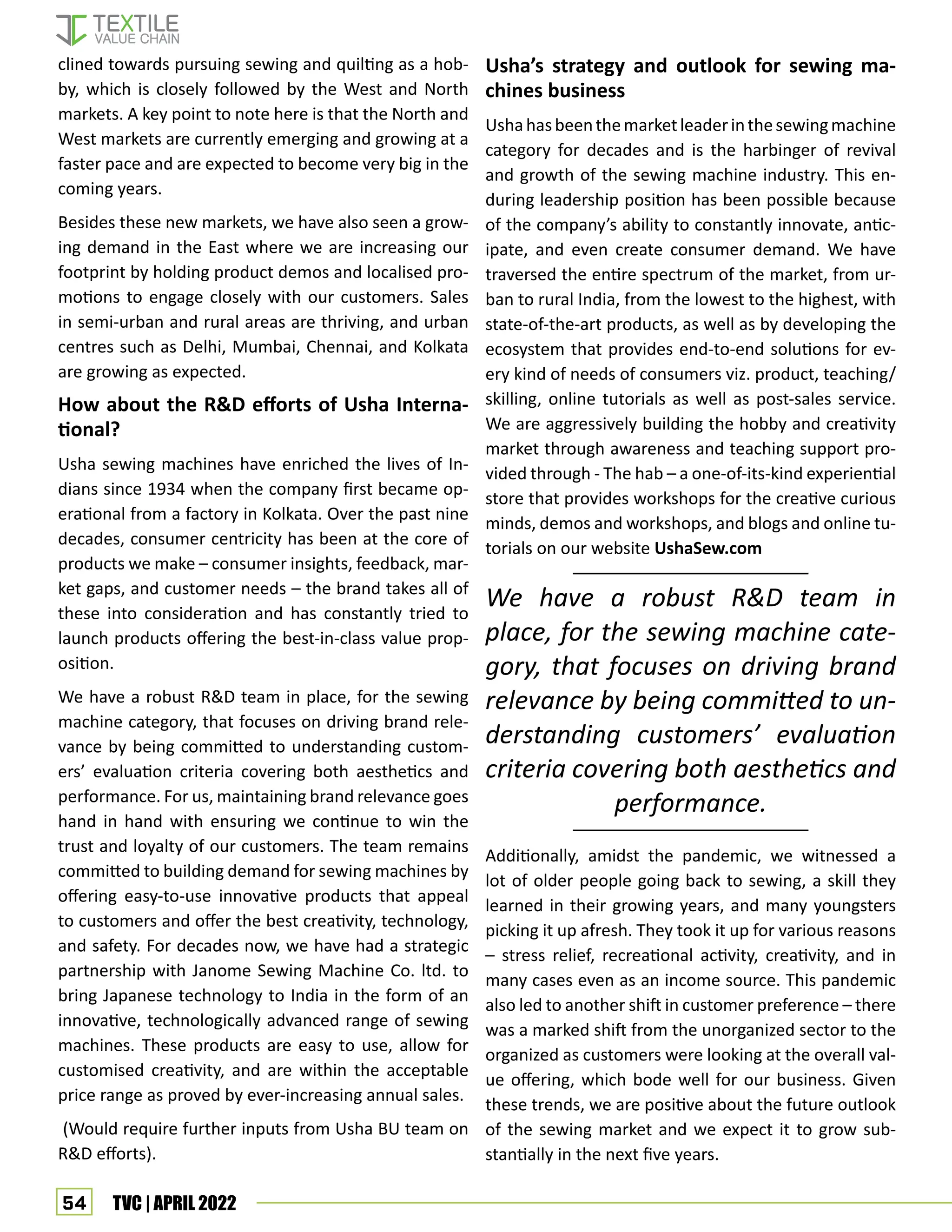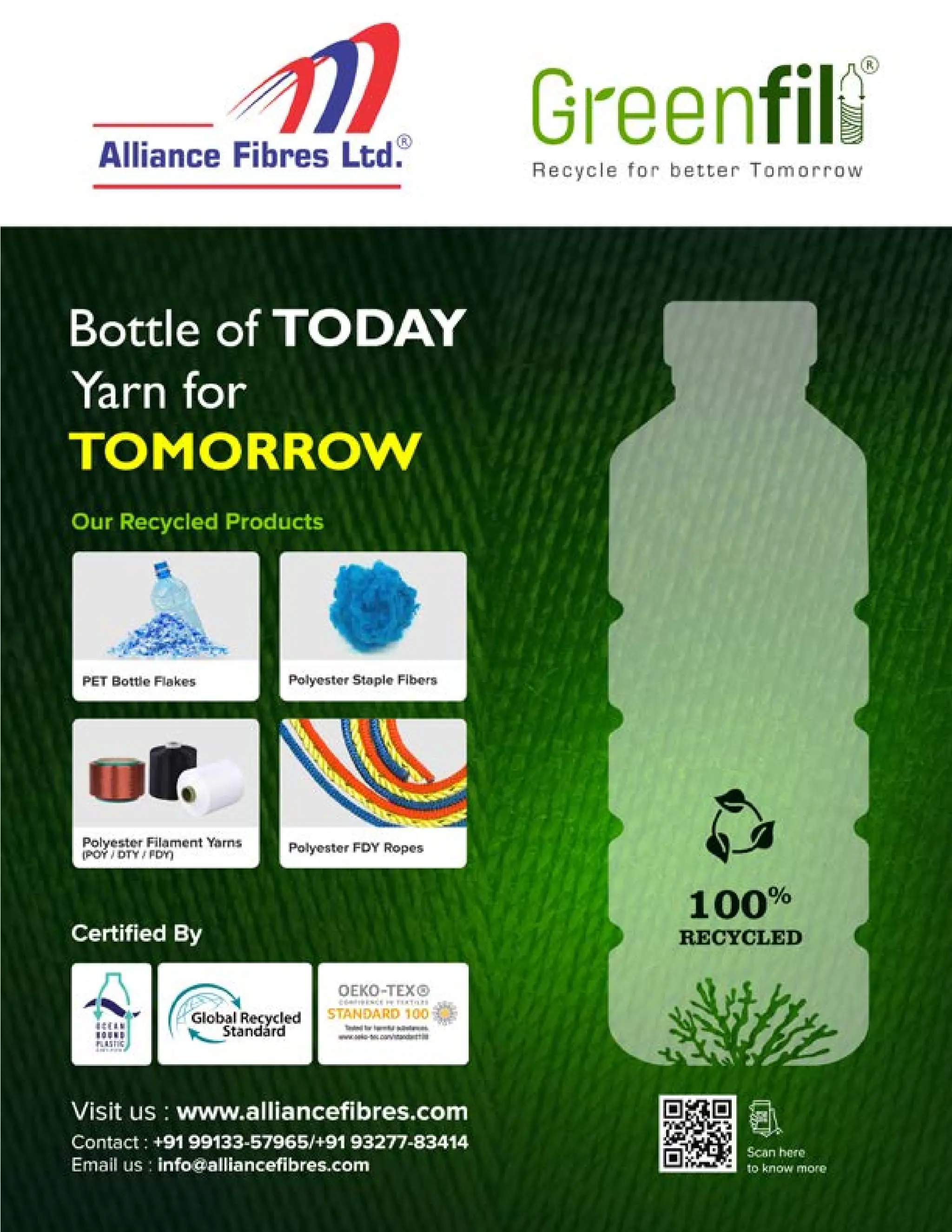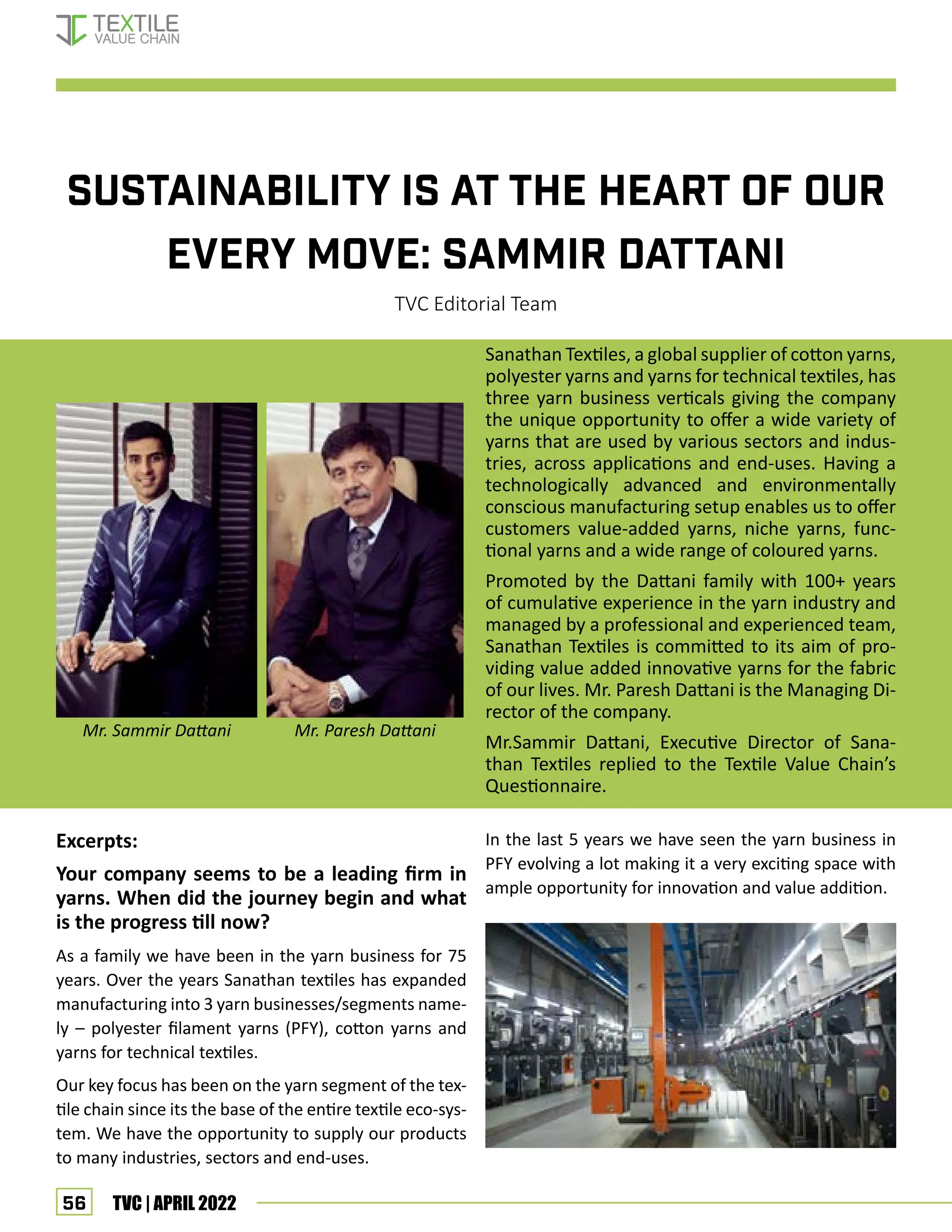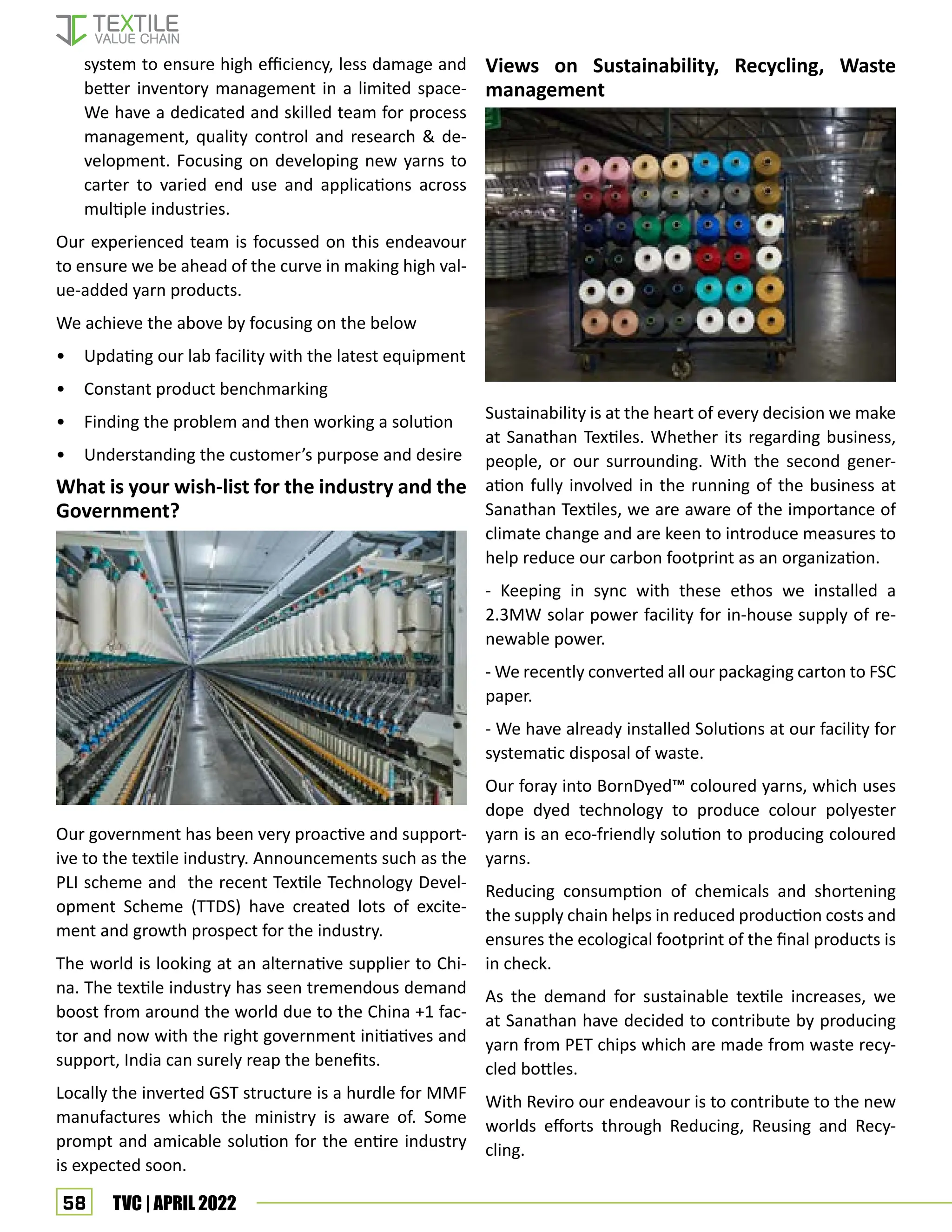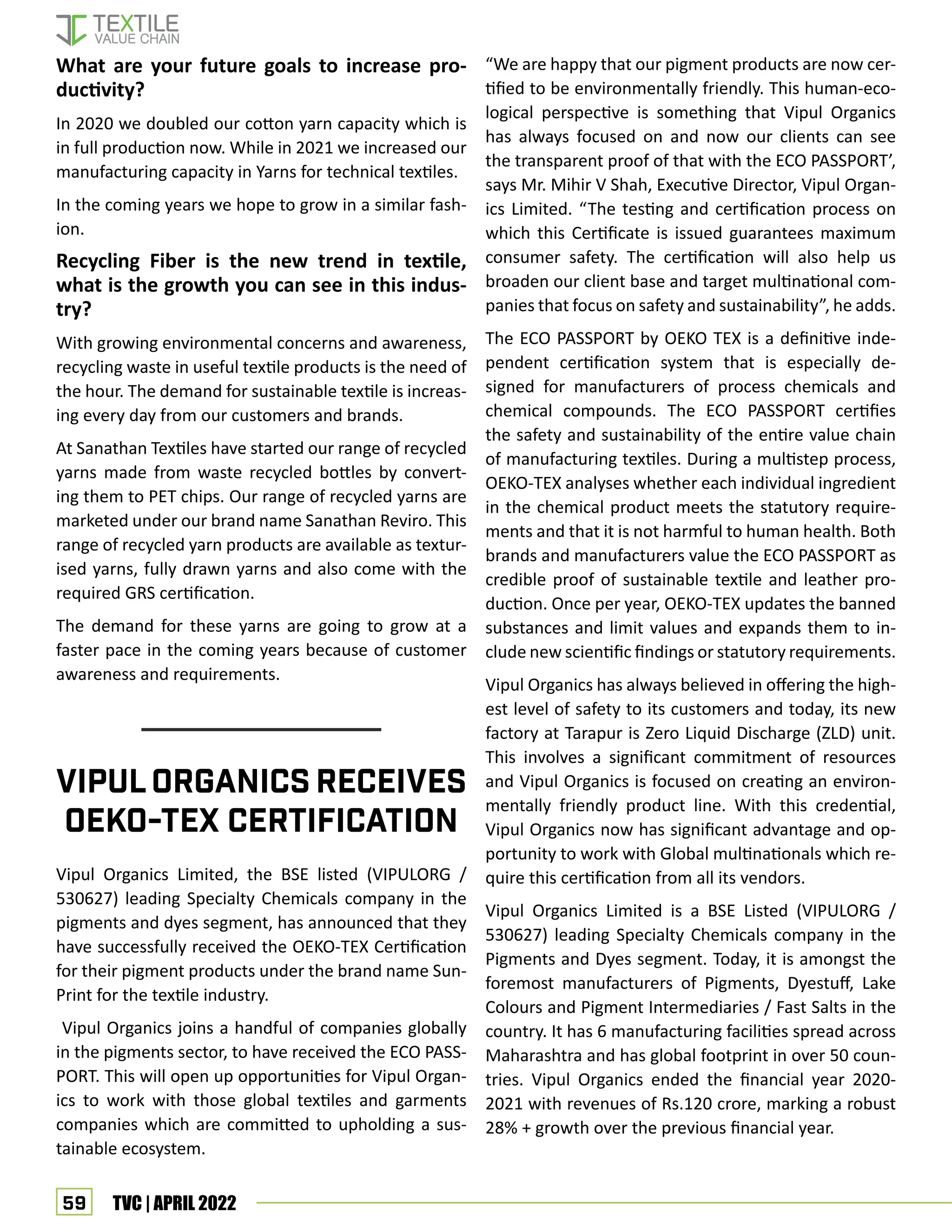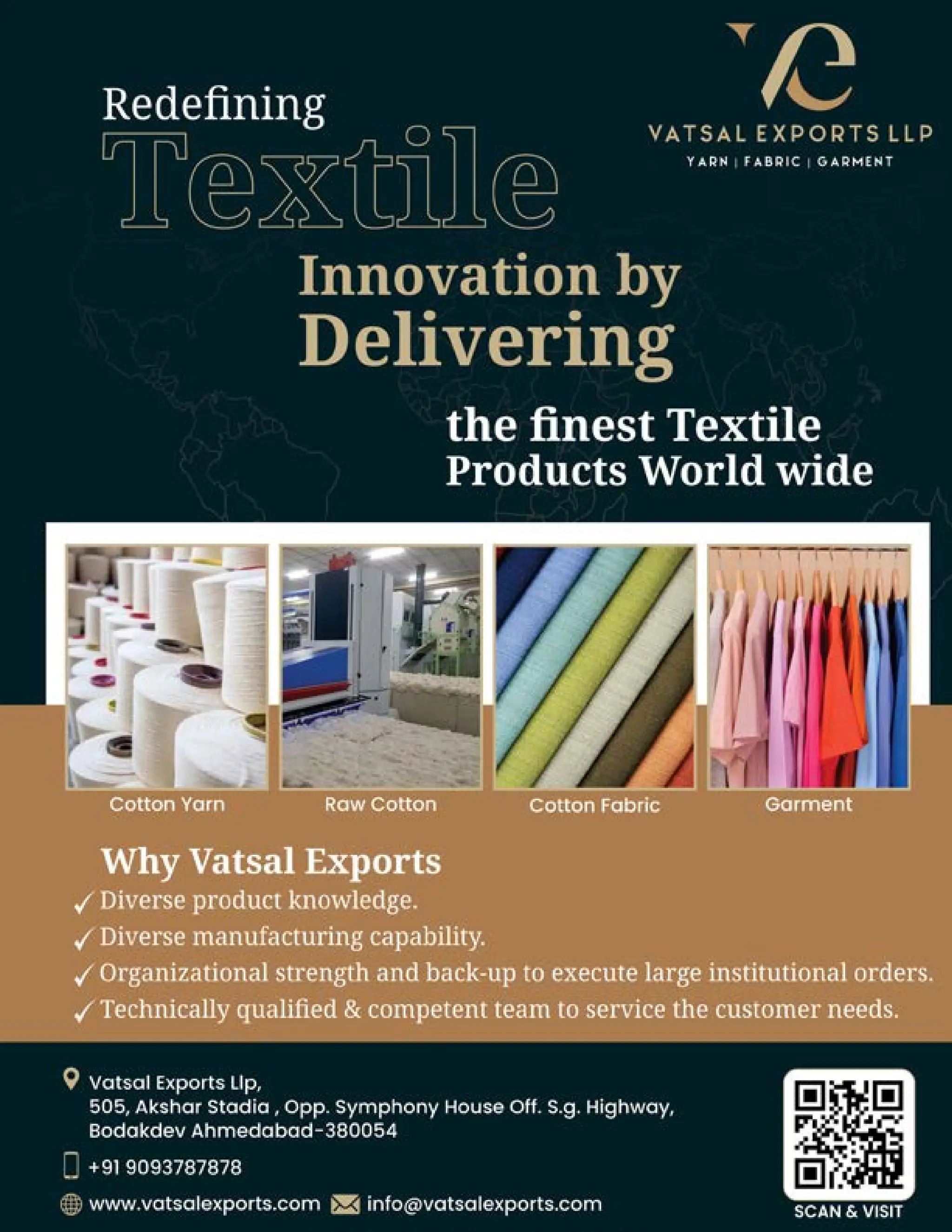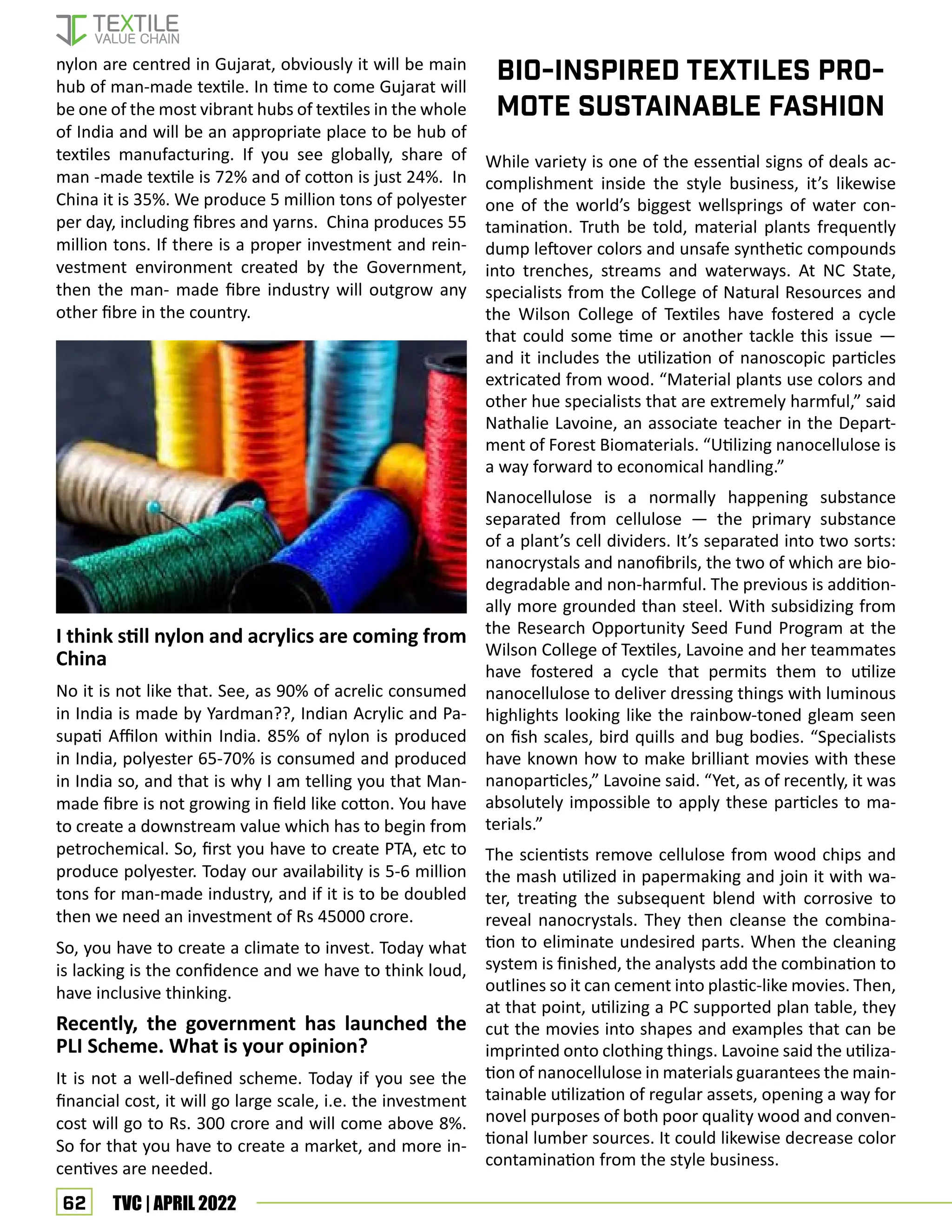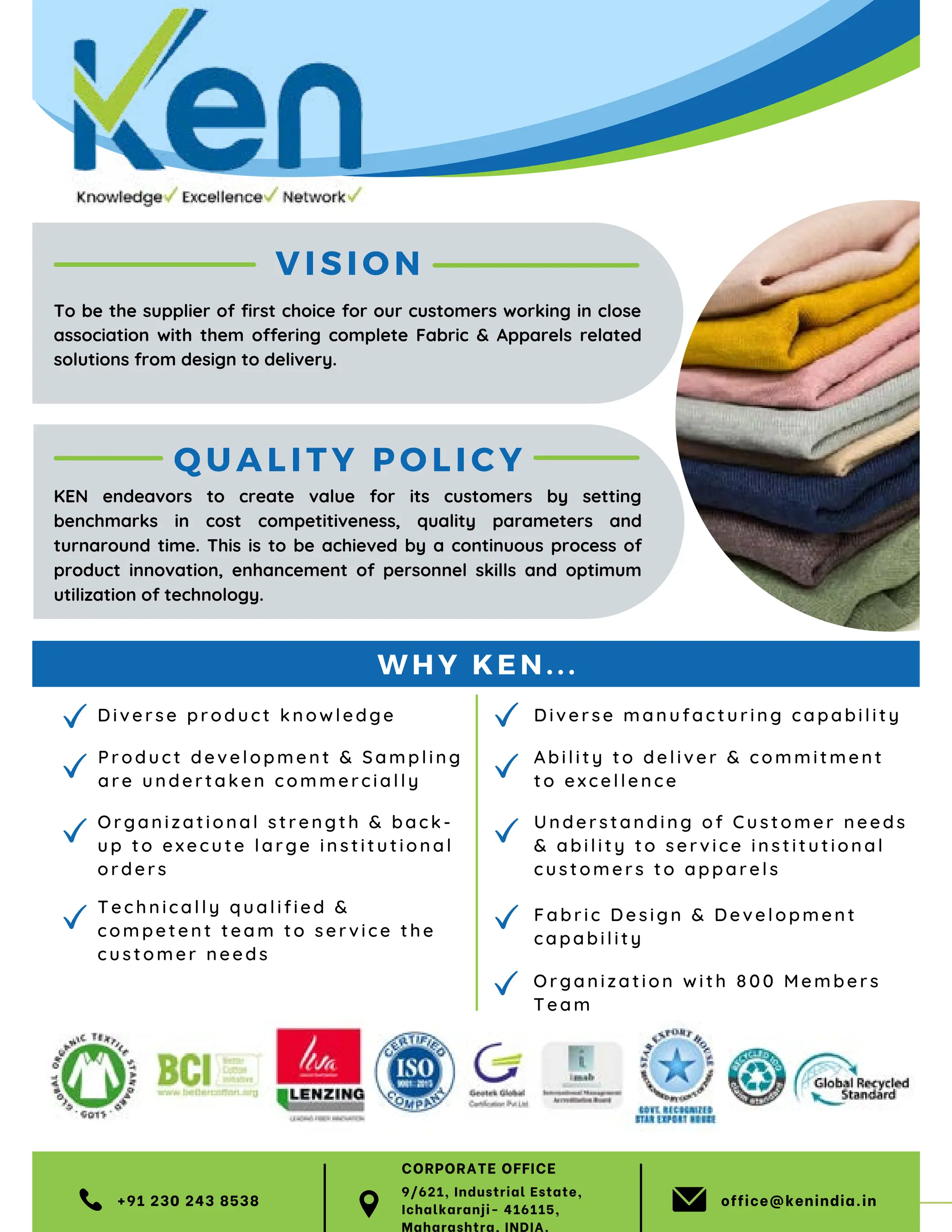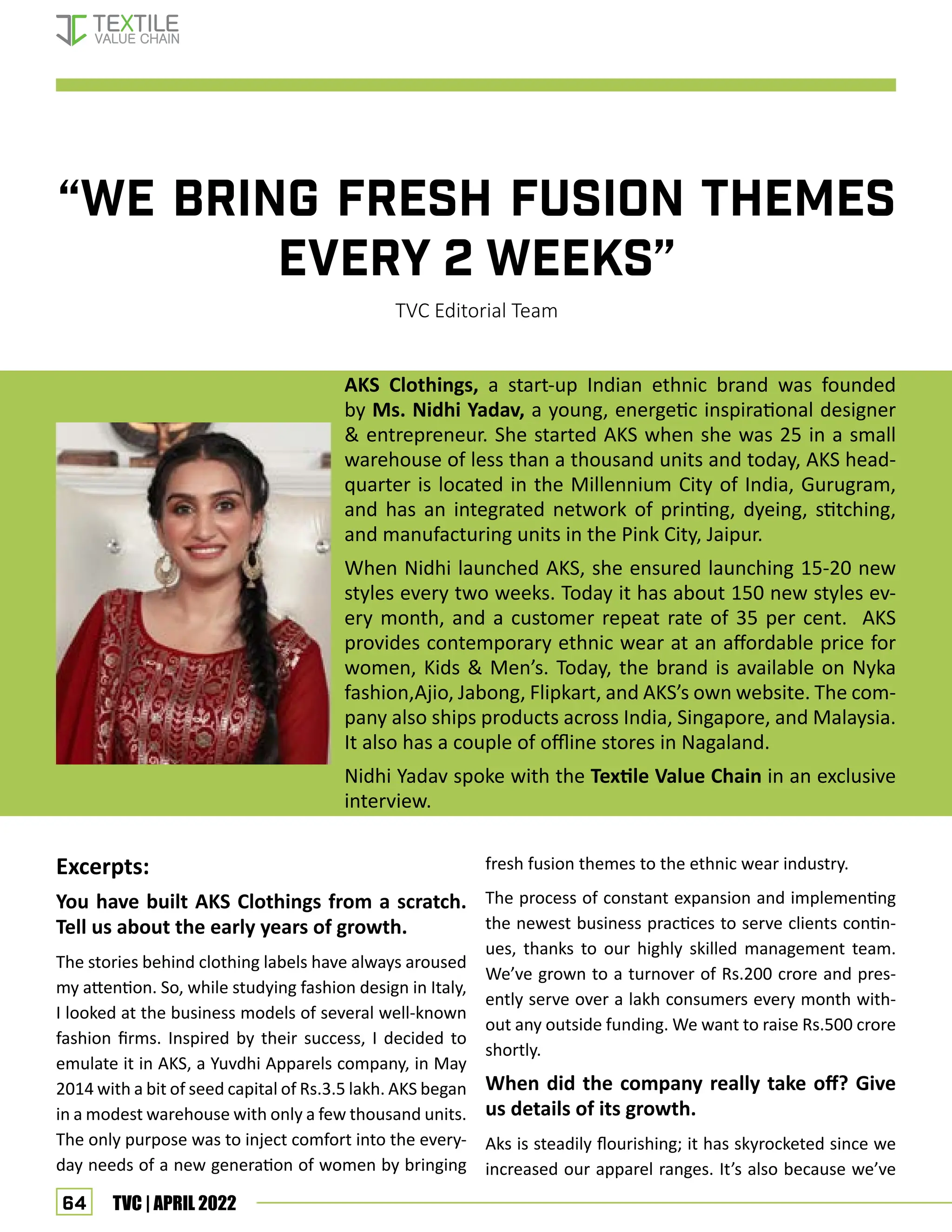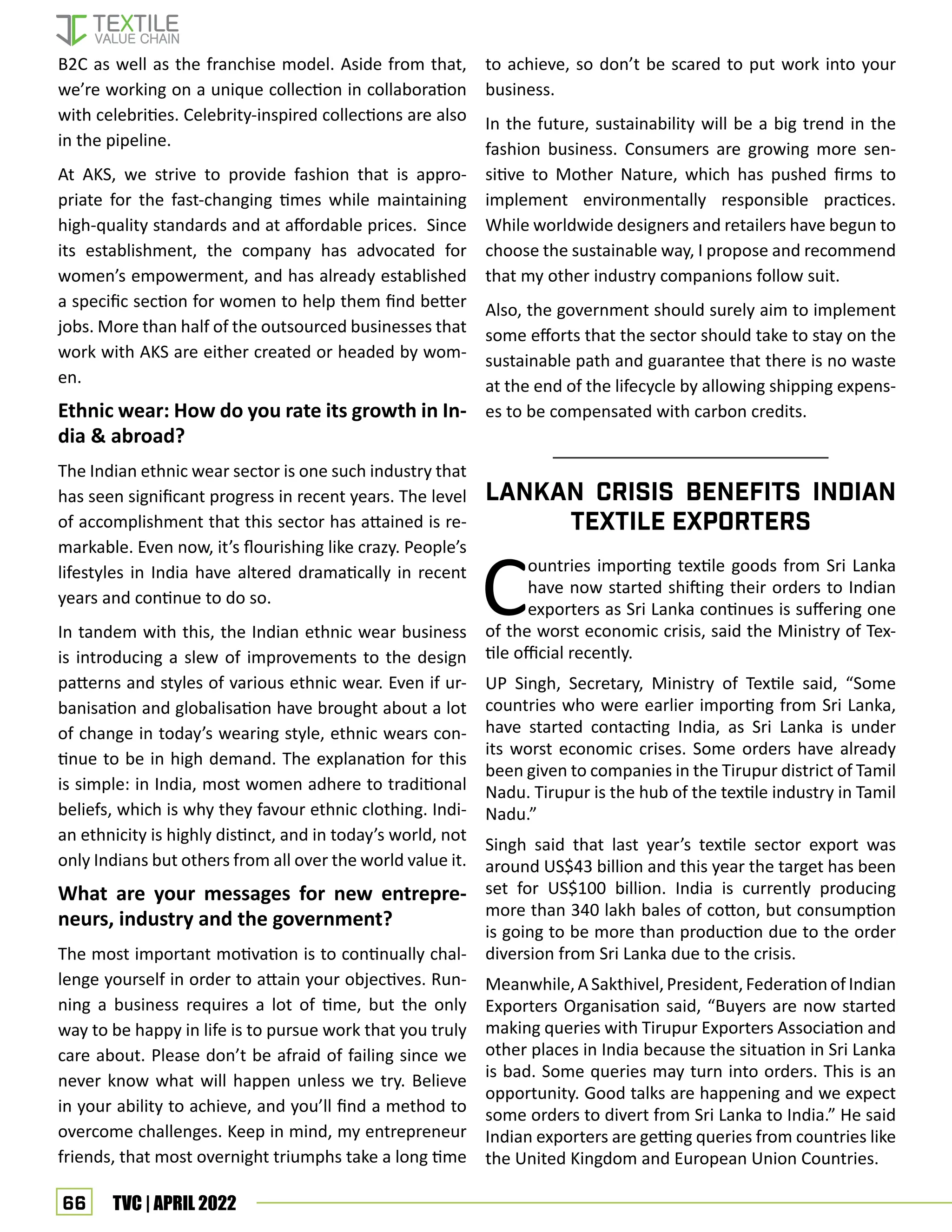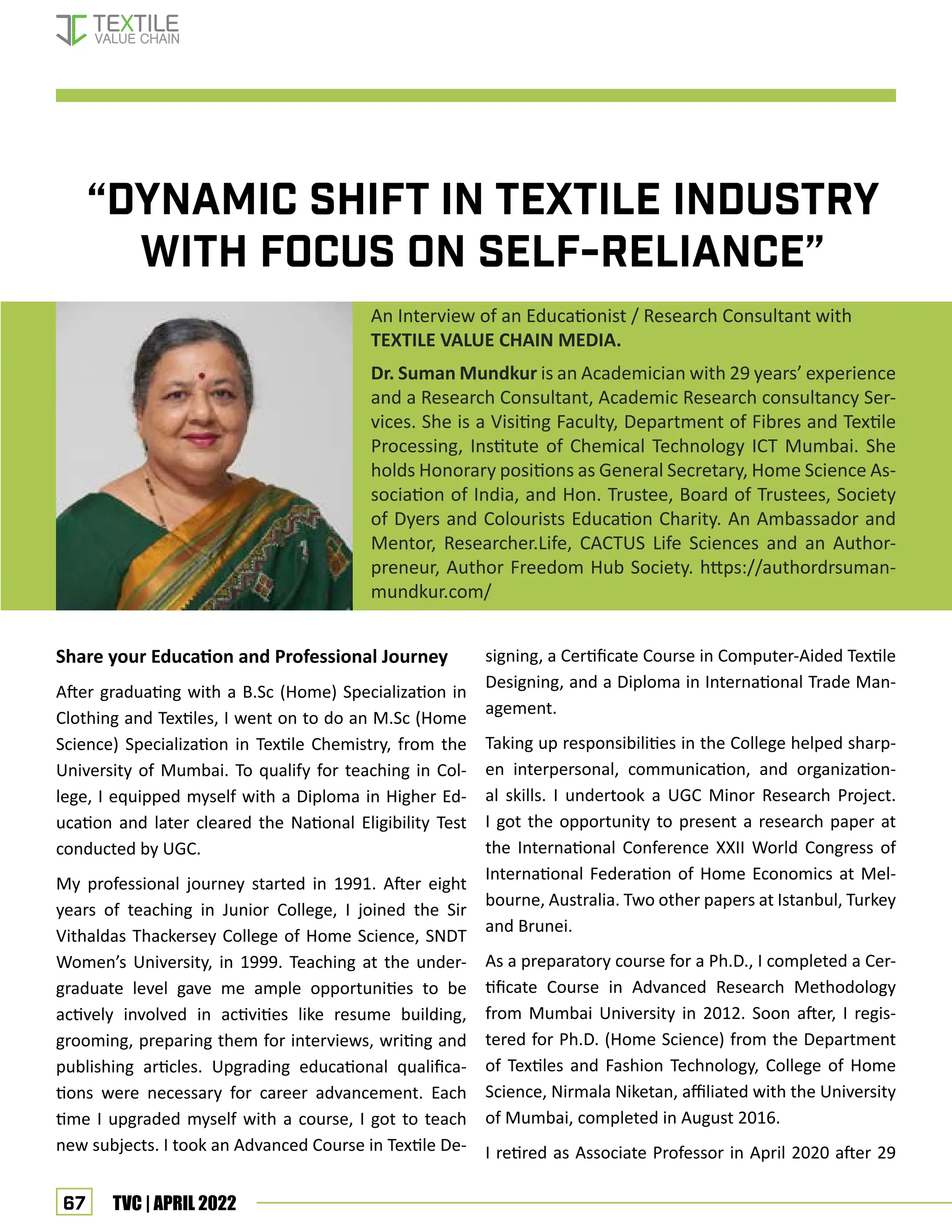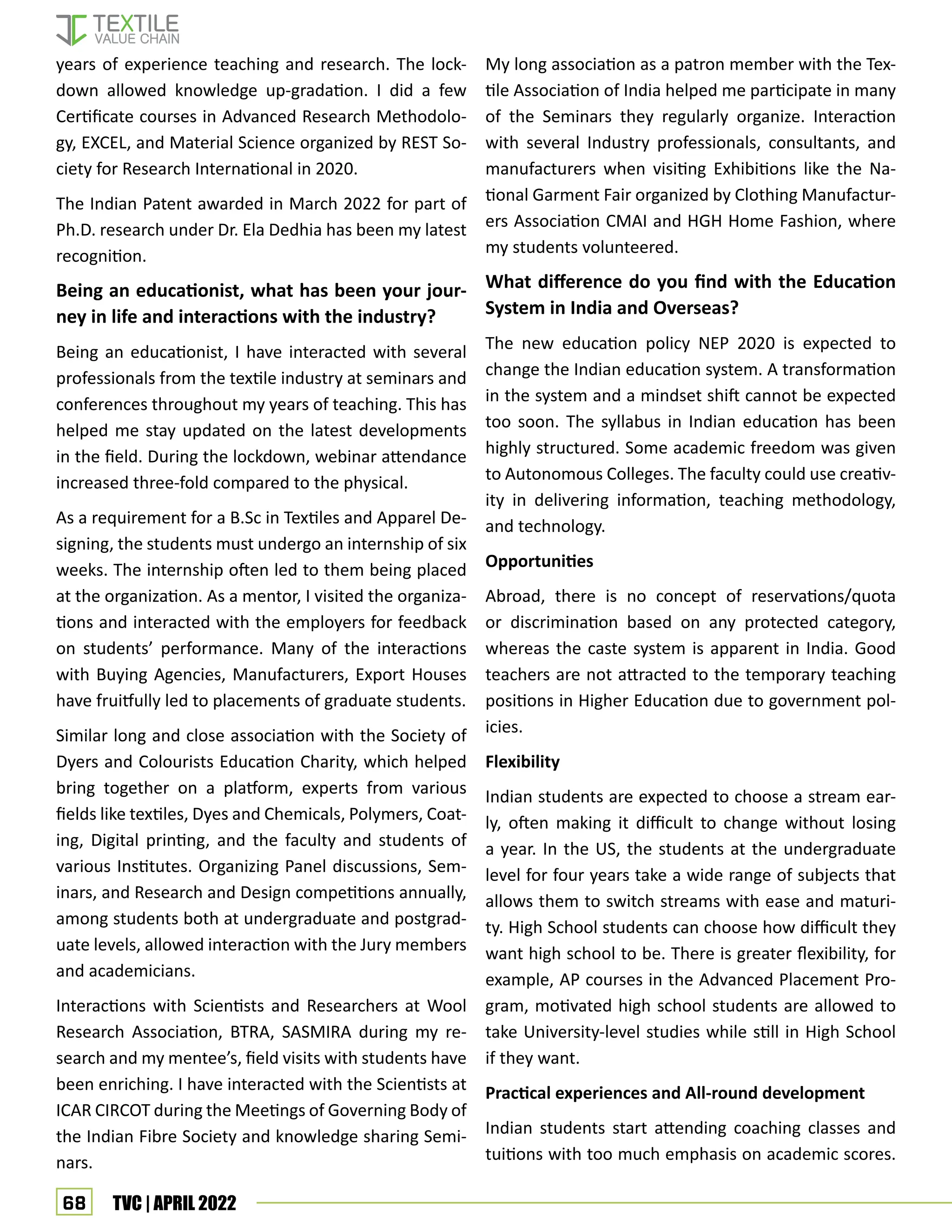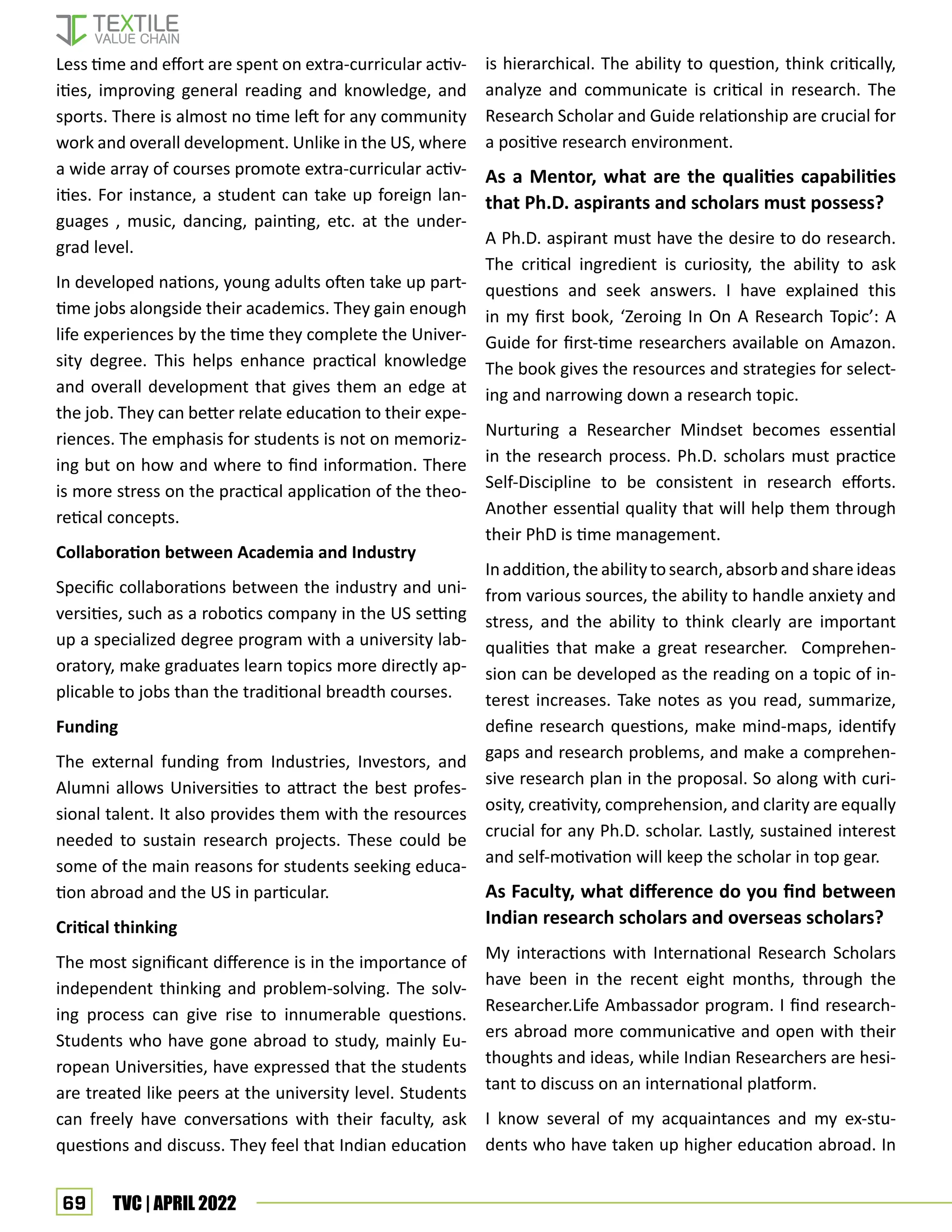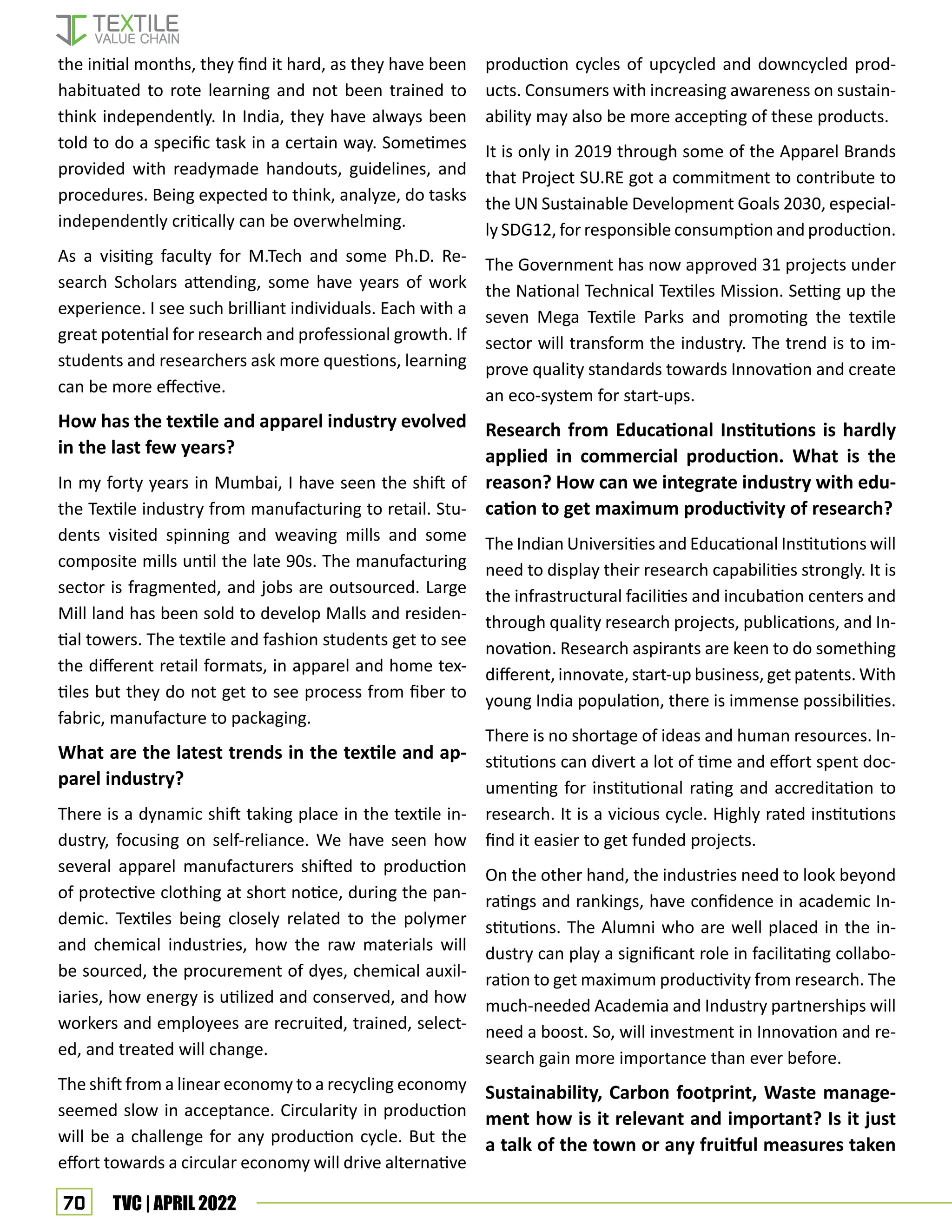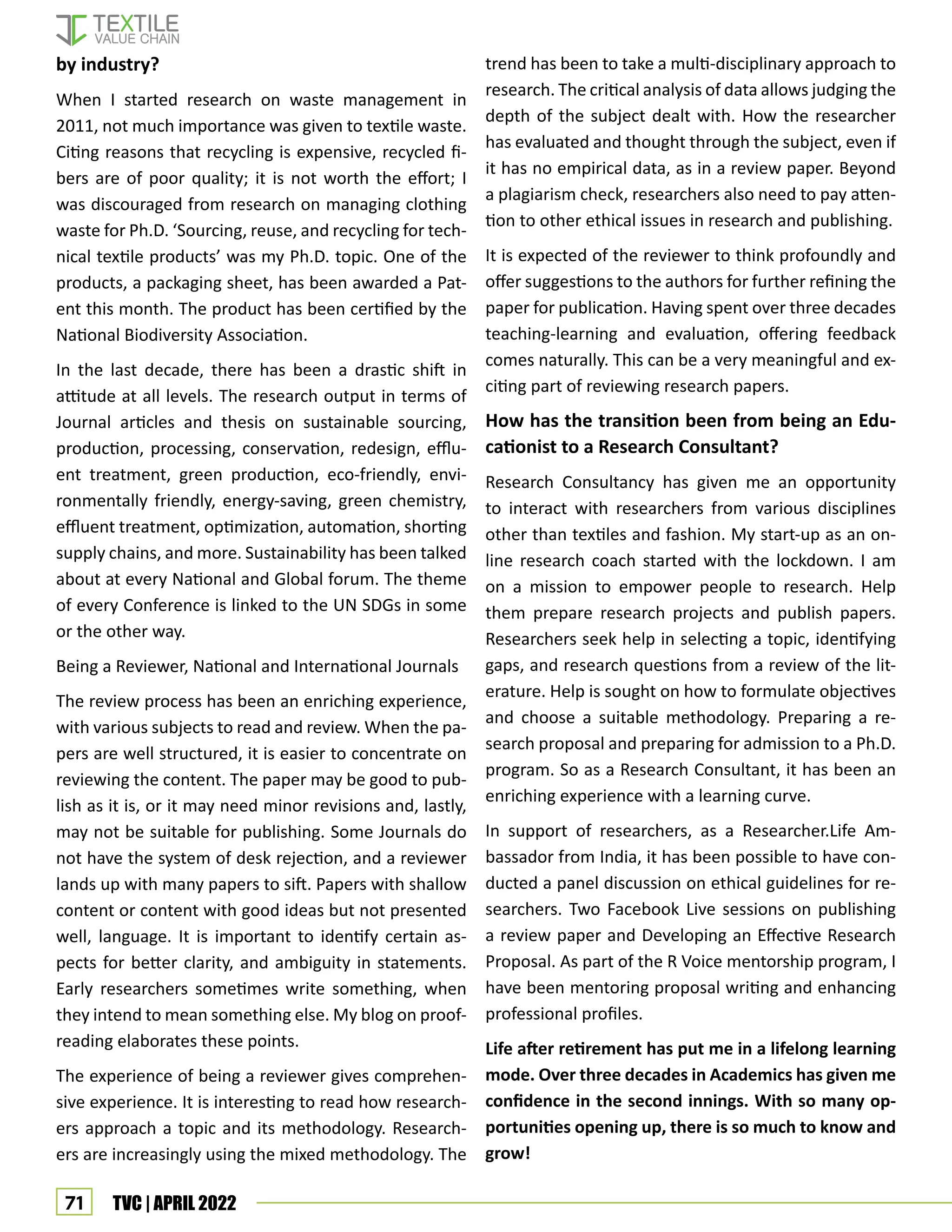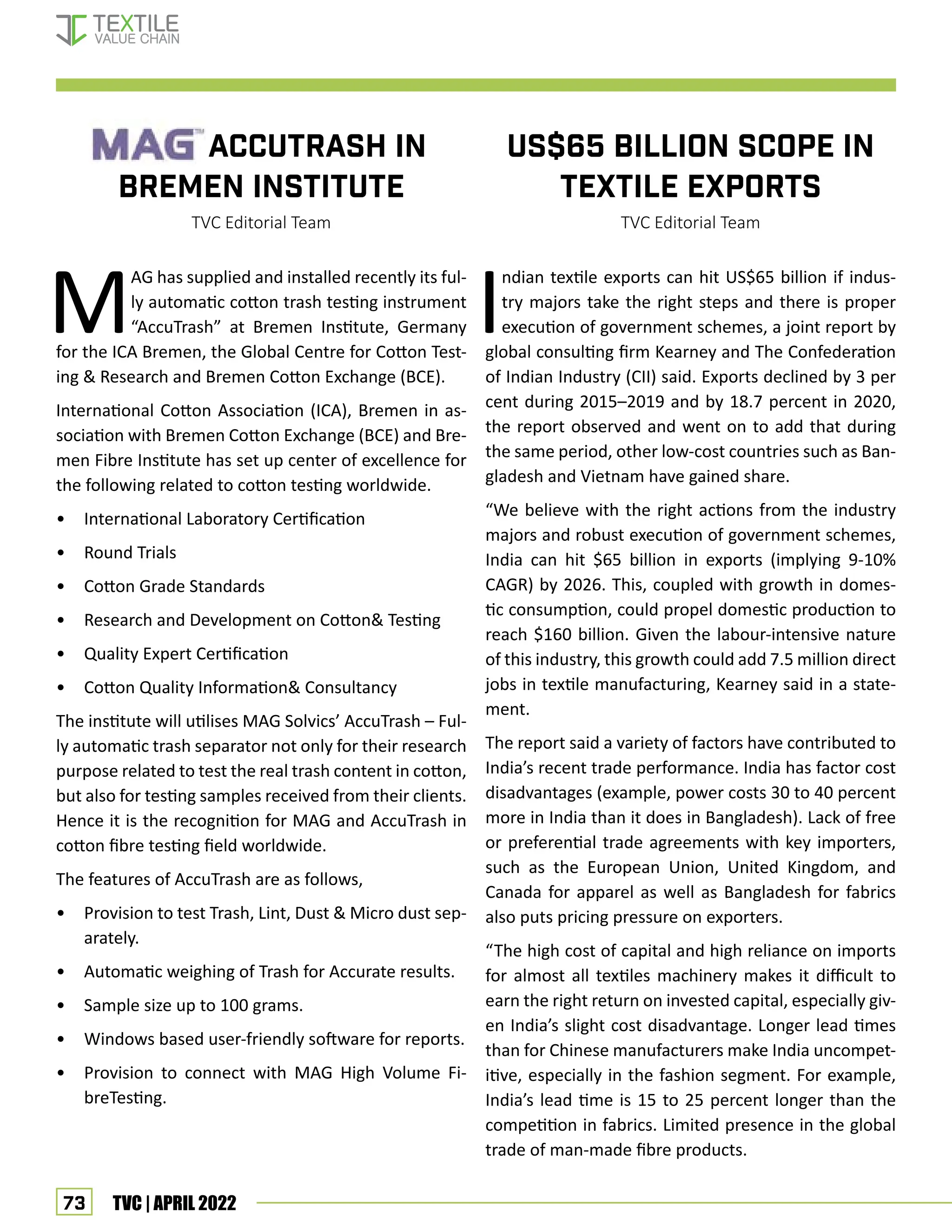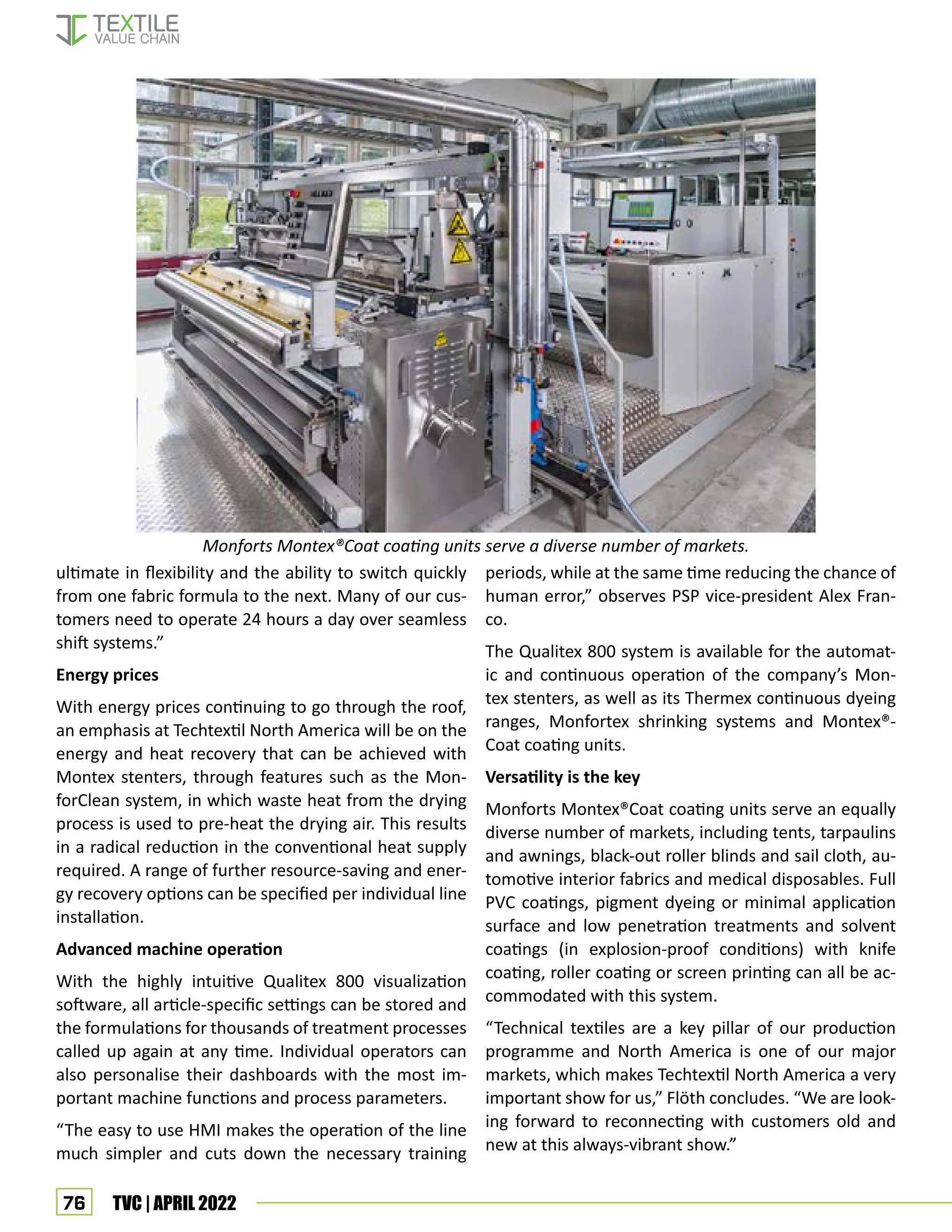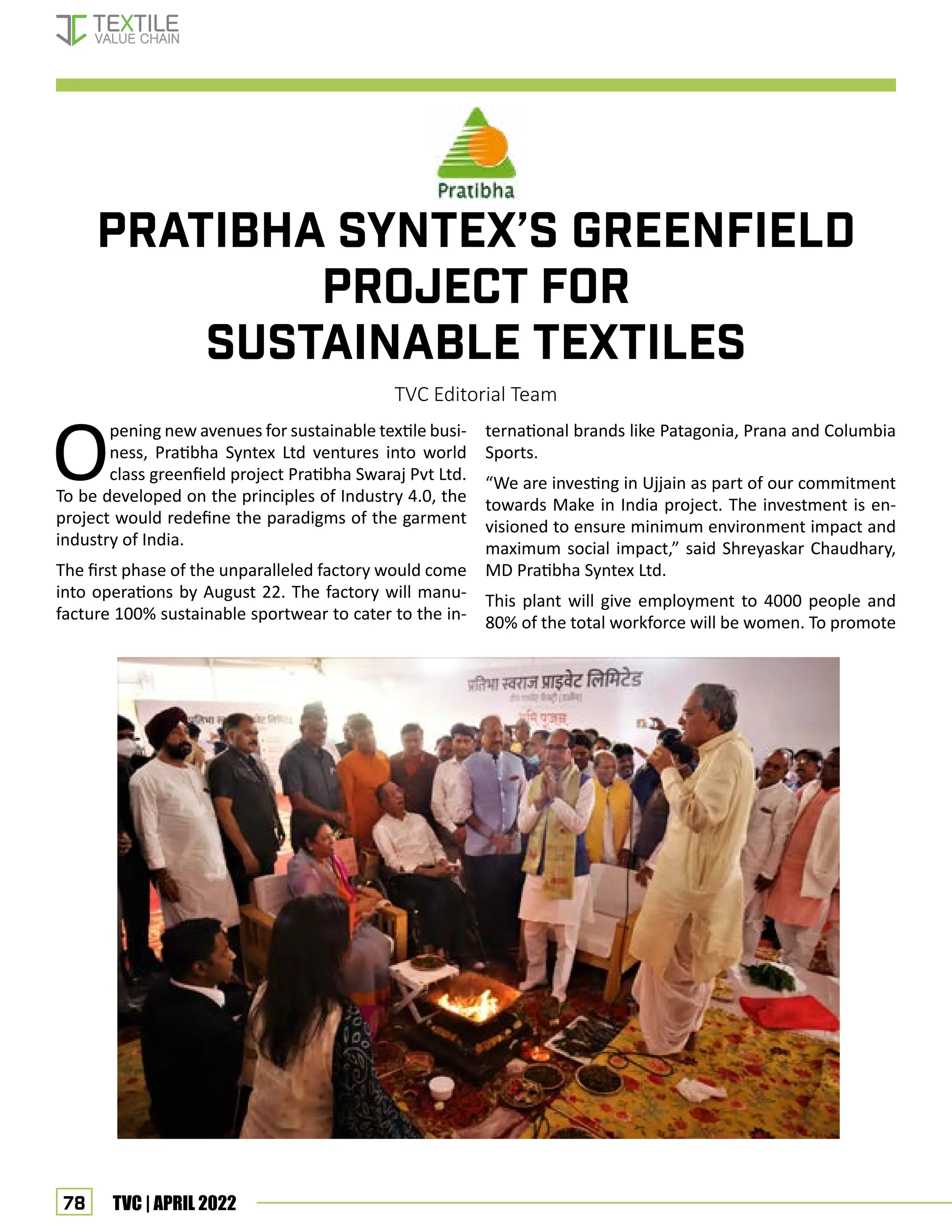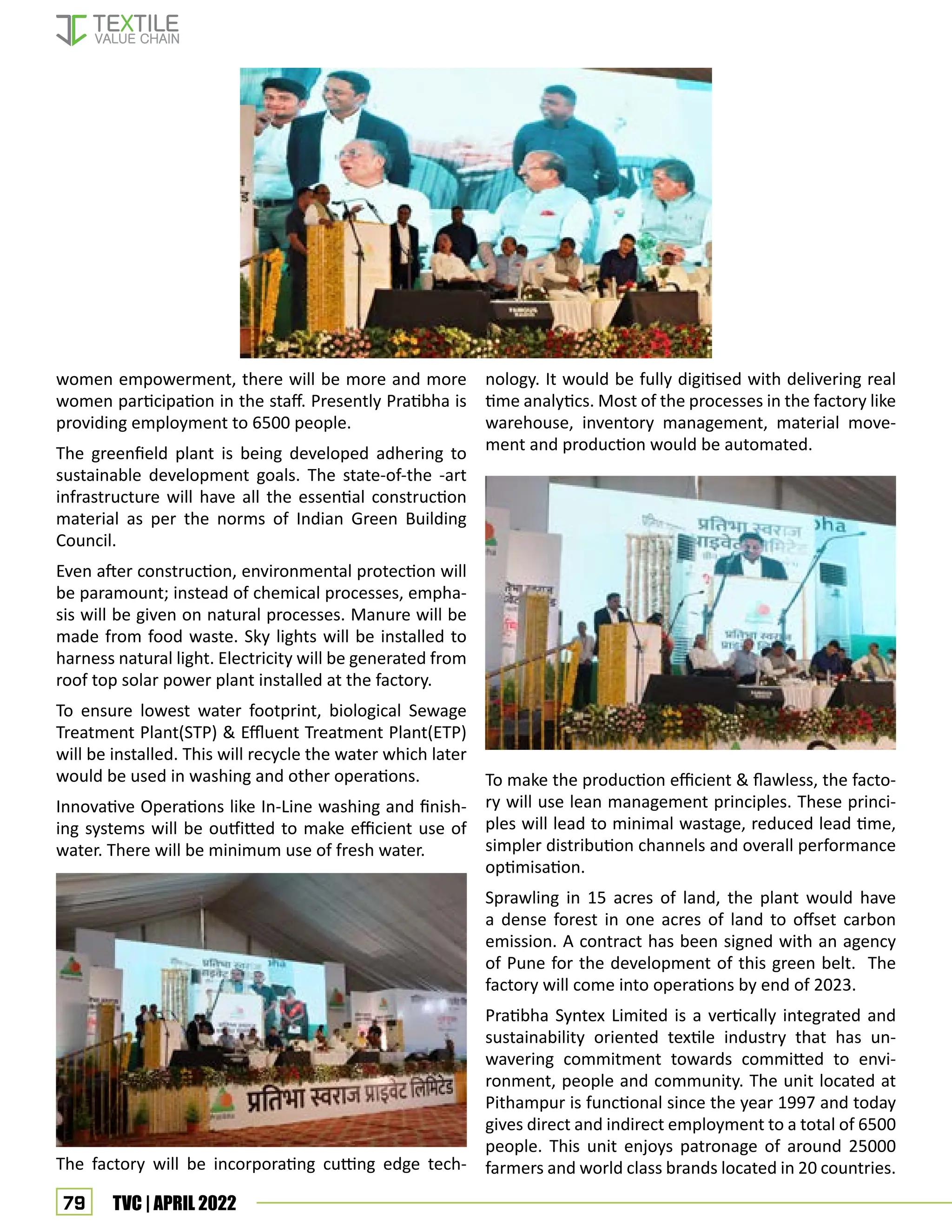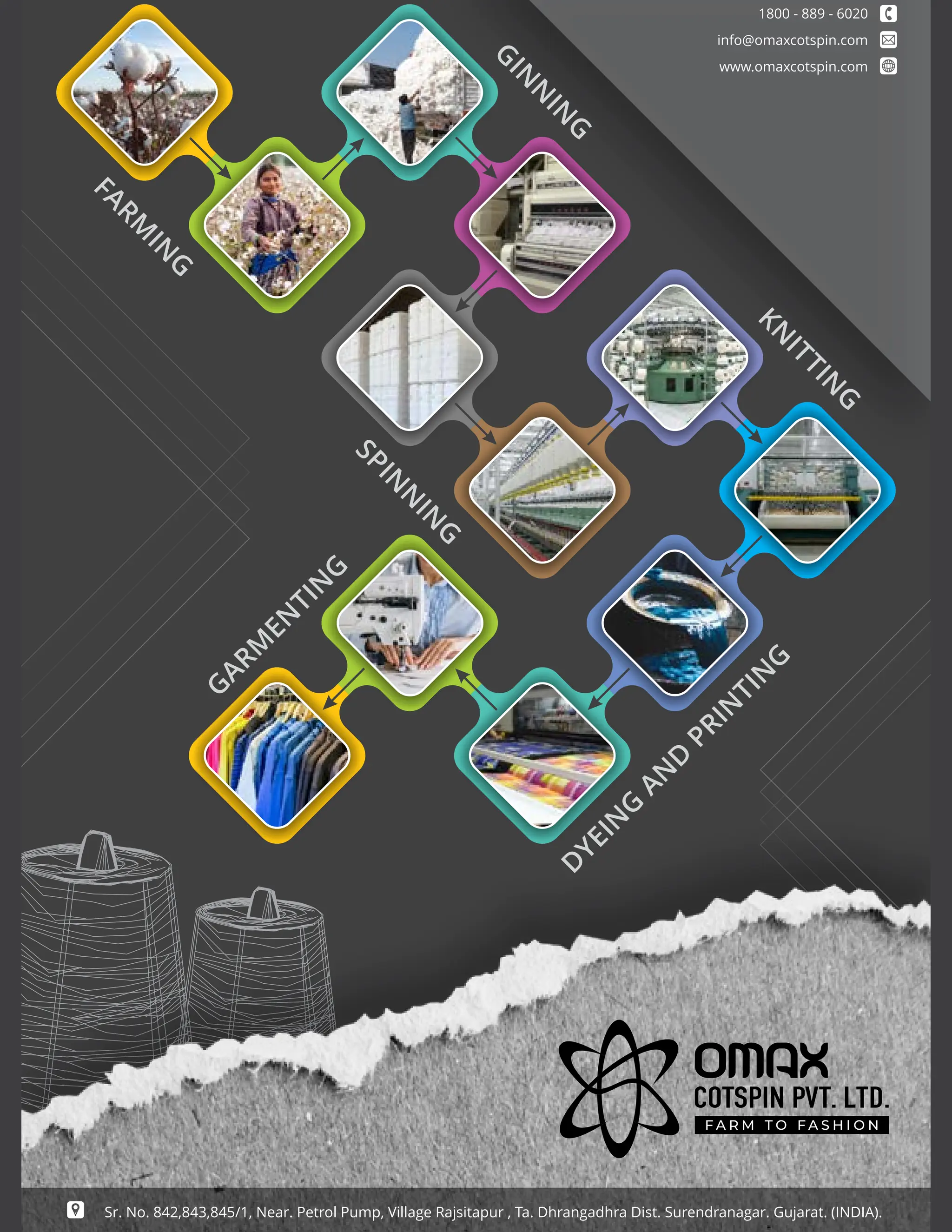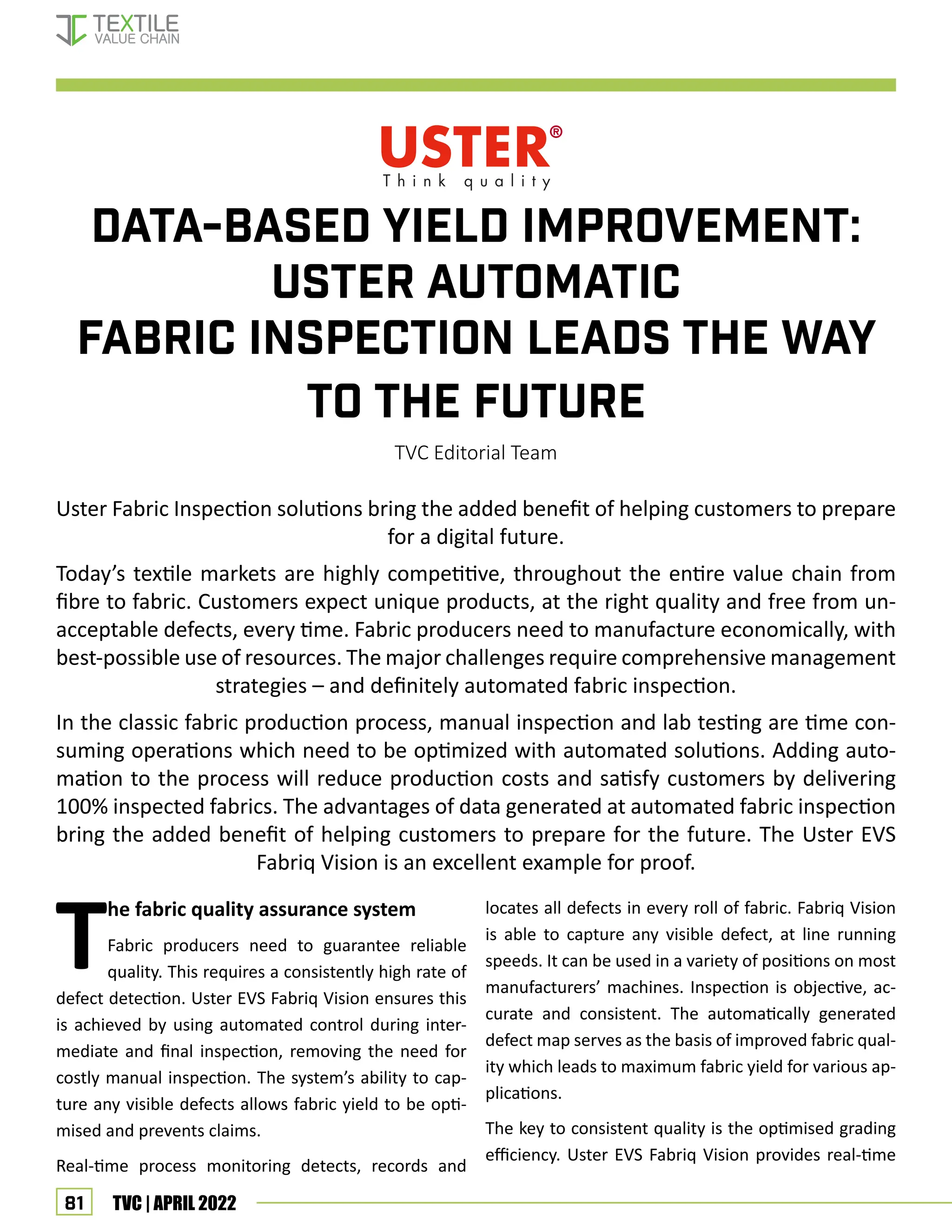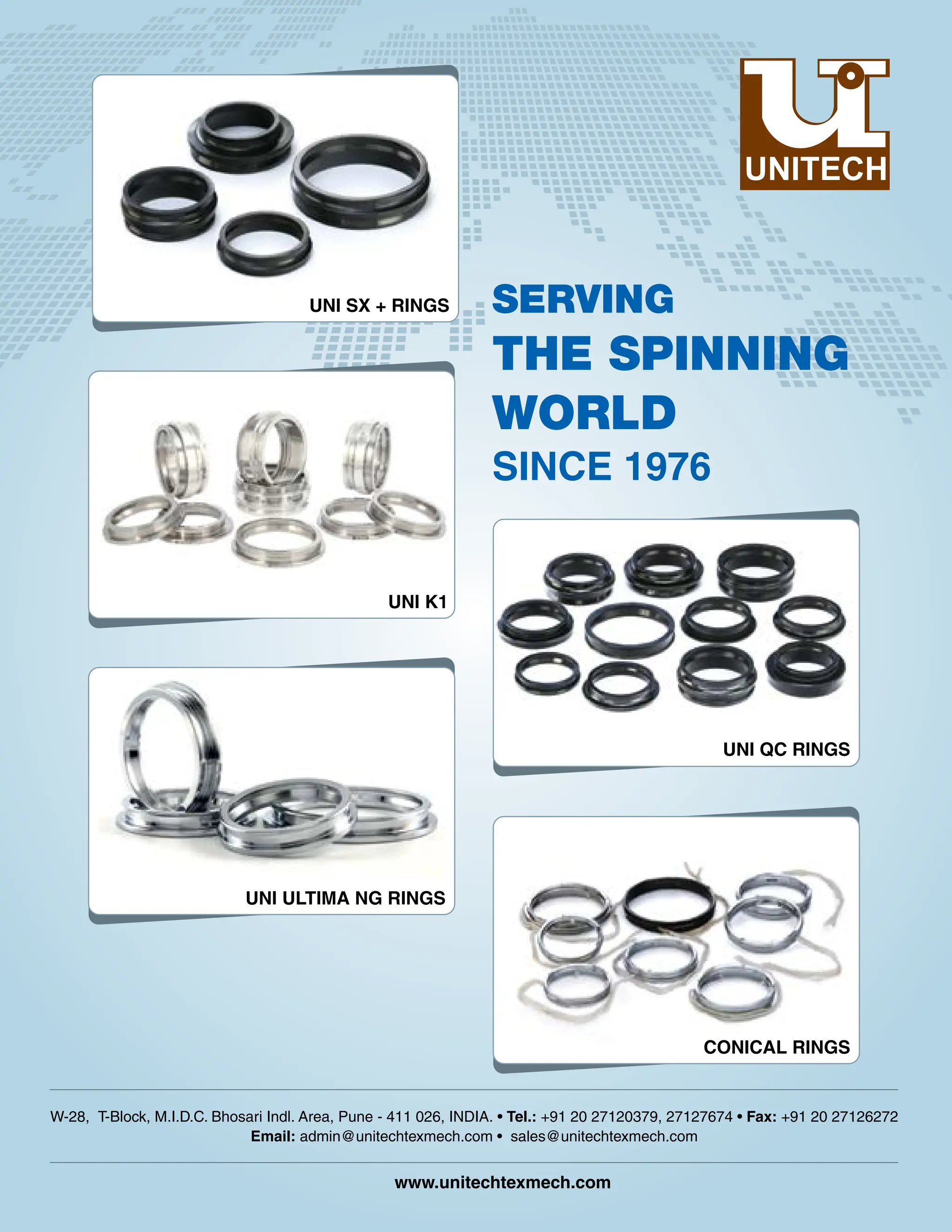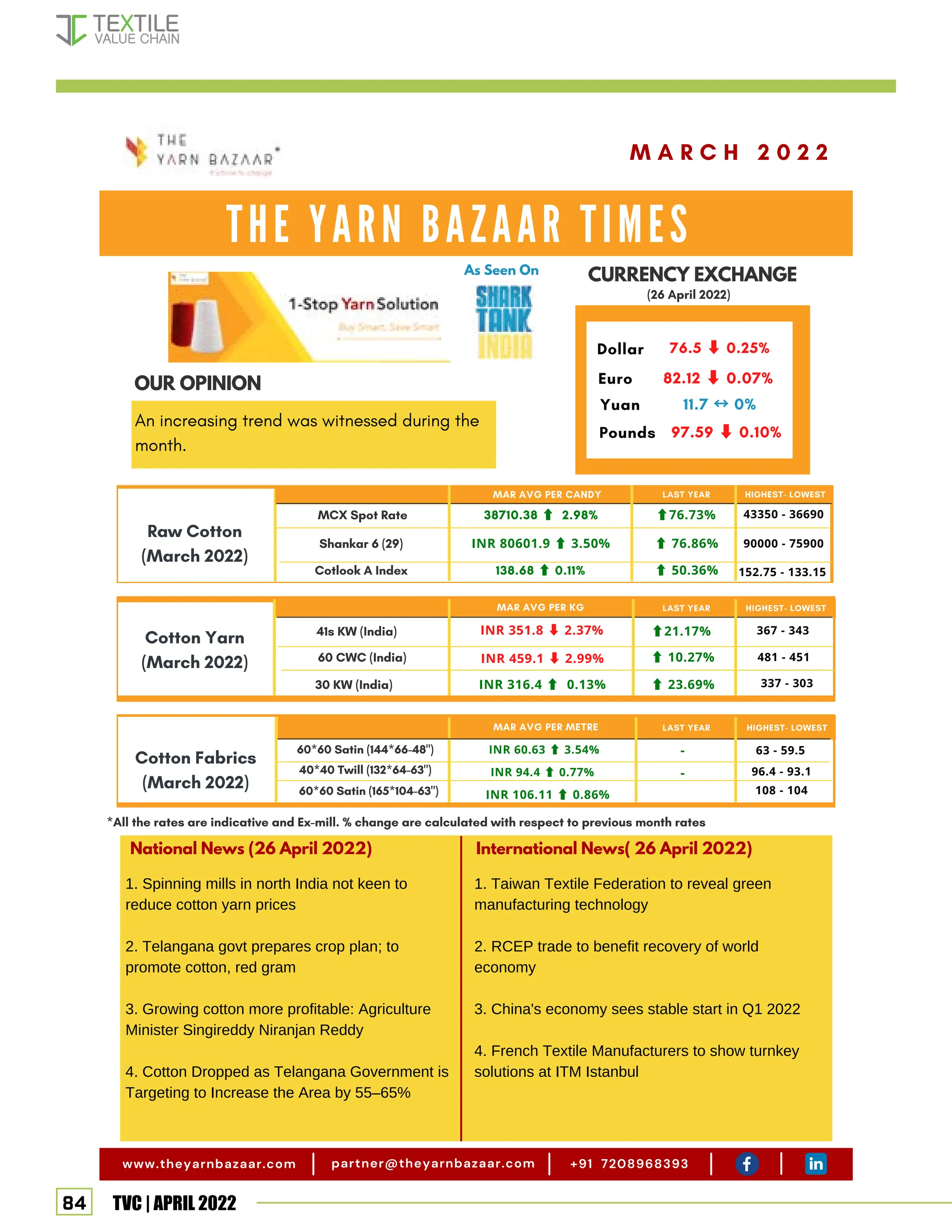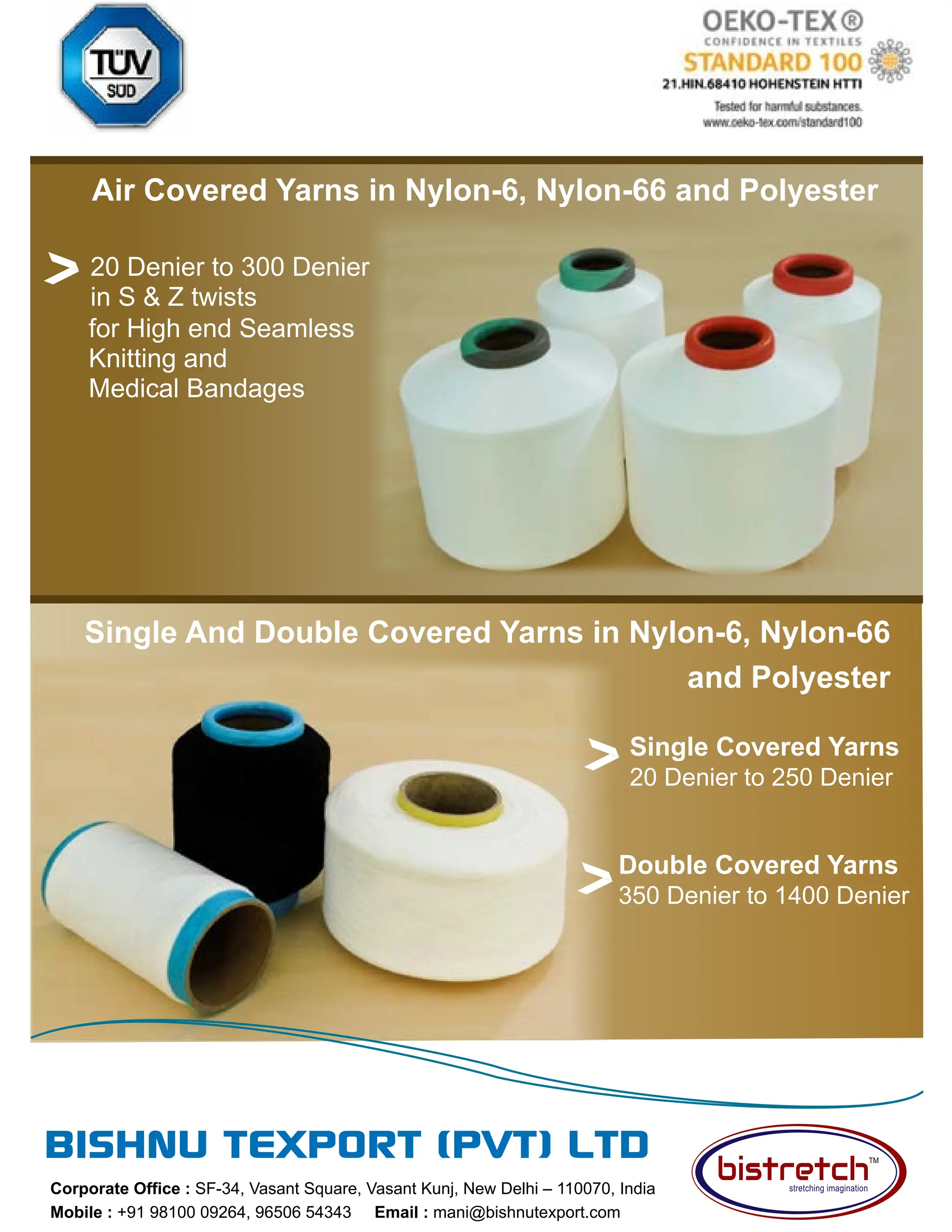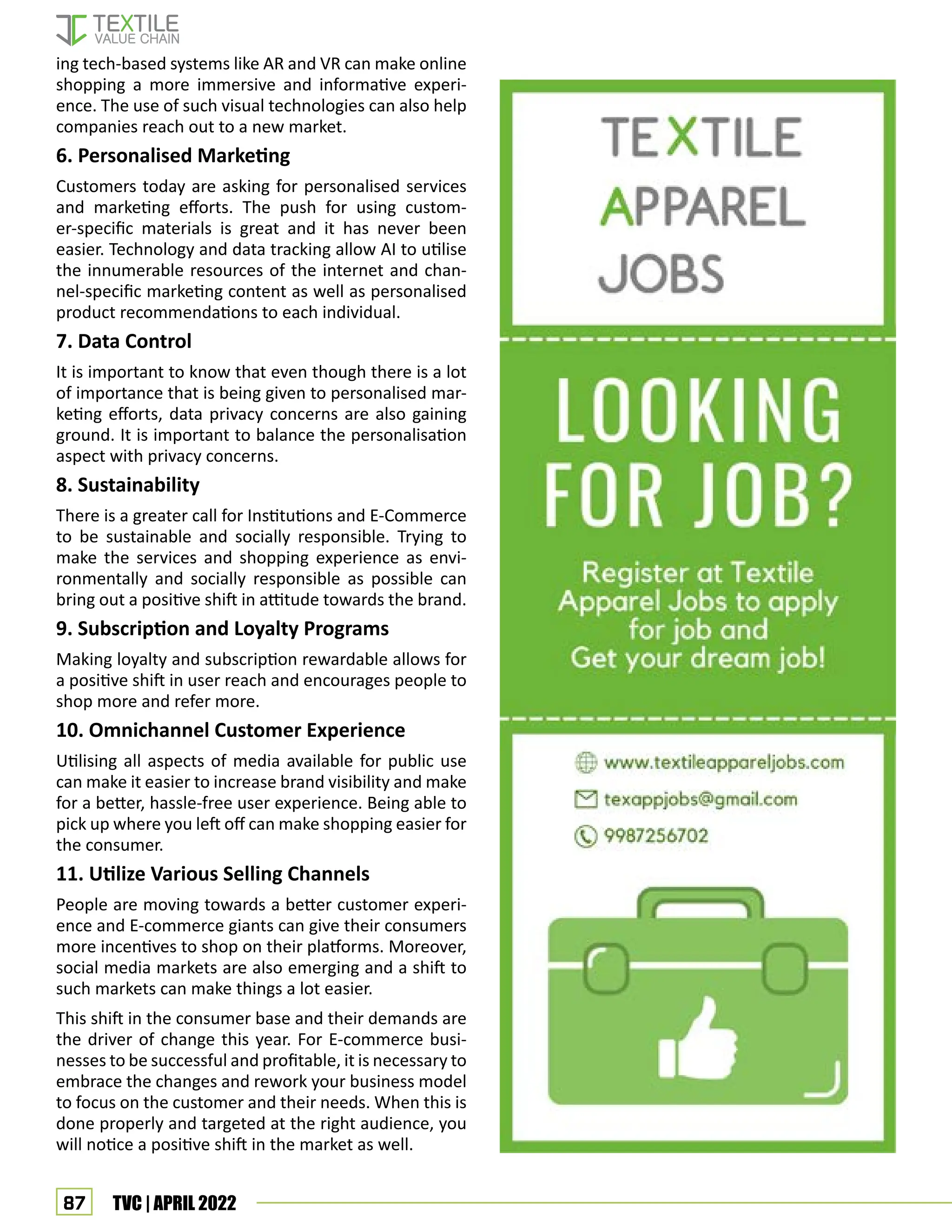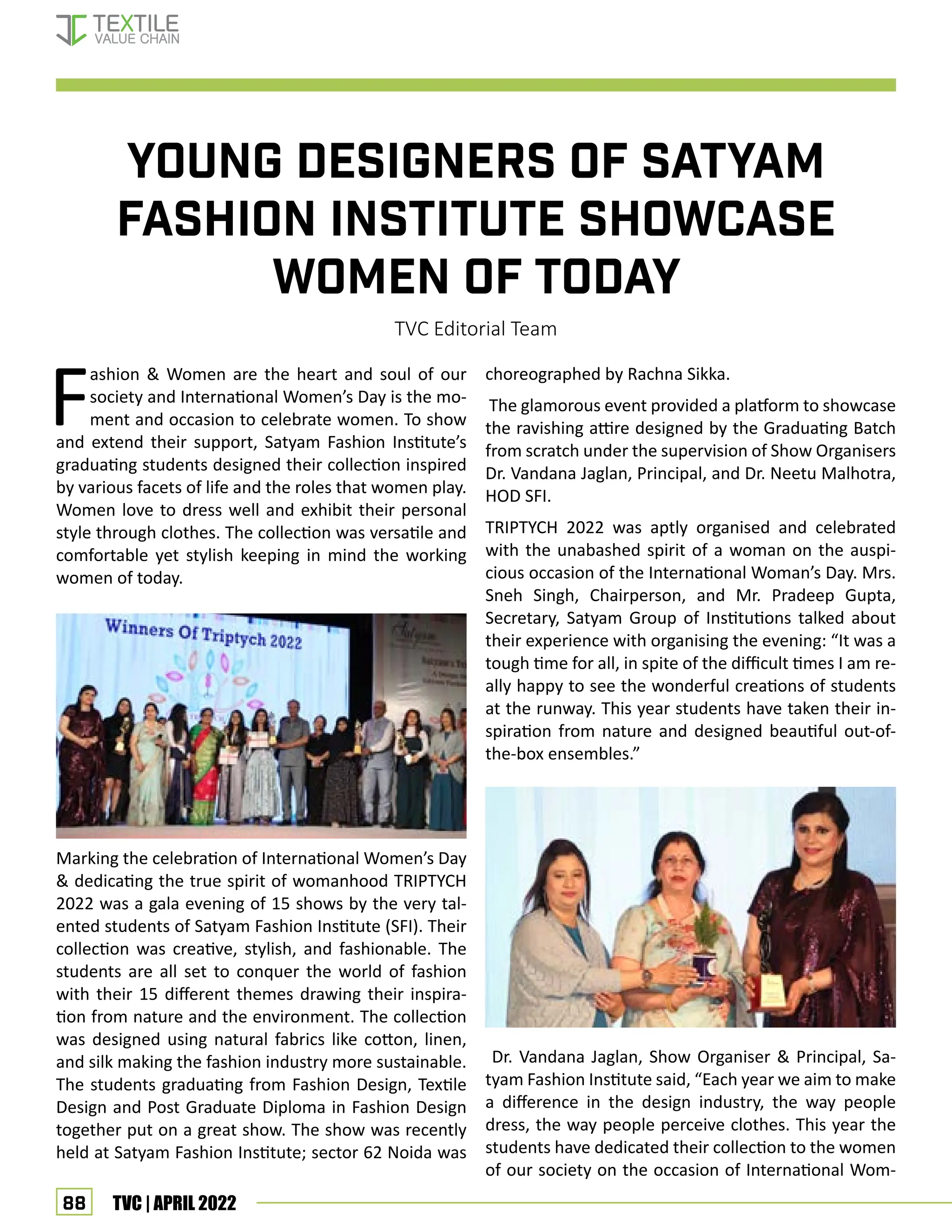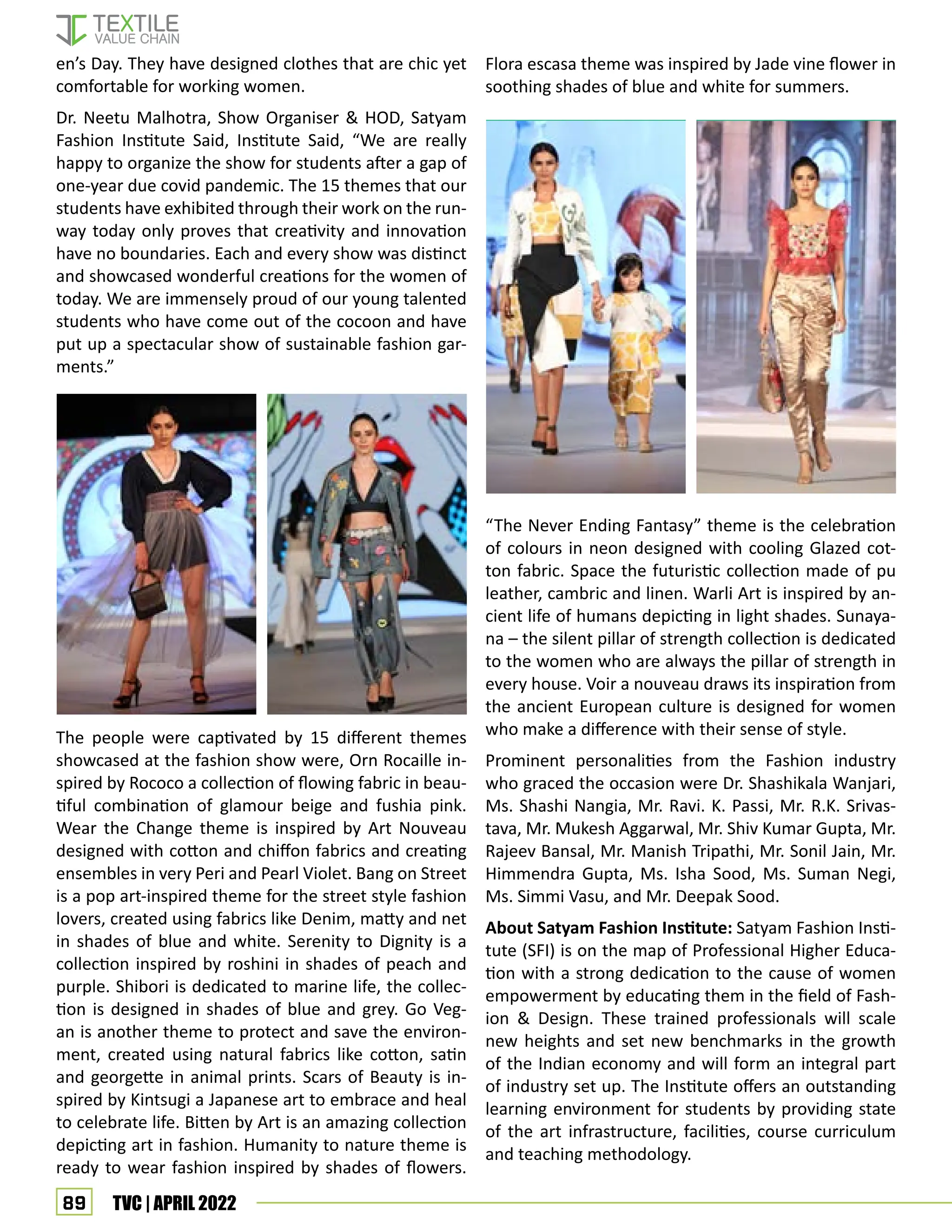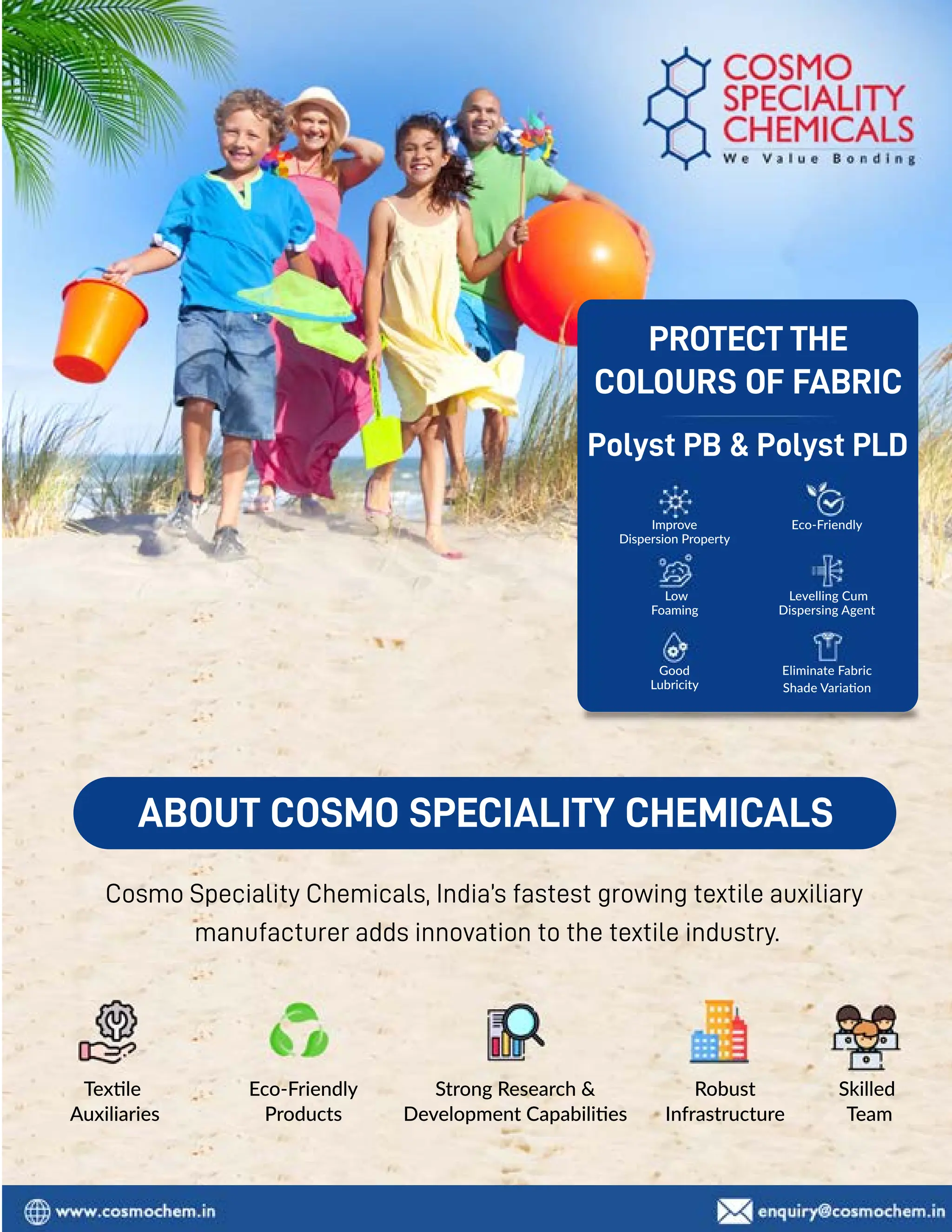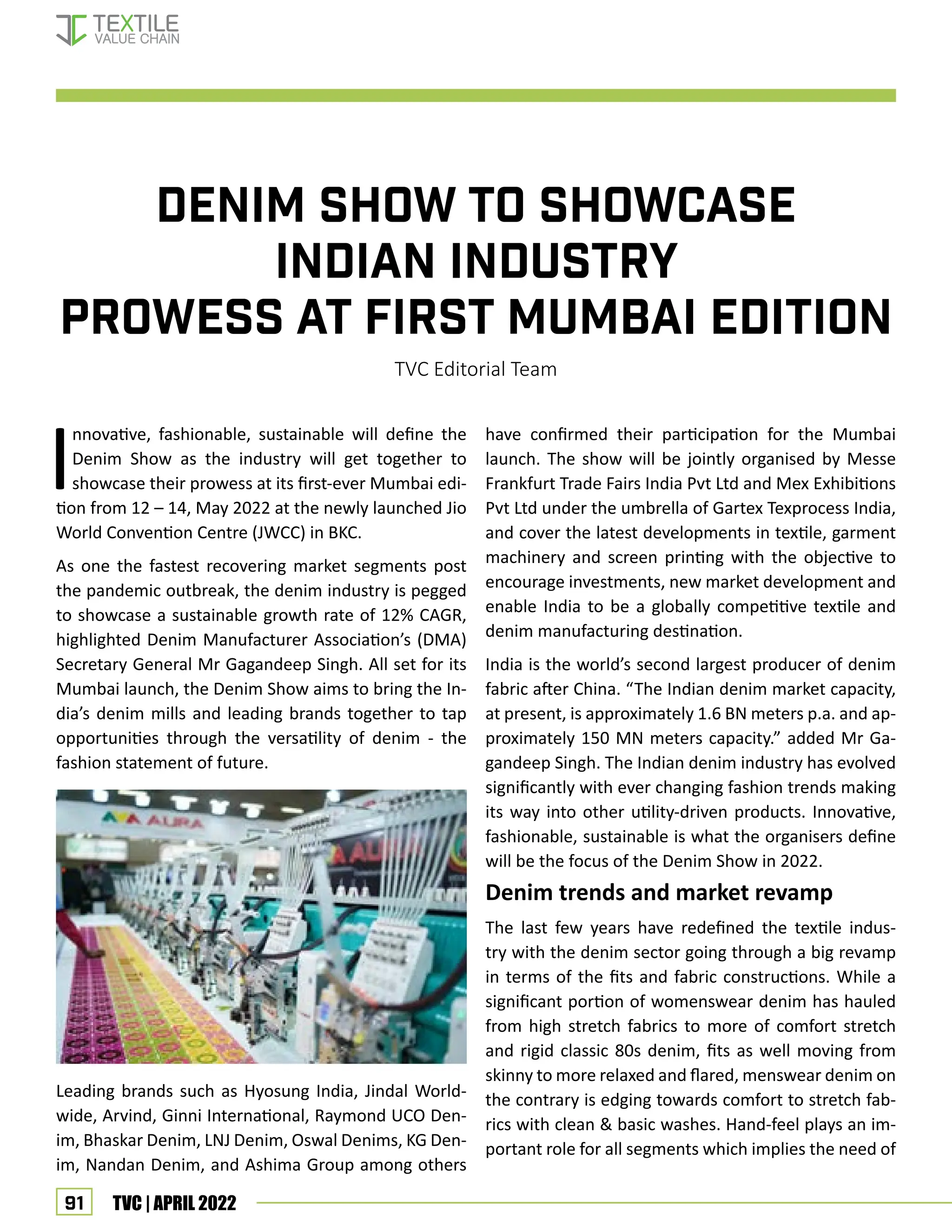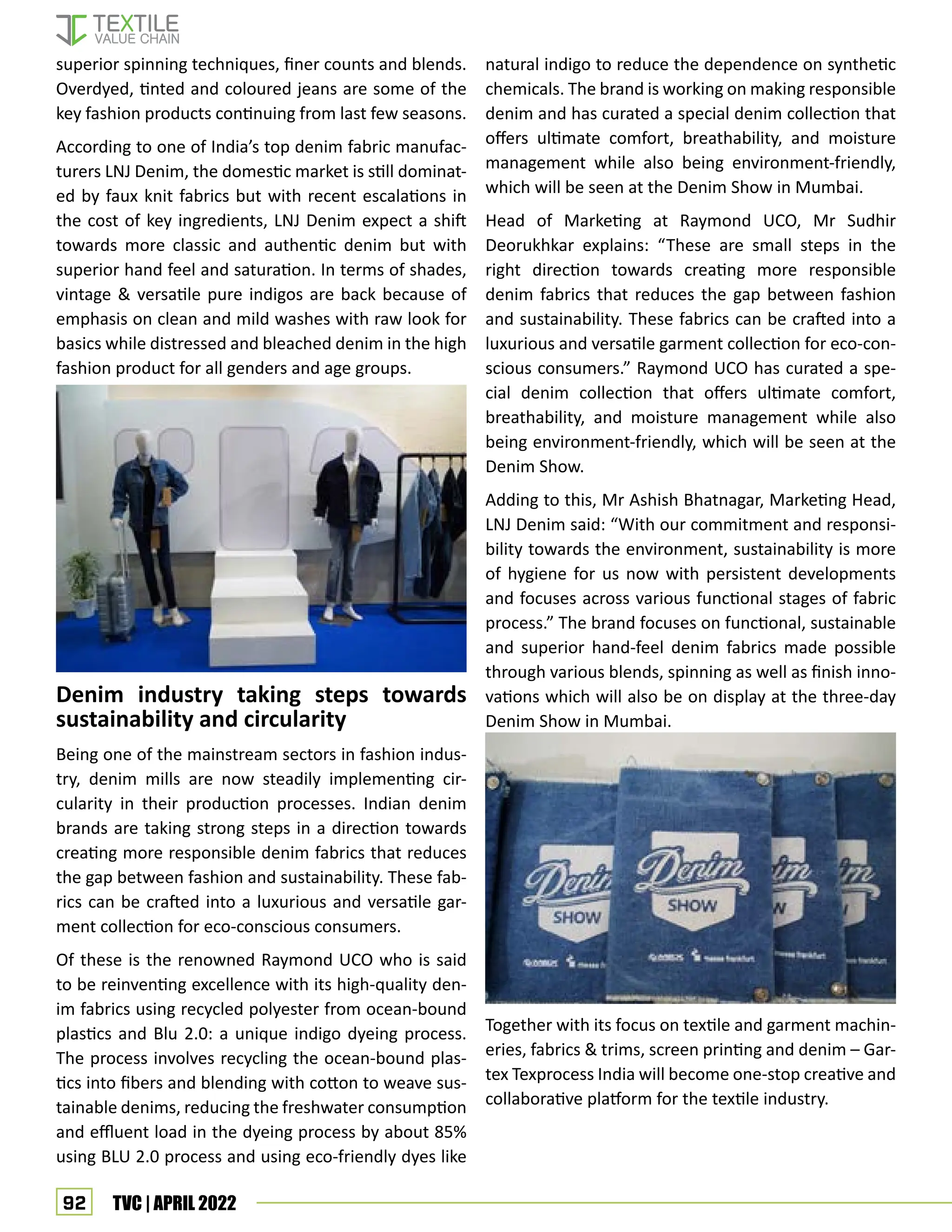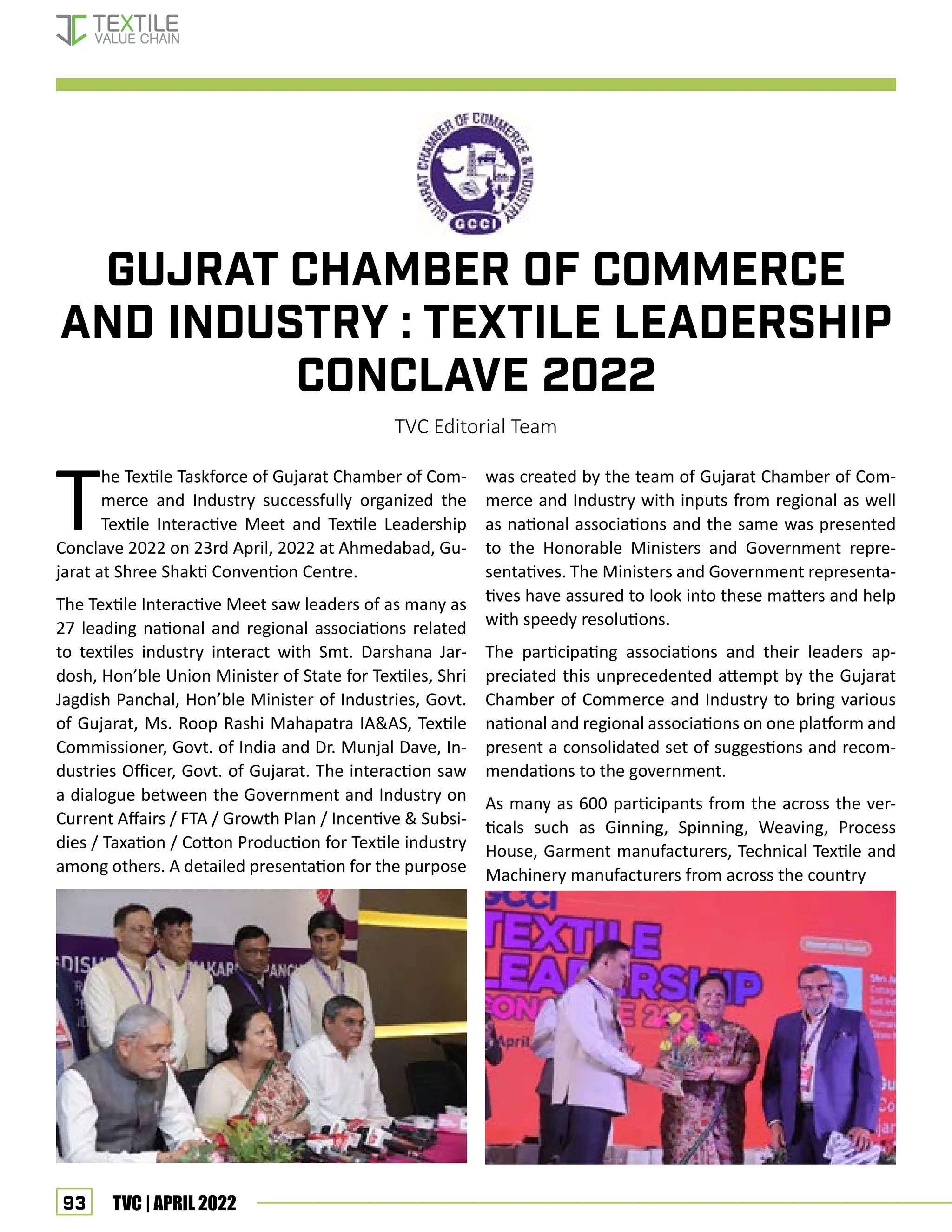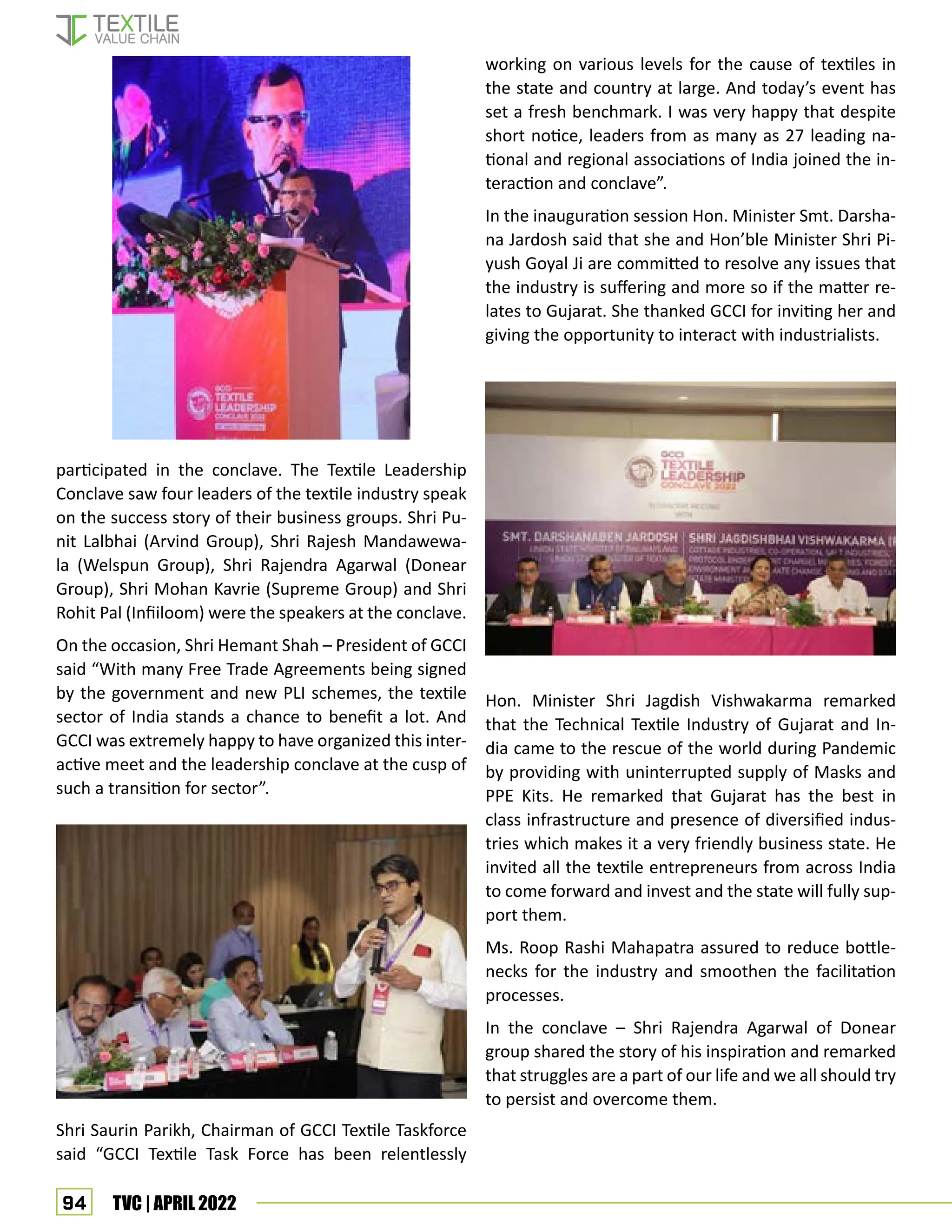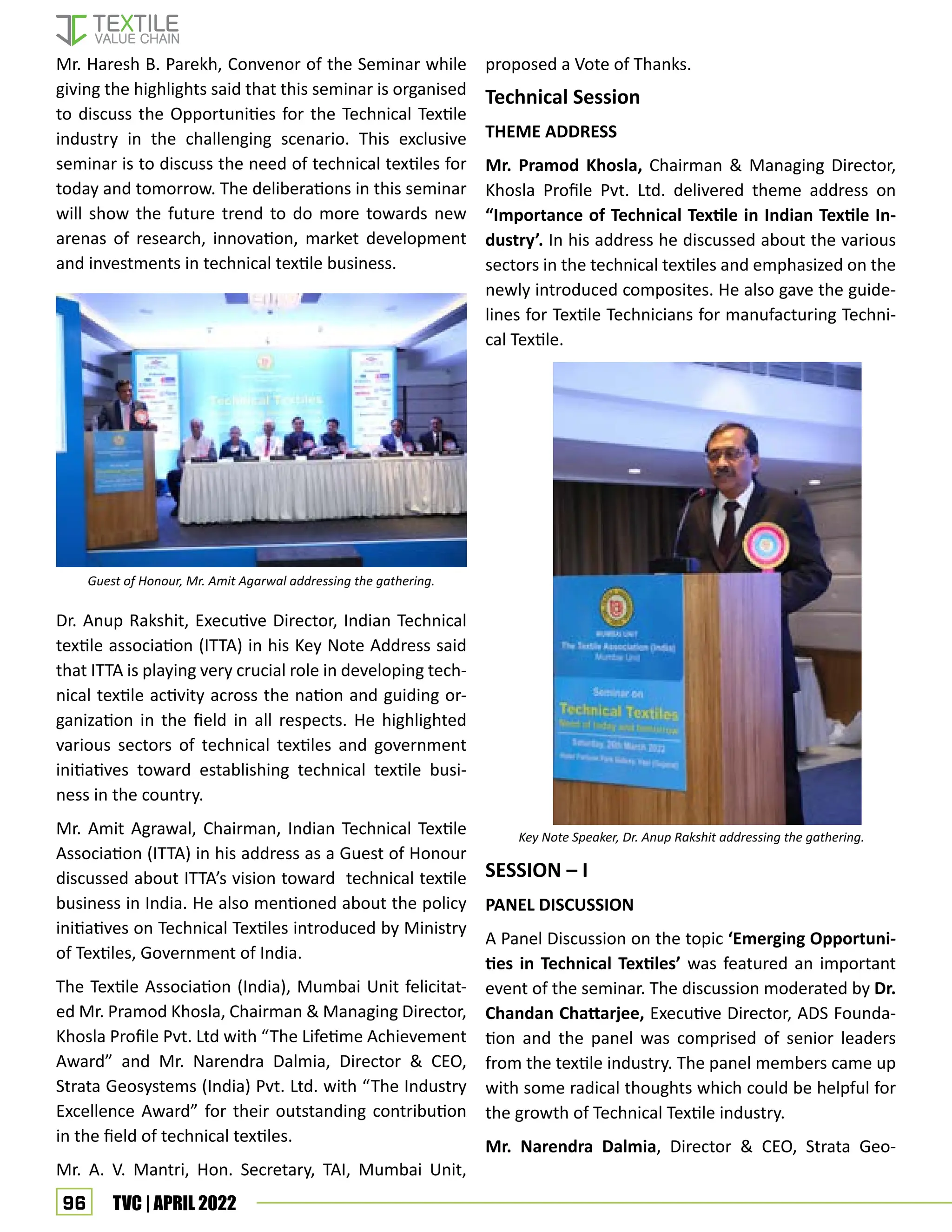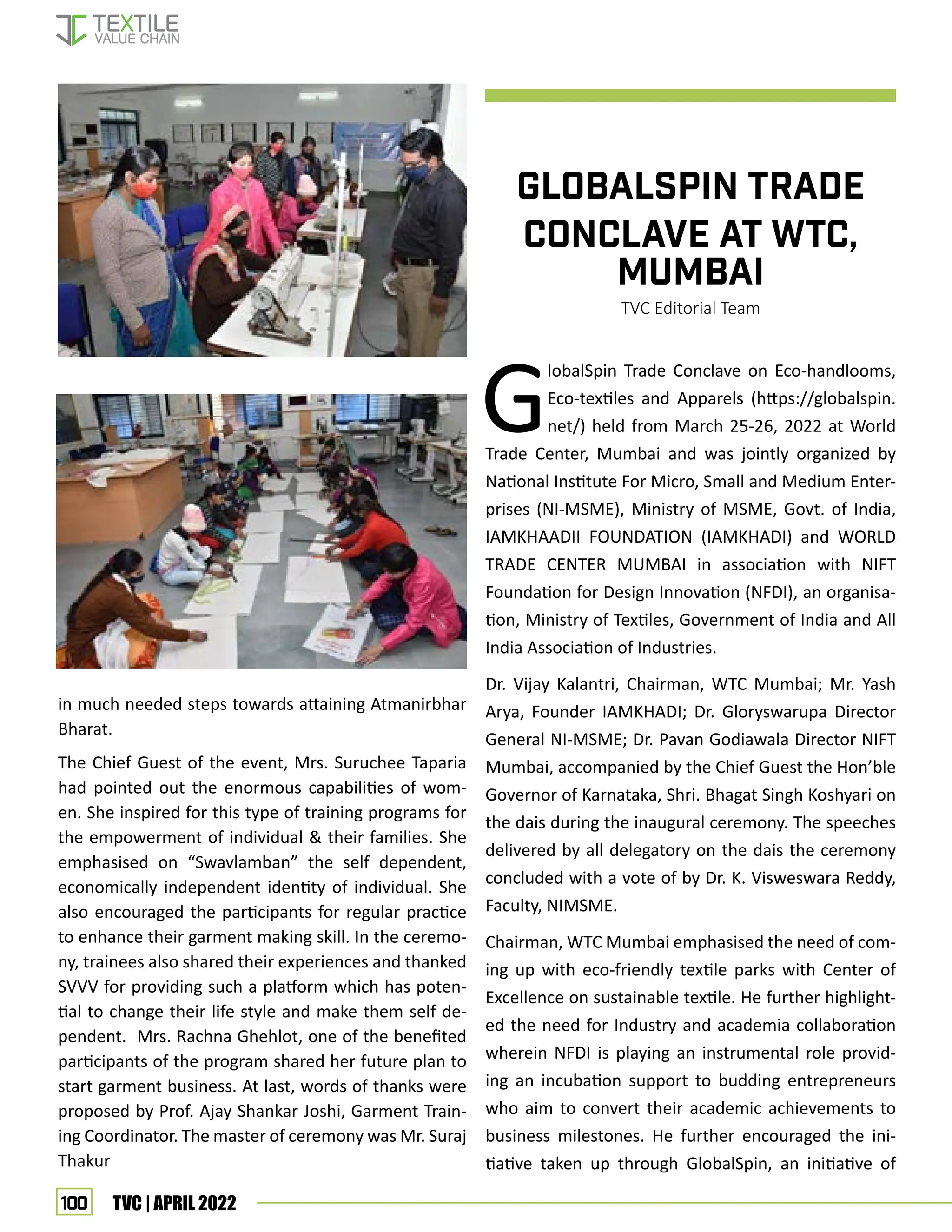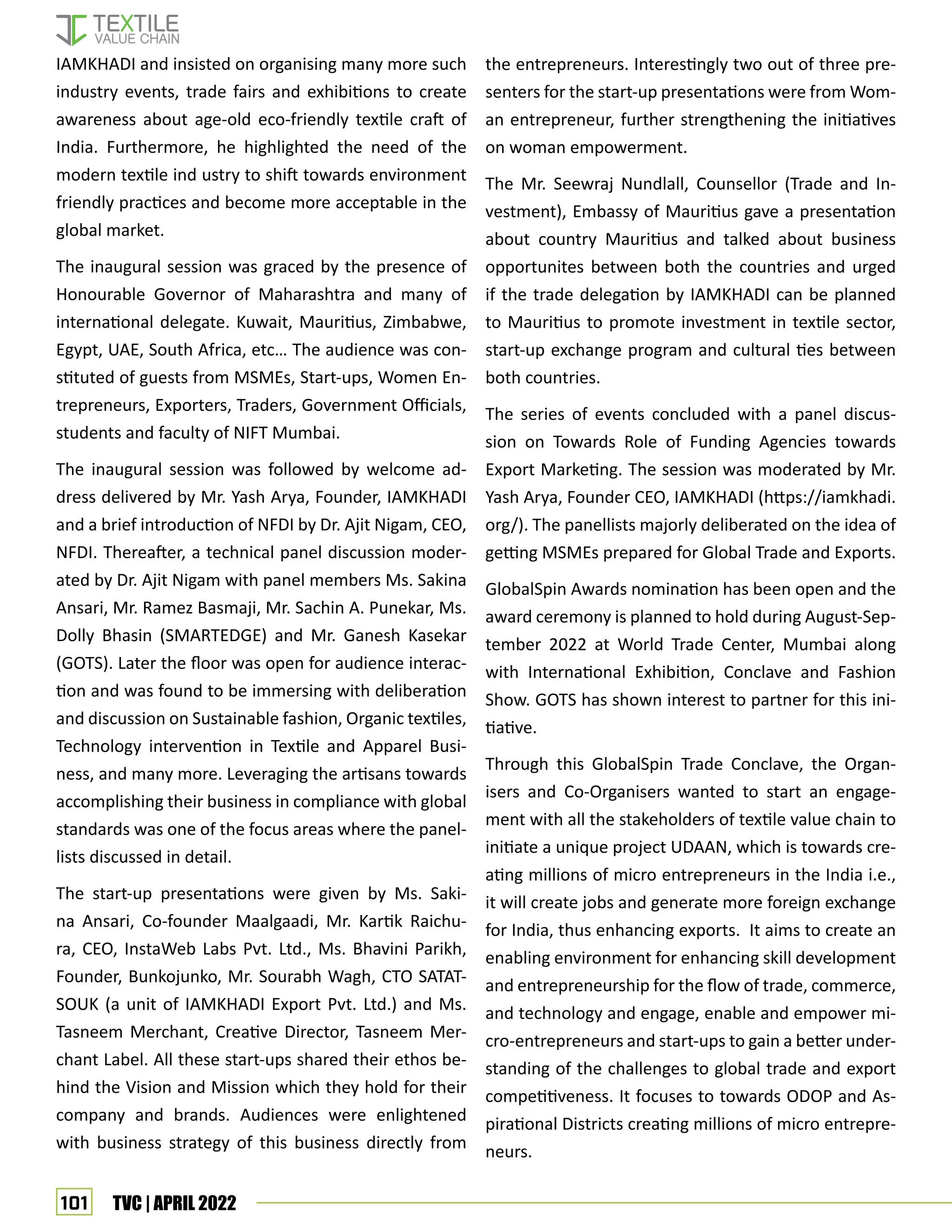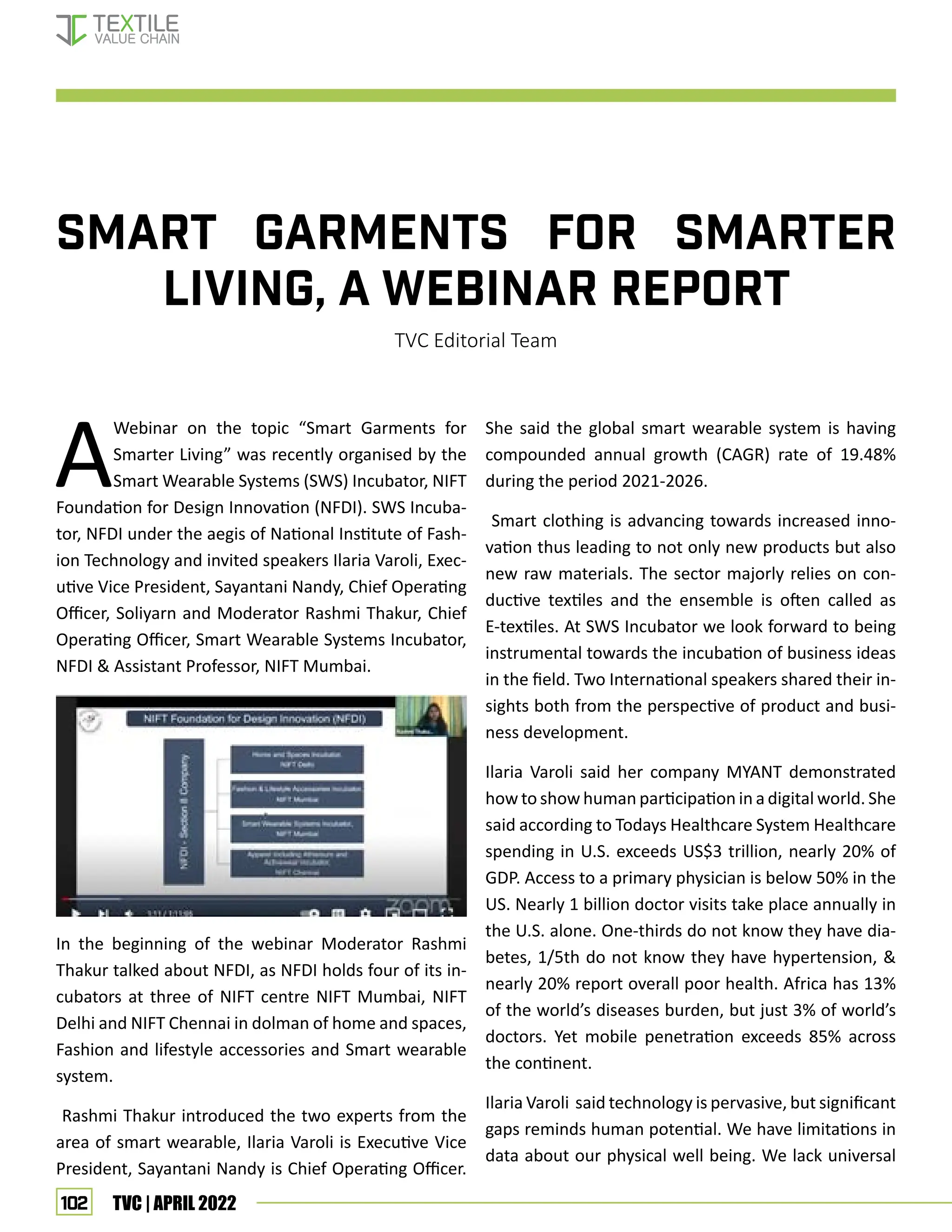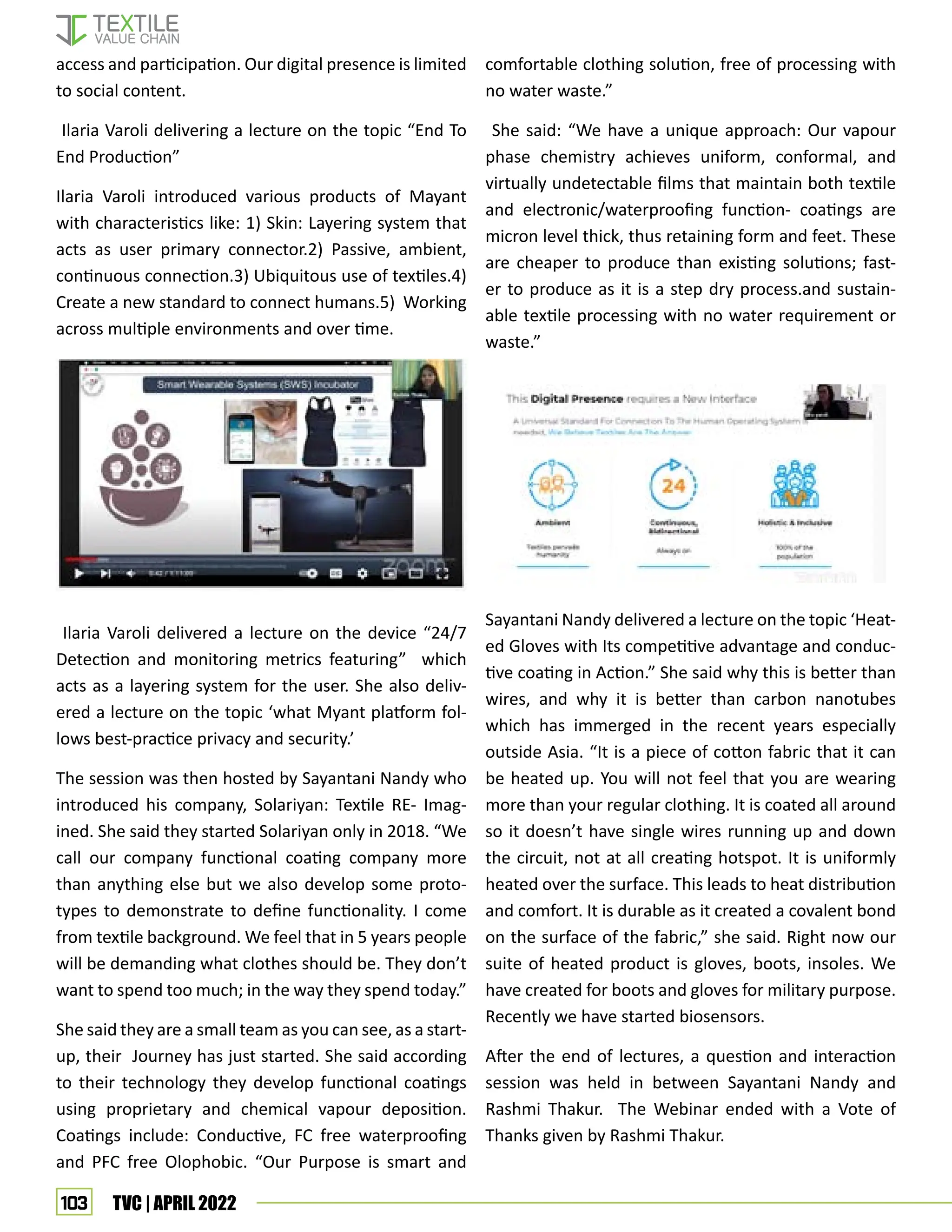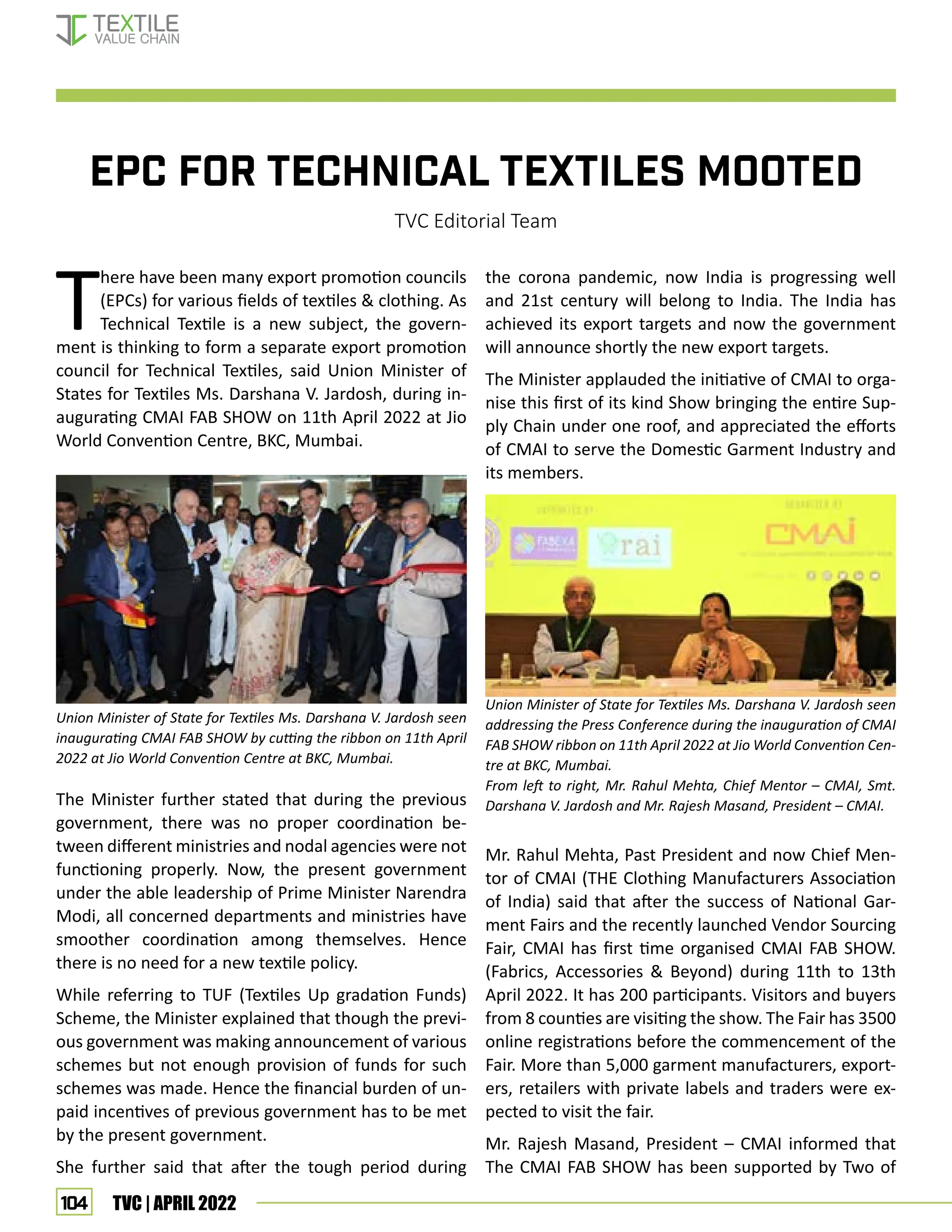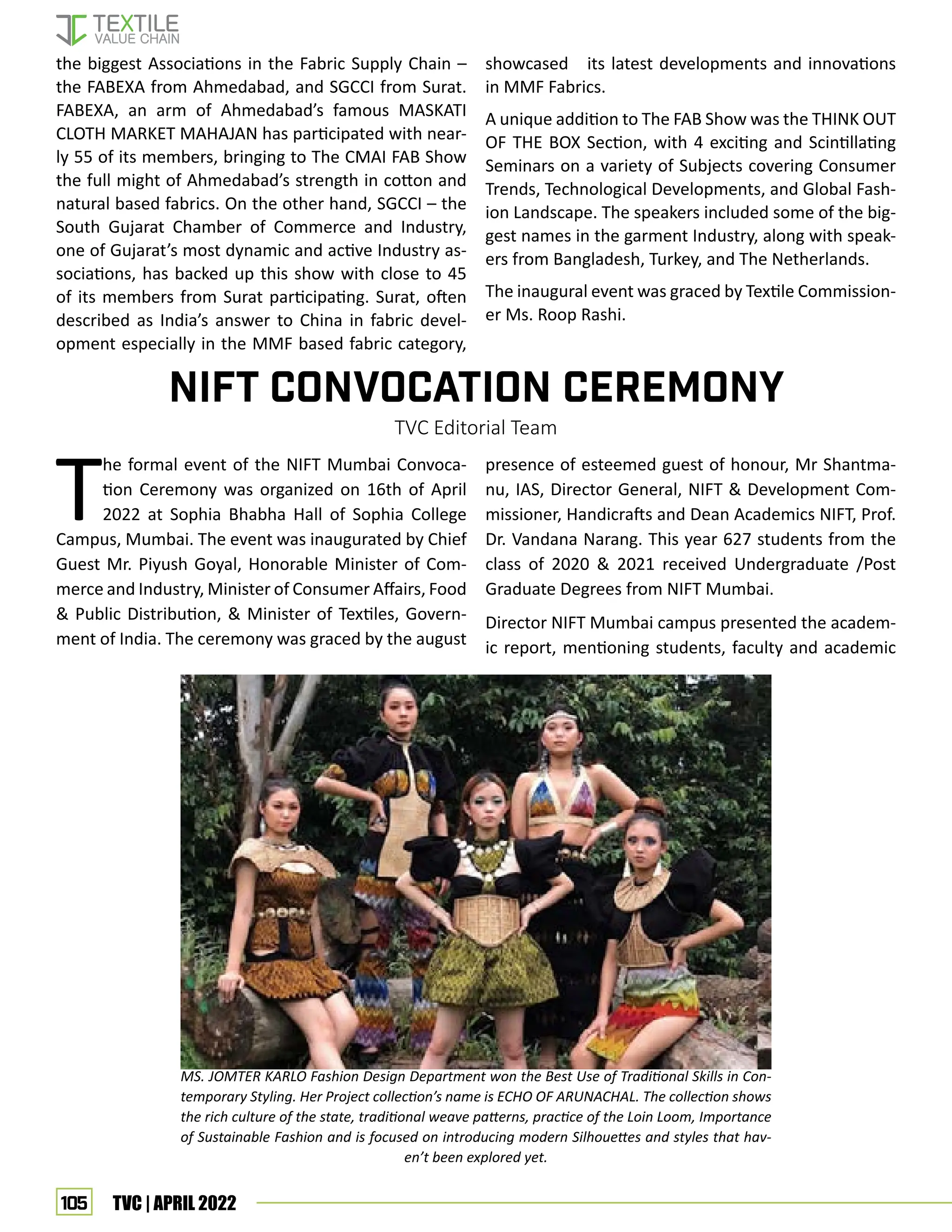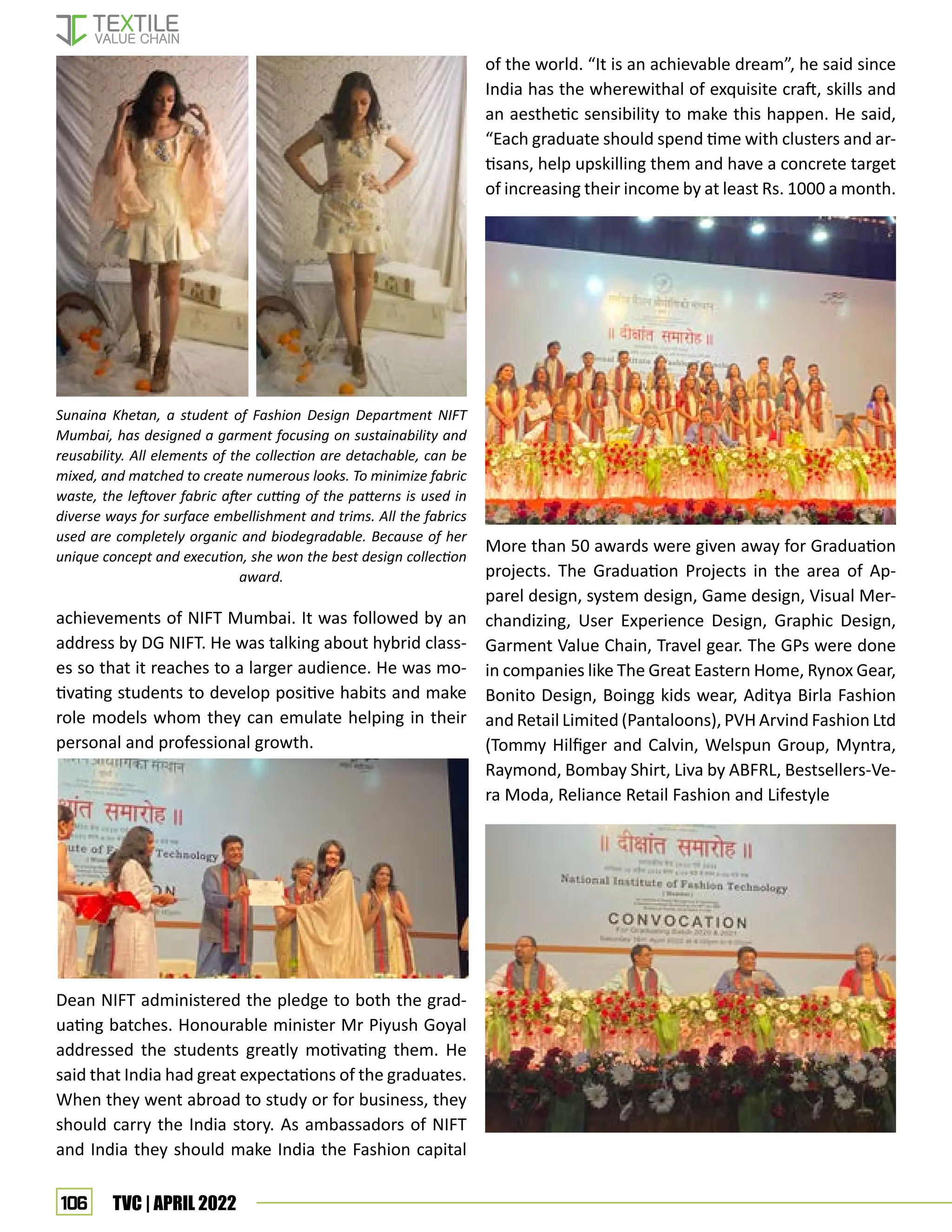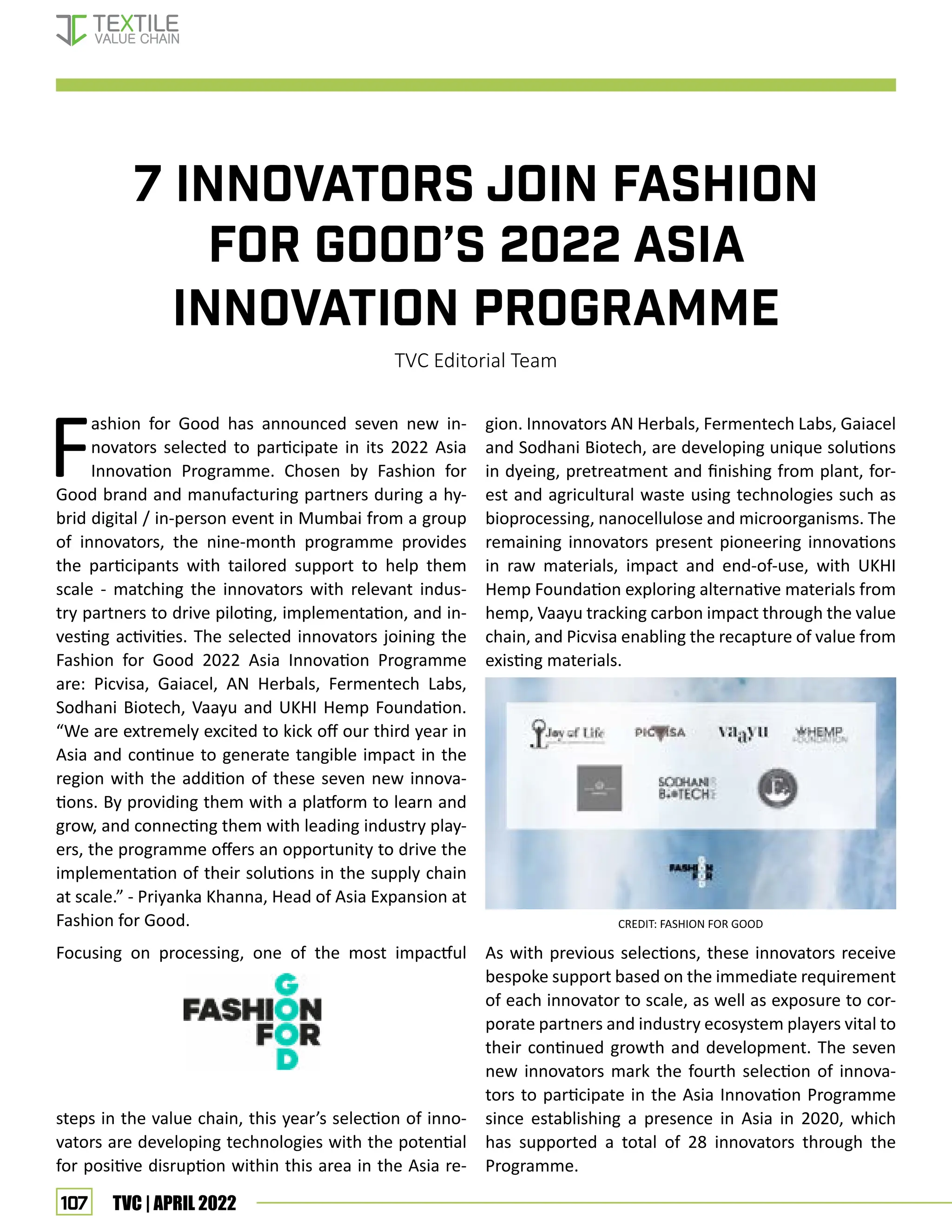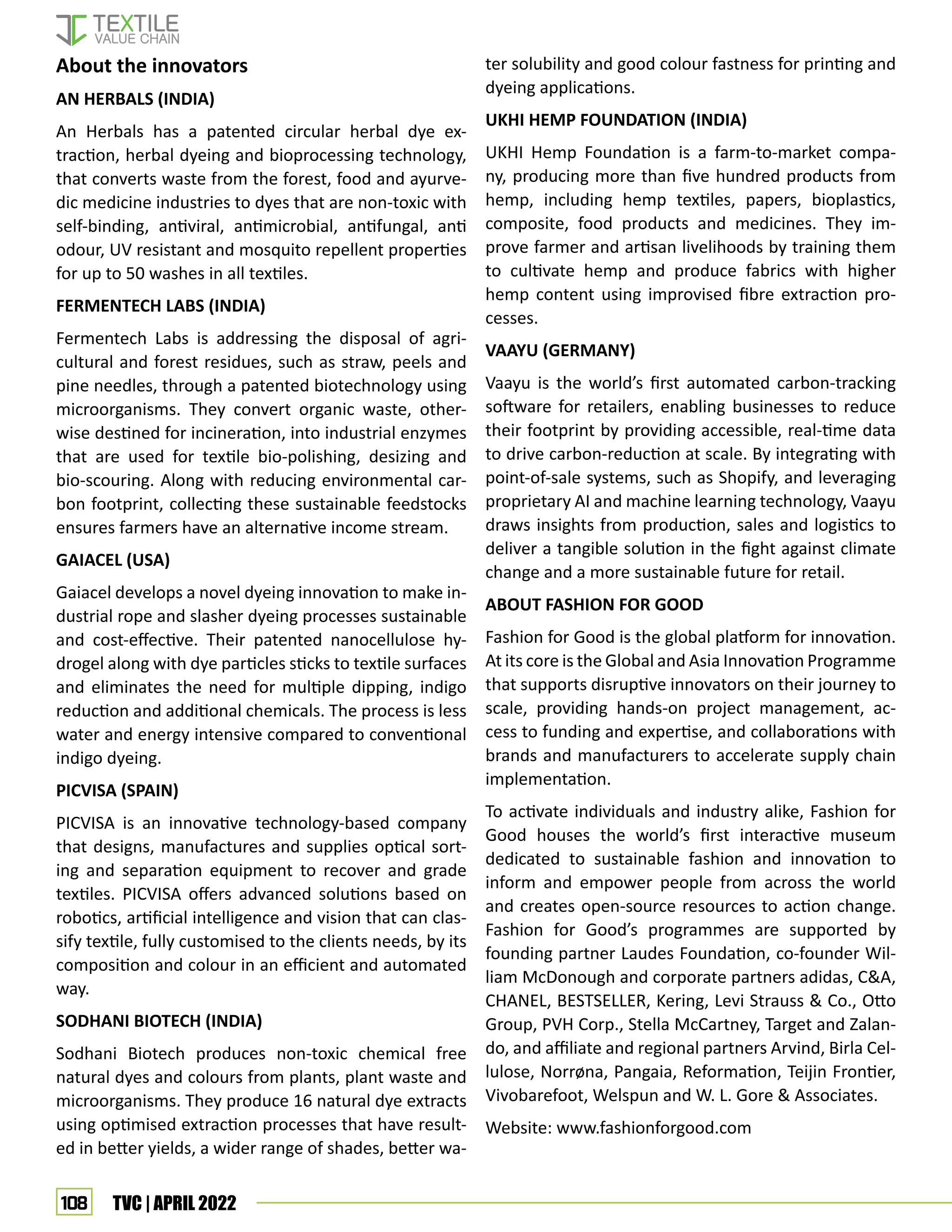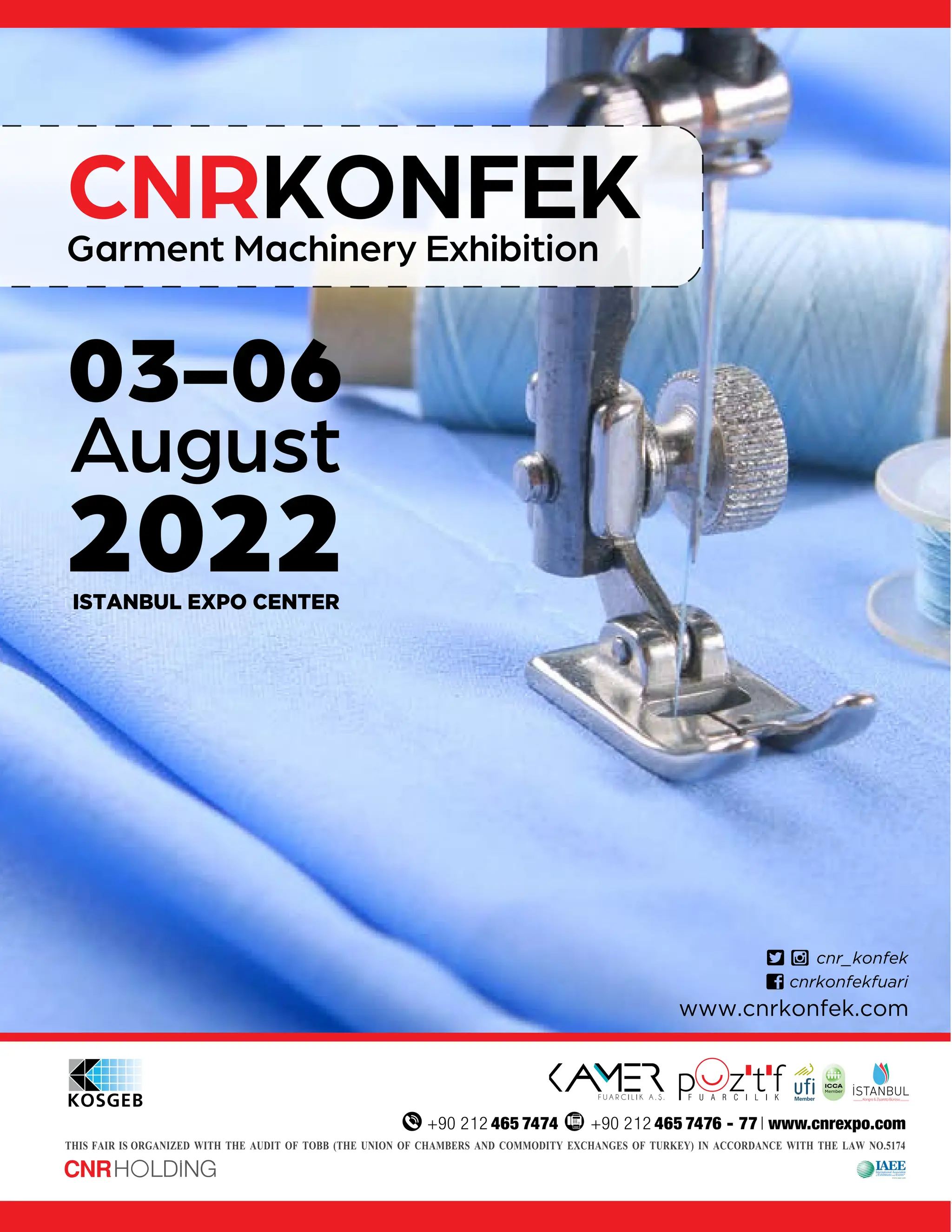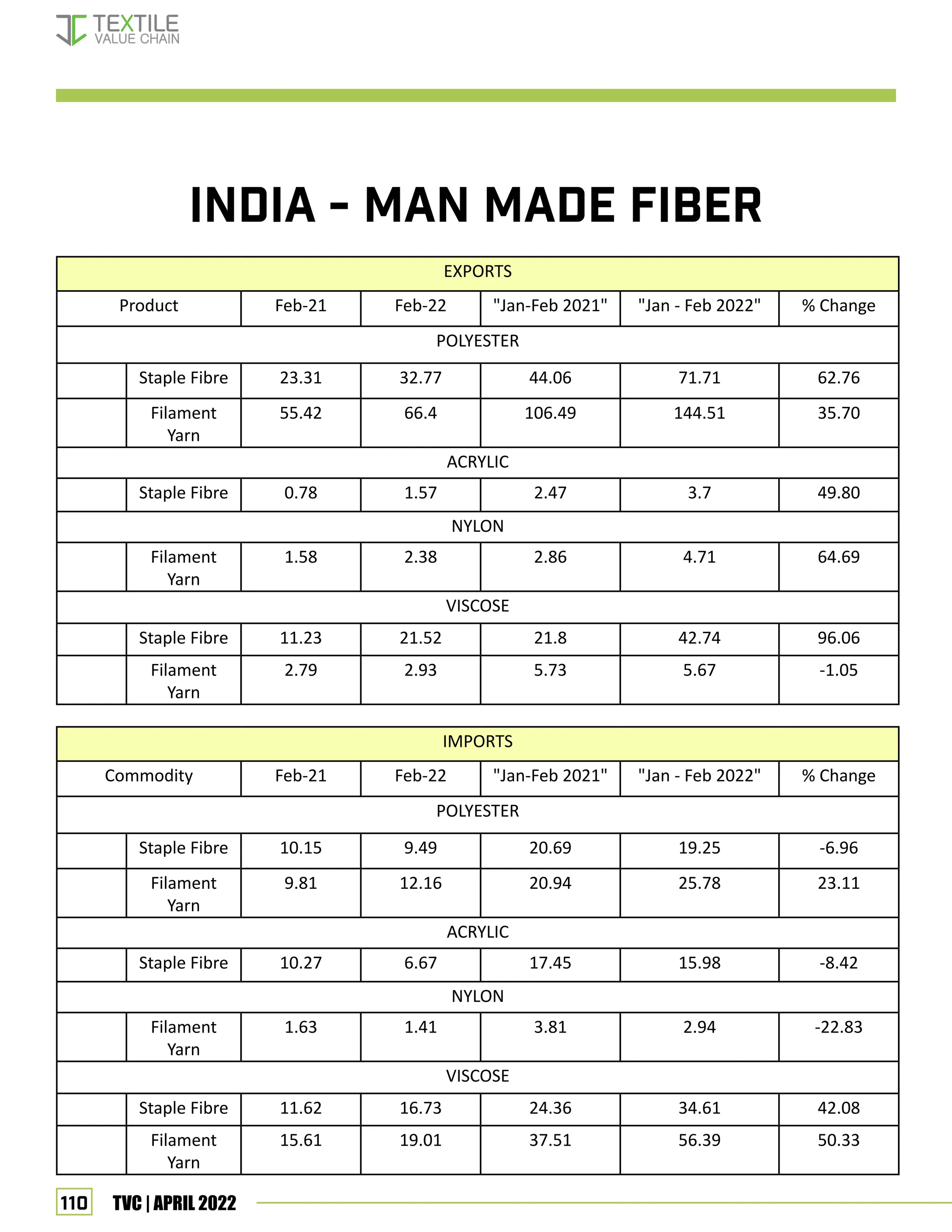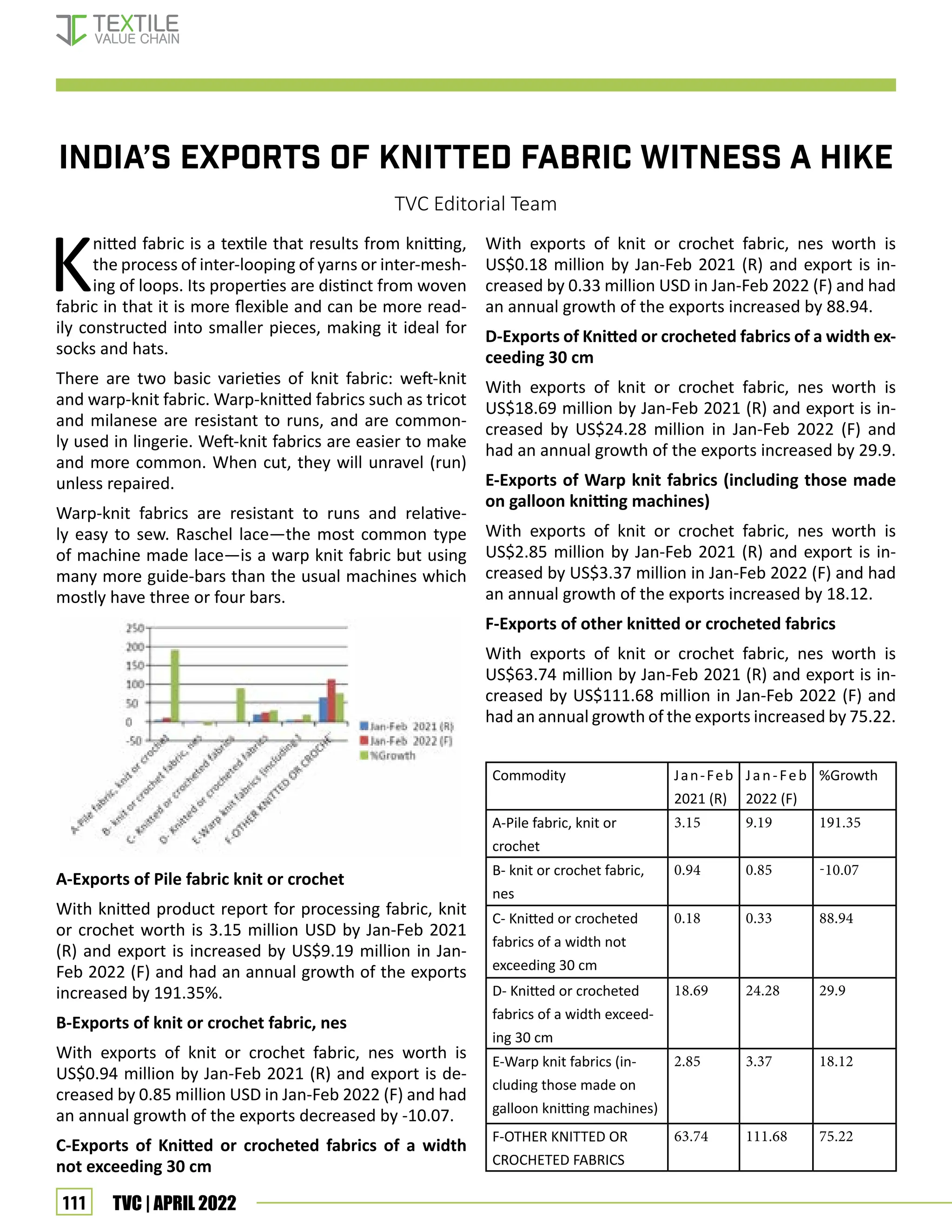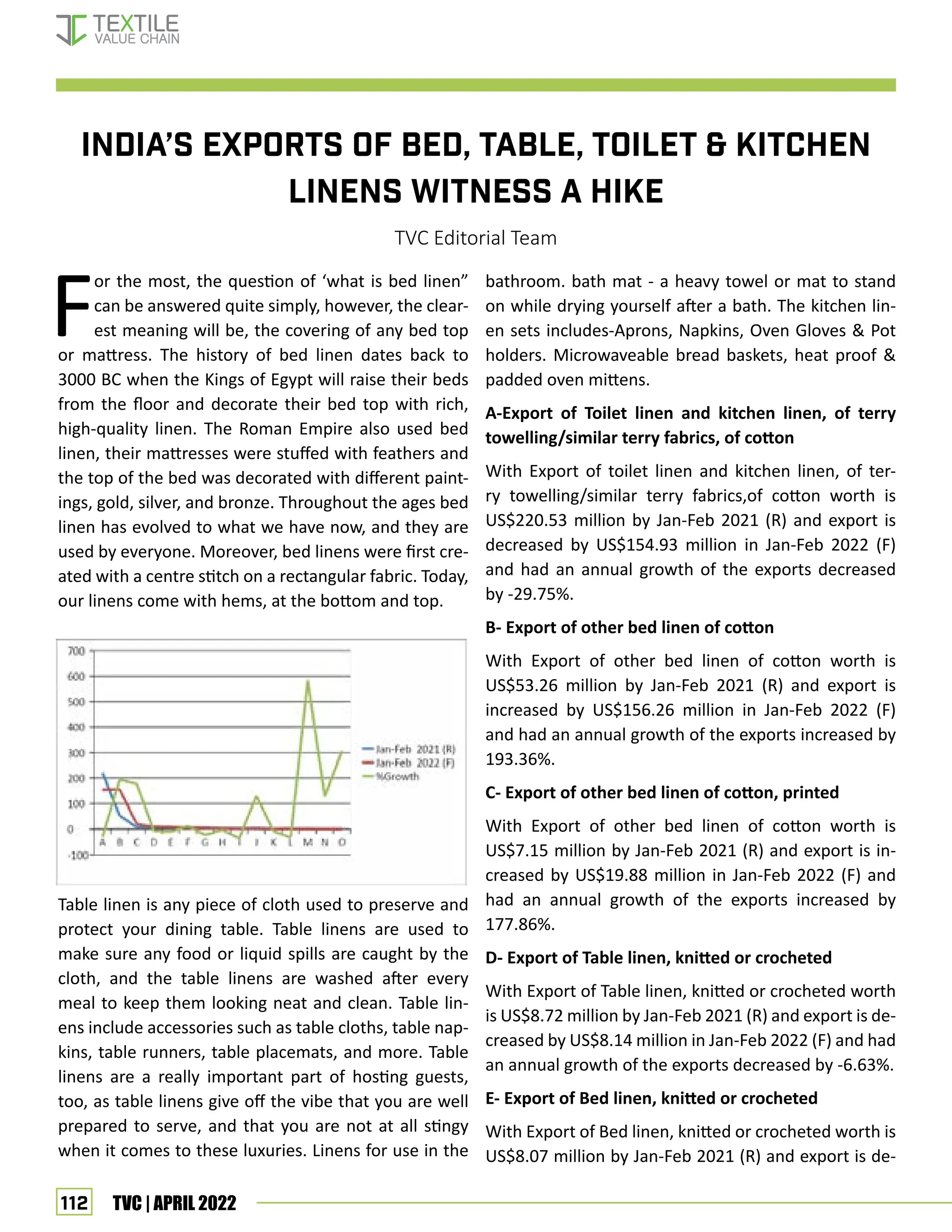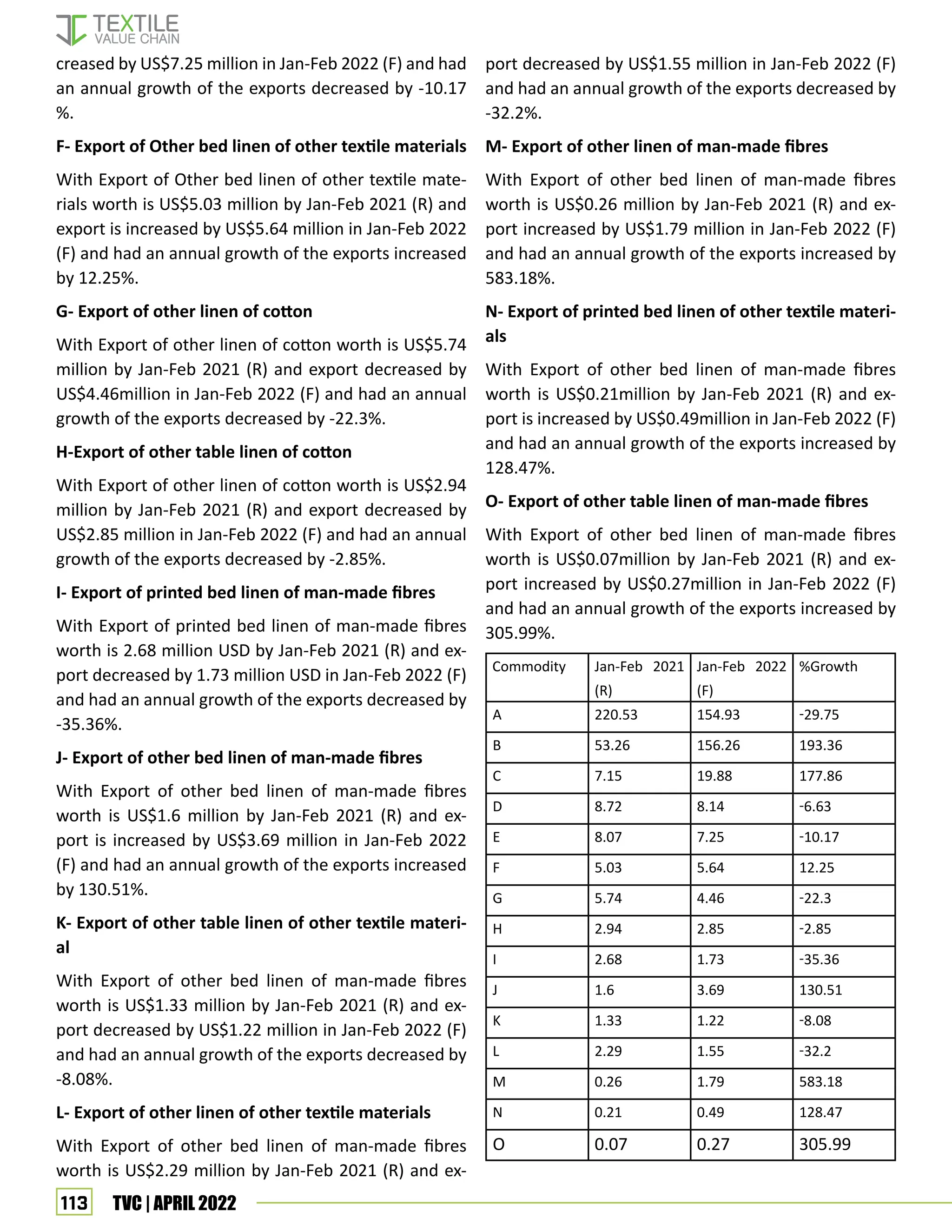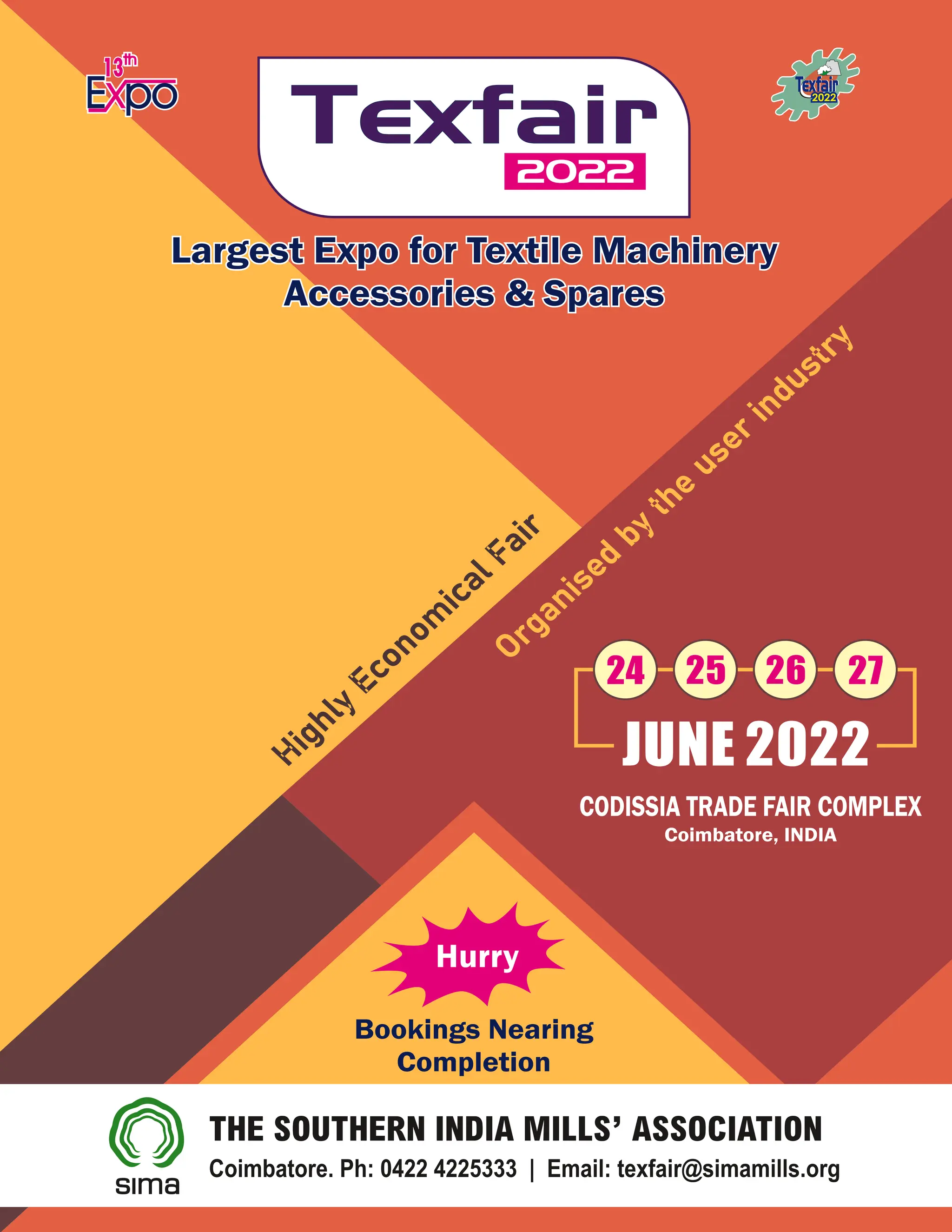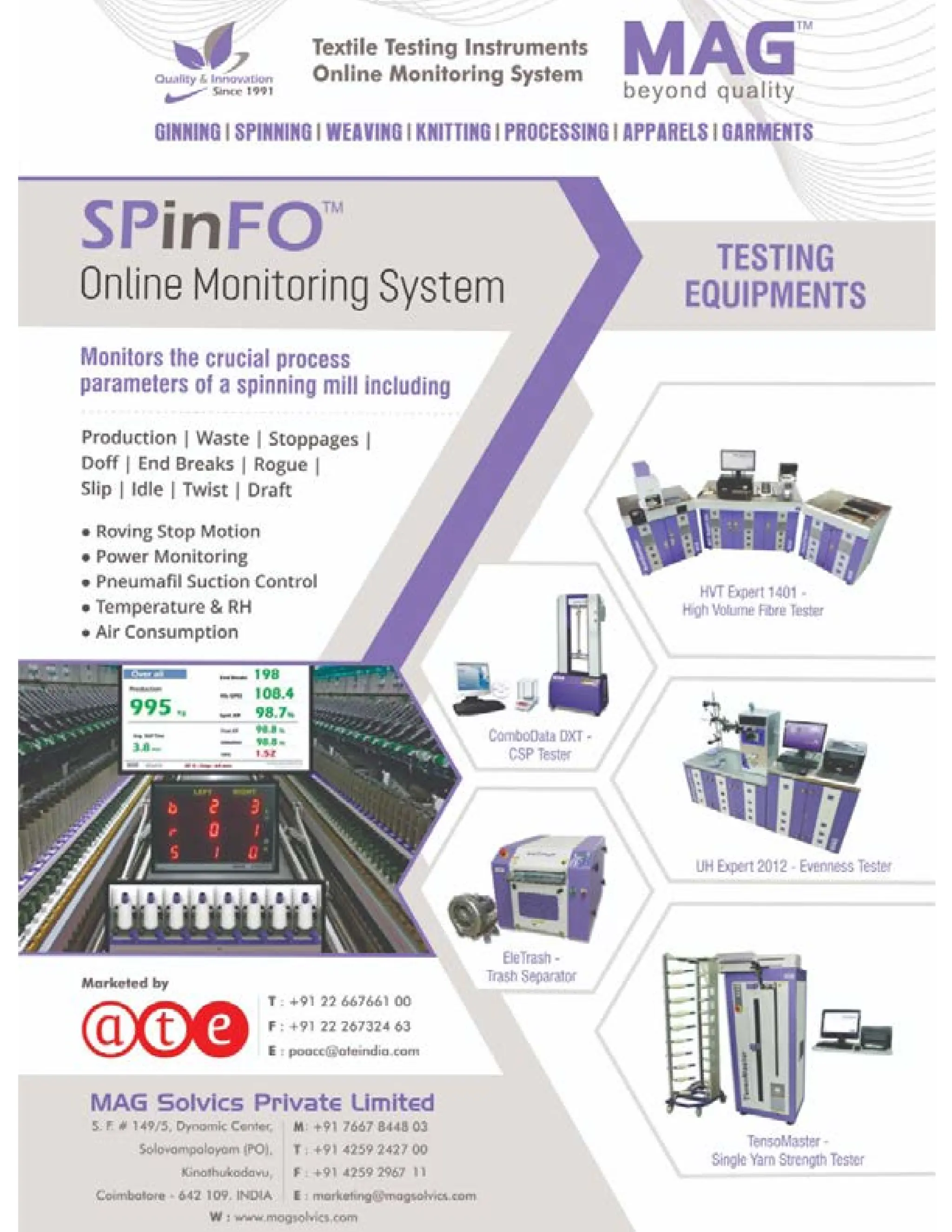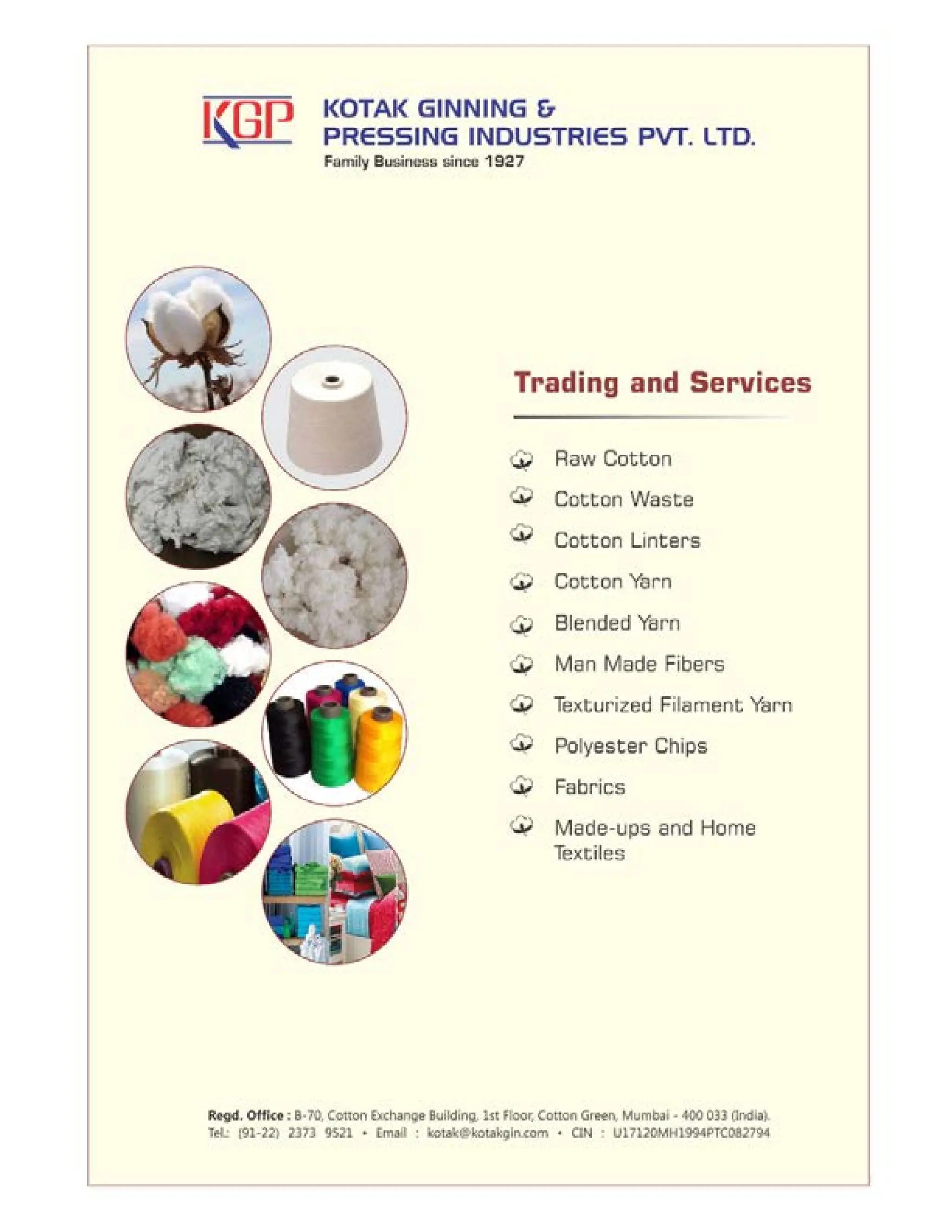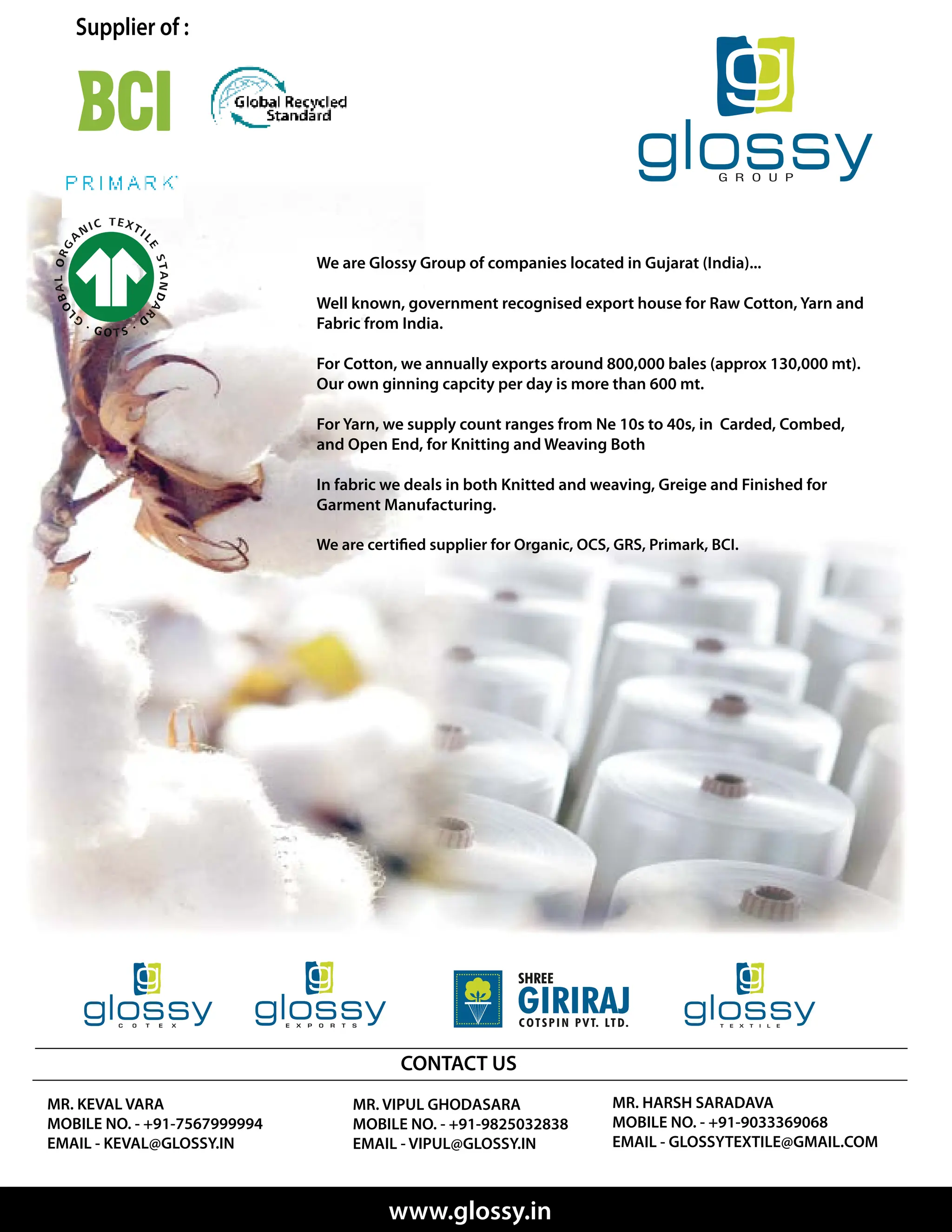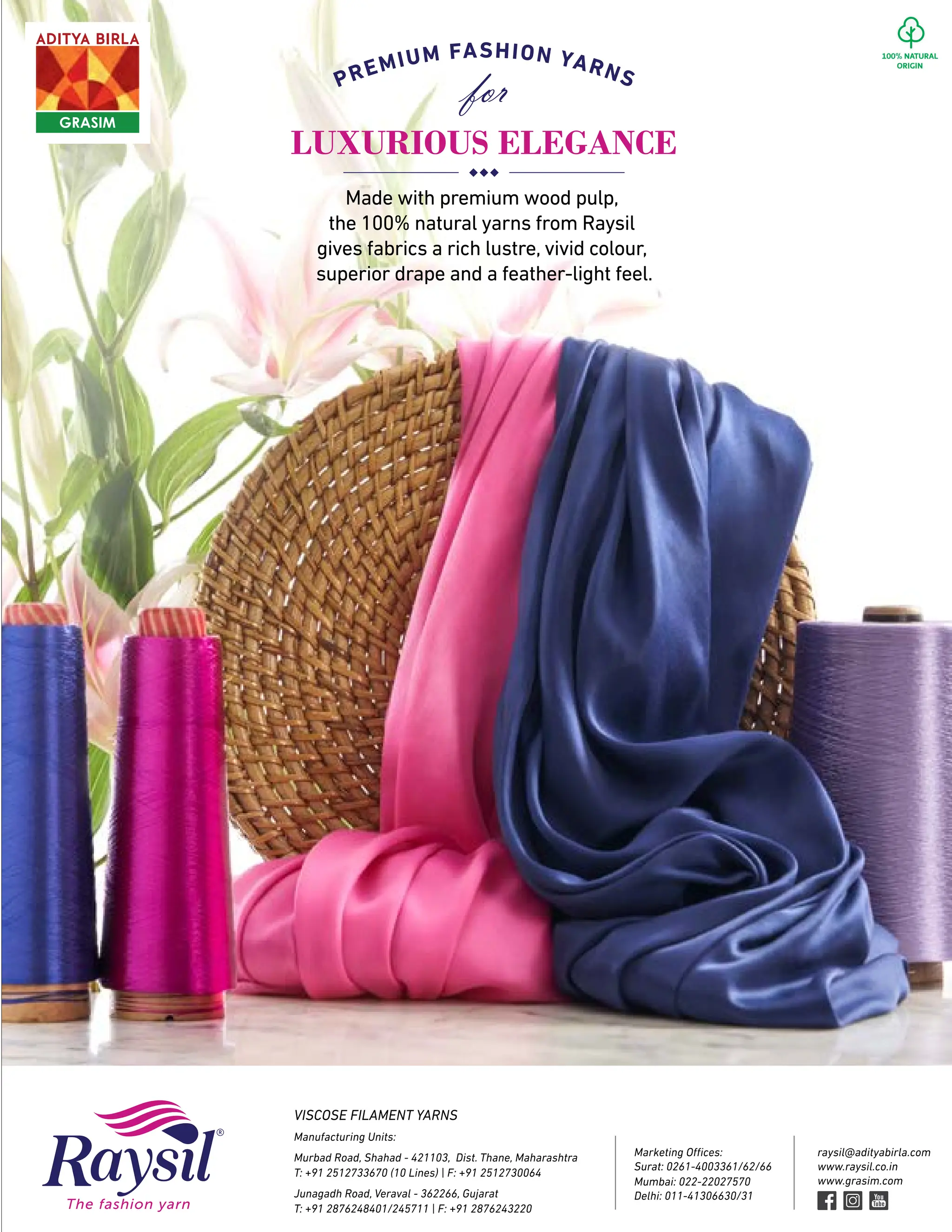Customs duty has been exempted on cotton imports until September 2022 as cotton prices have spiraled out of control in recent months. The cotton textile industry lobbied the government and textiles ministry about the urgent need to remove duty on cotton, which yielded this result. Export of cotton textiles like made-ups, fabrics and yarns have performed well, reaching $14.8 billion for 2021-2022, exceeding targets. However, the cotton crisis poses a threat to the $100 billion textile export target by 2030. The industry may increasingly adopt cotton blends as an alternative to pure cotton.
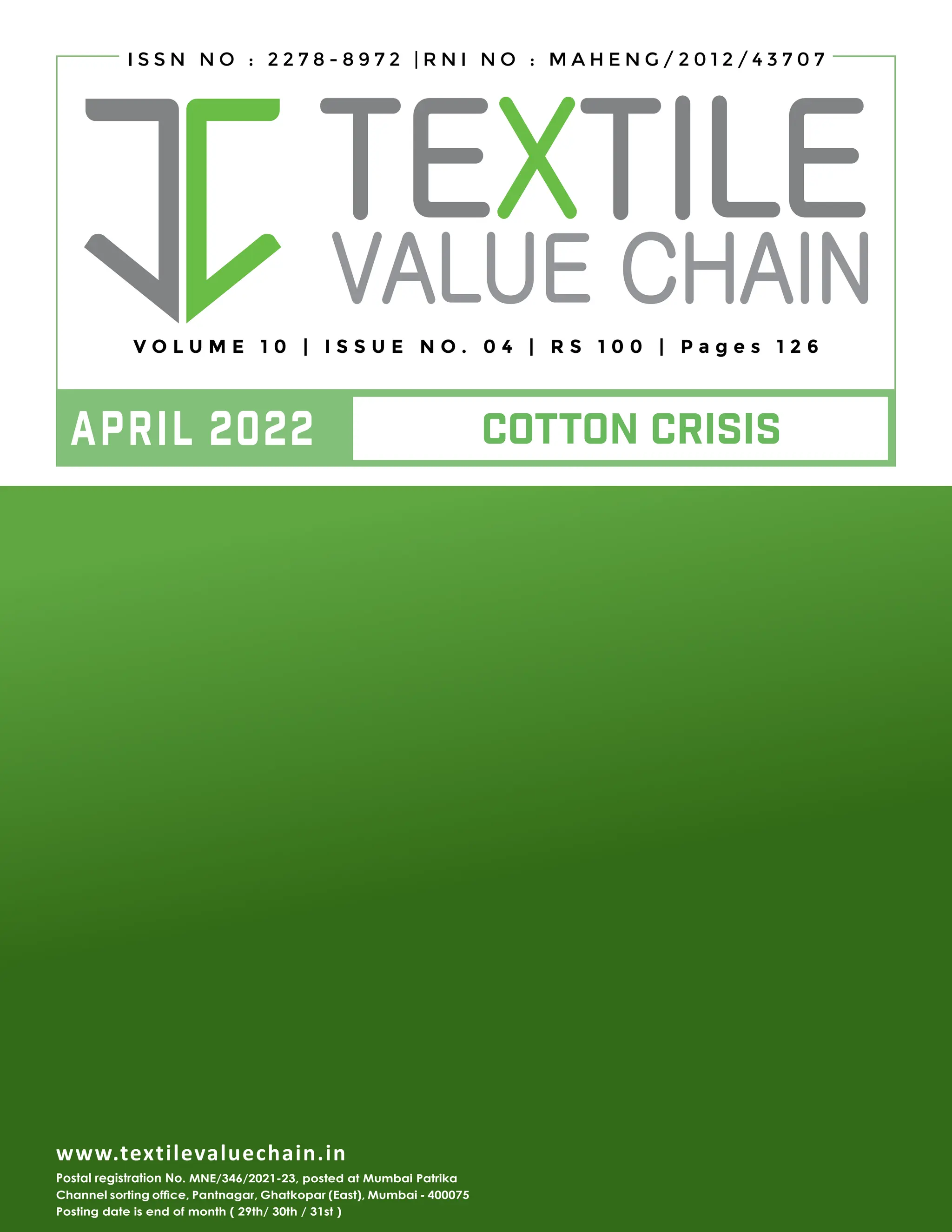

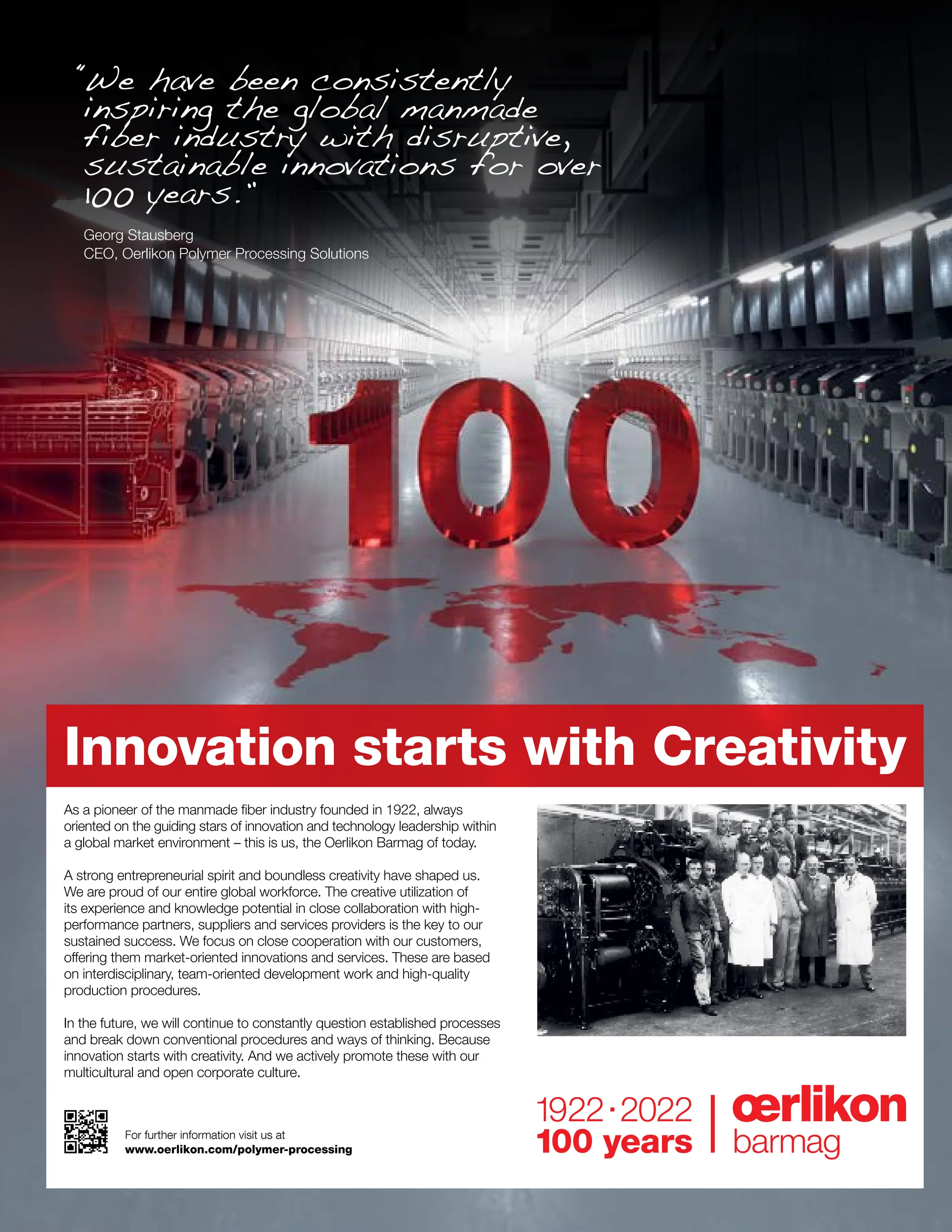
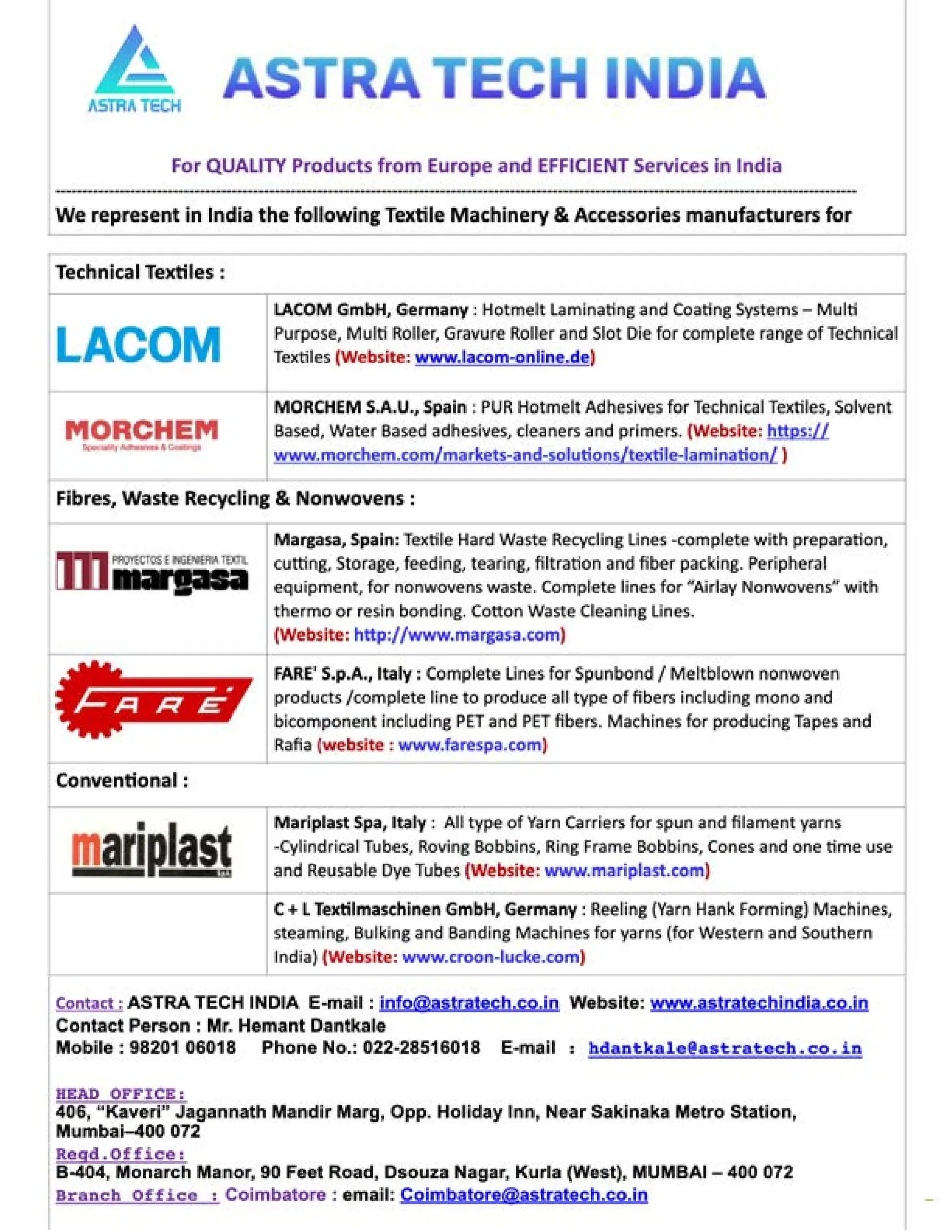


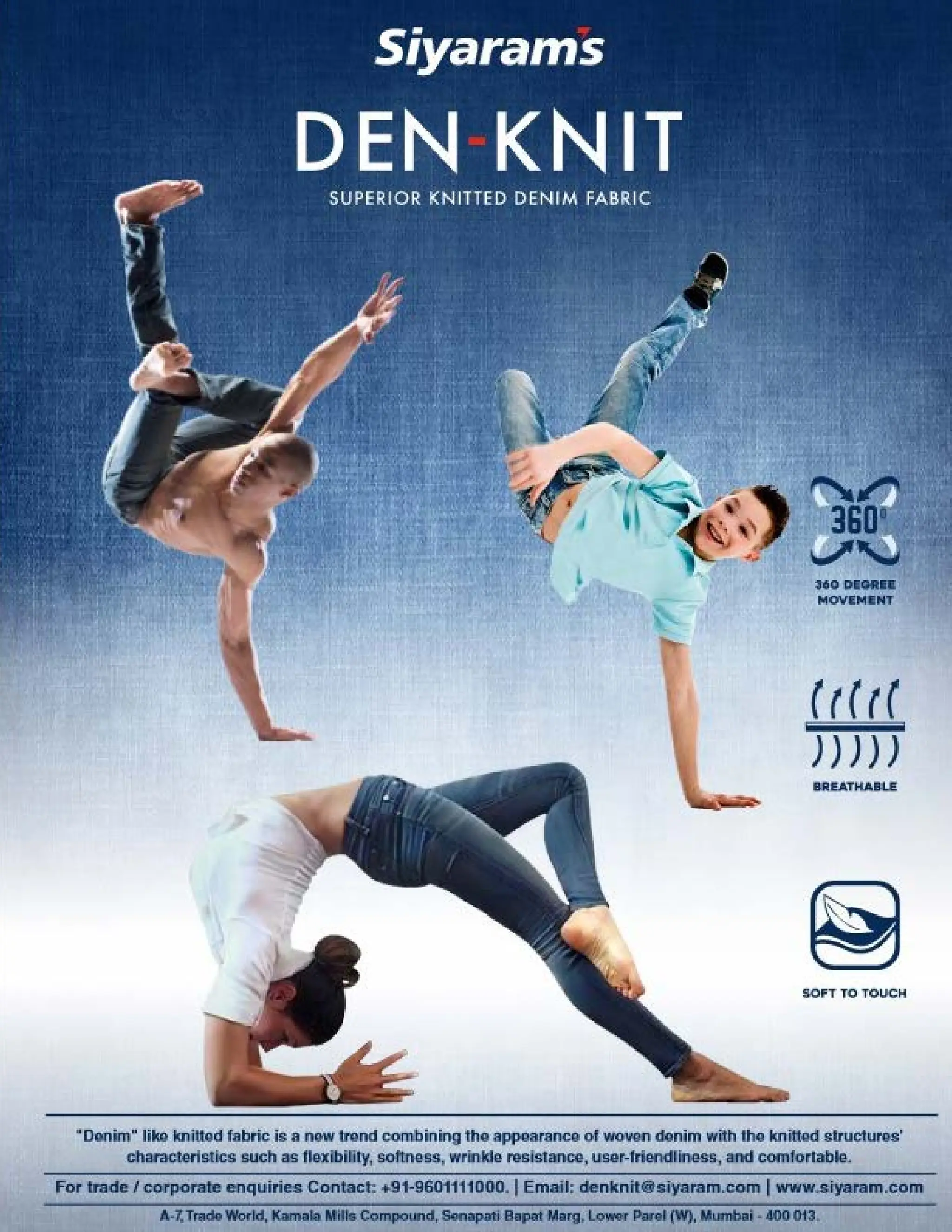
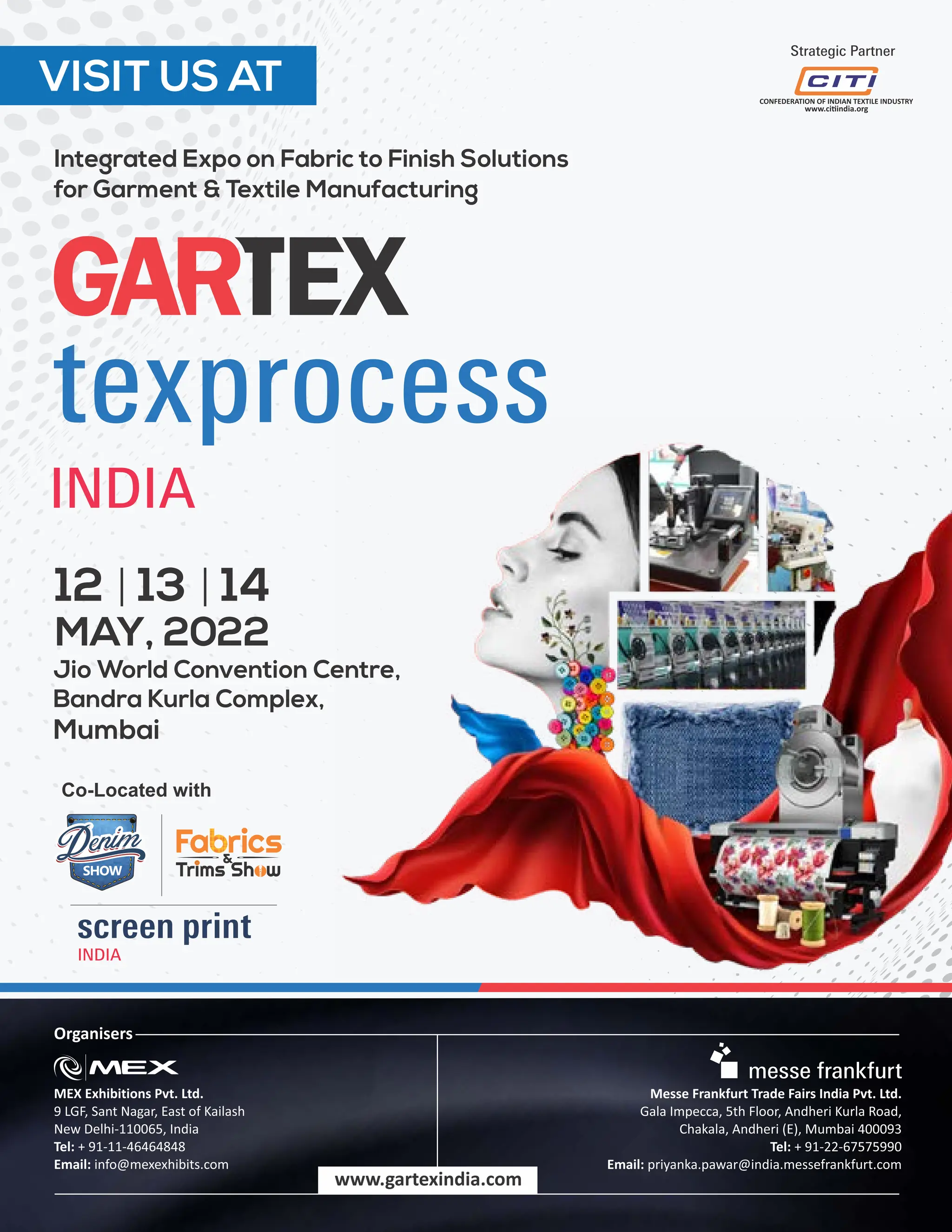
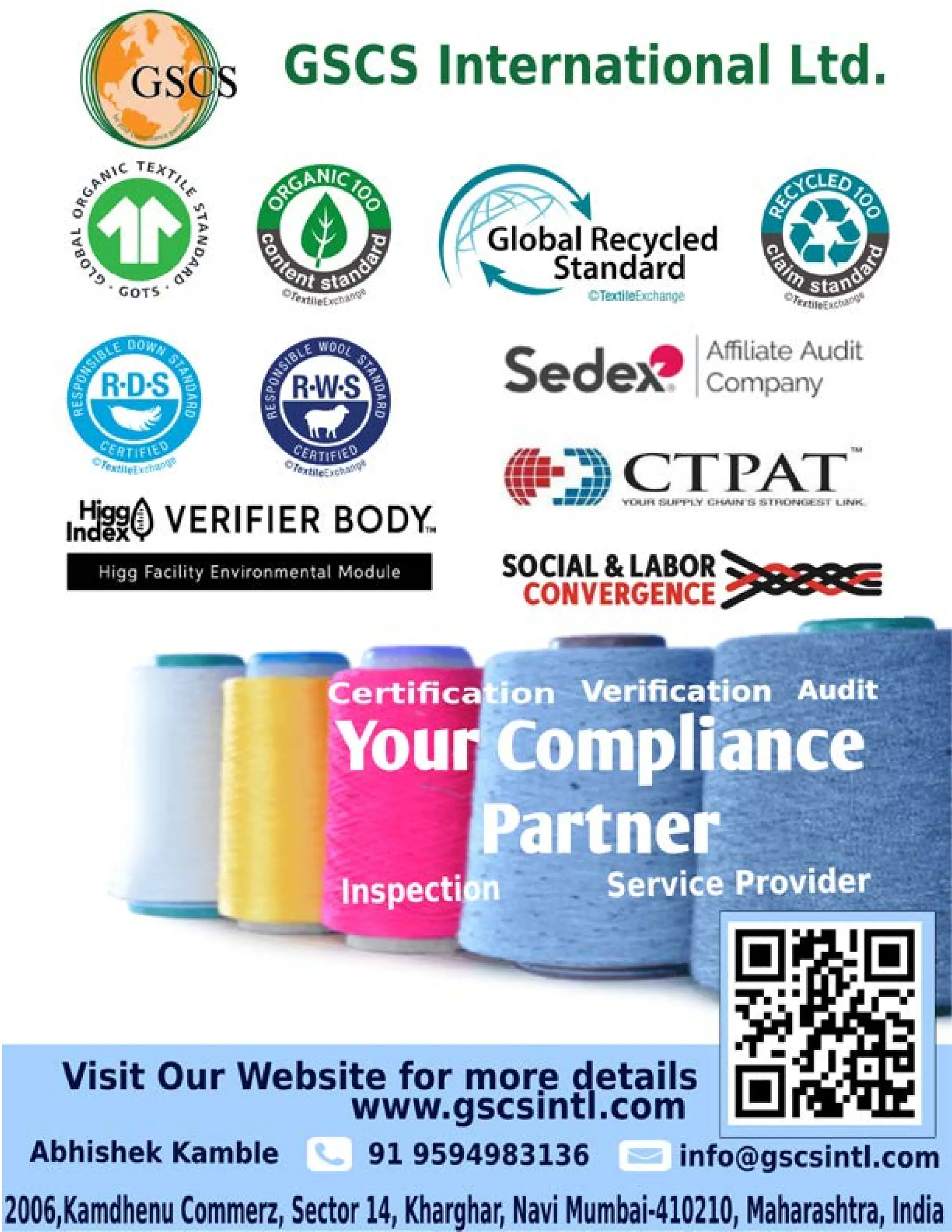
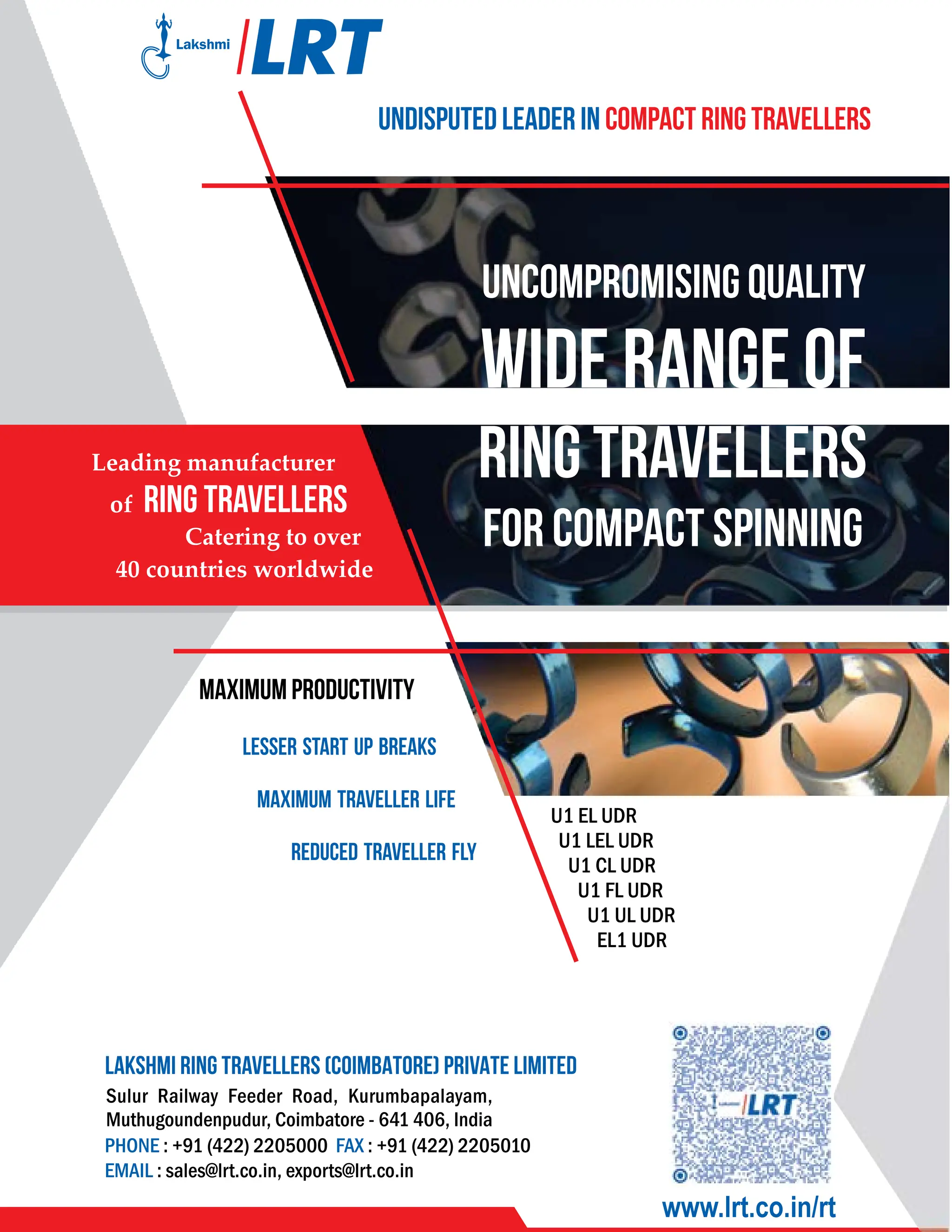
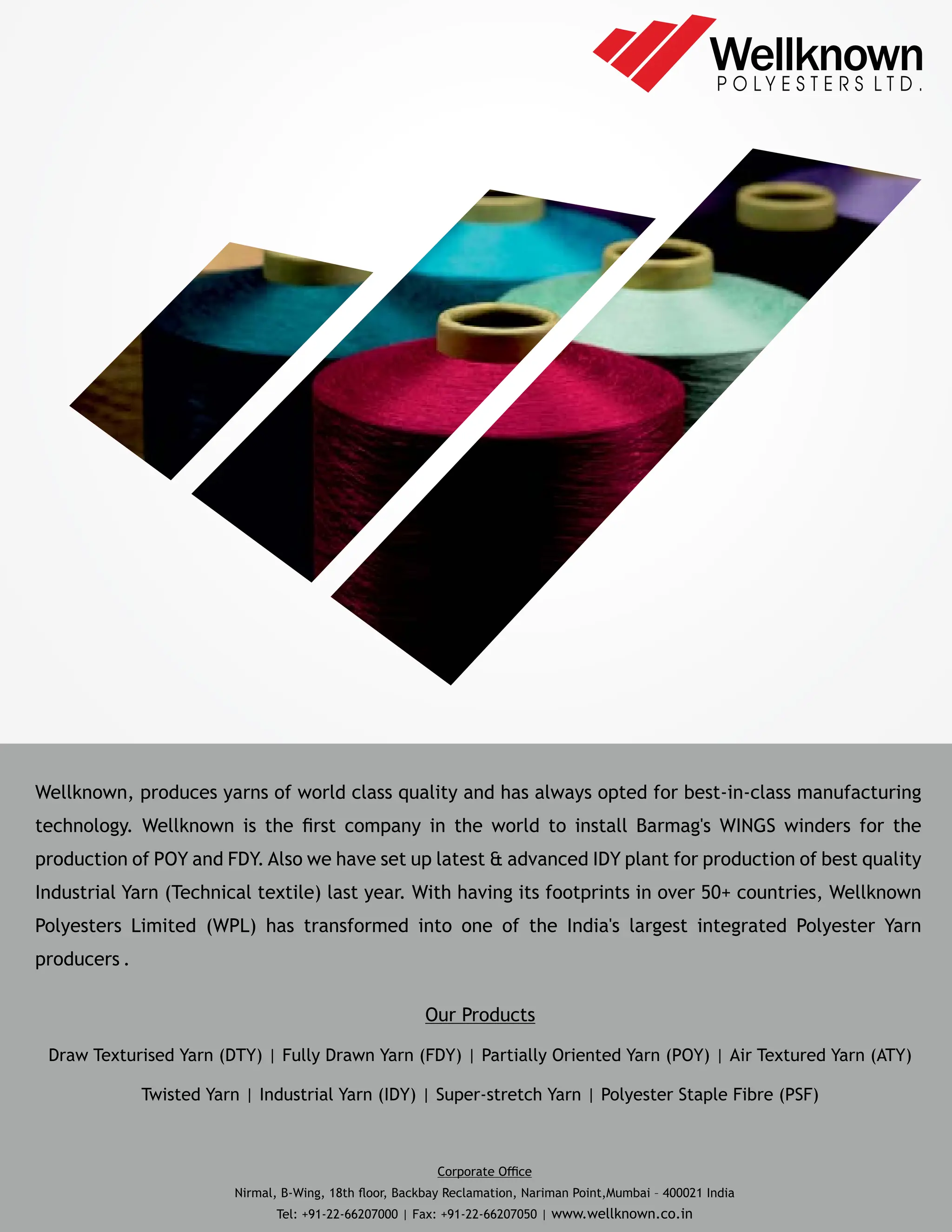

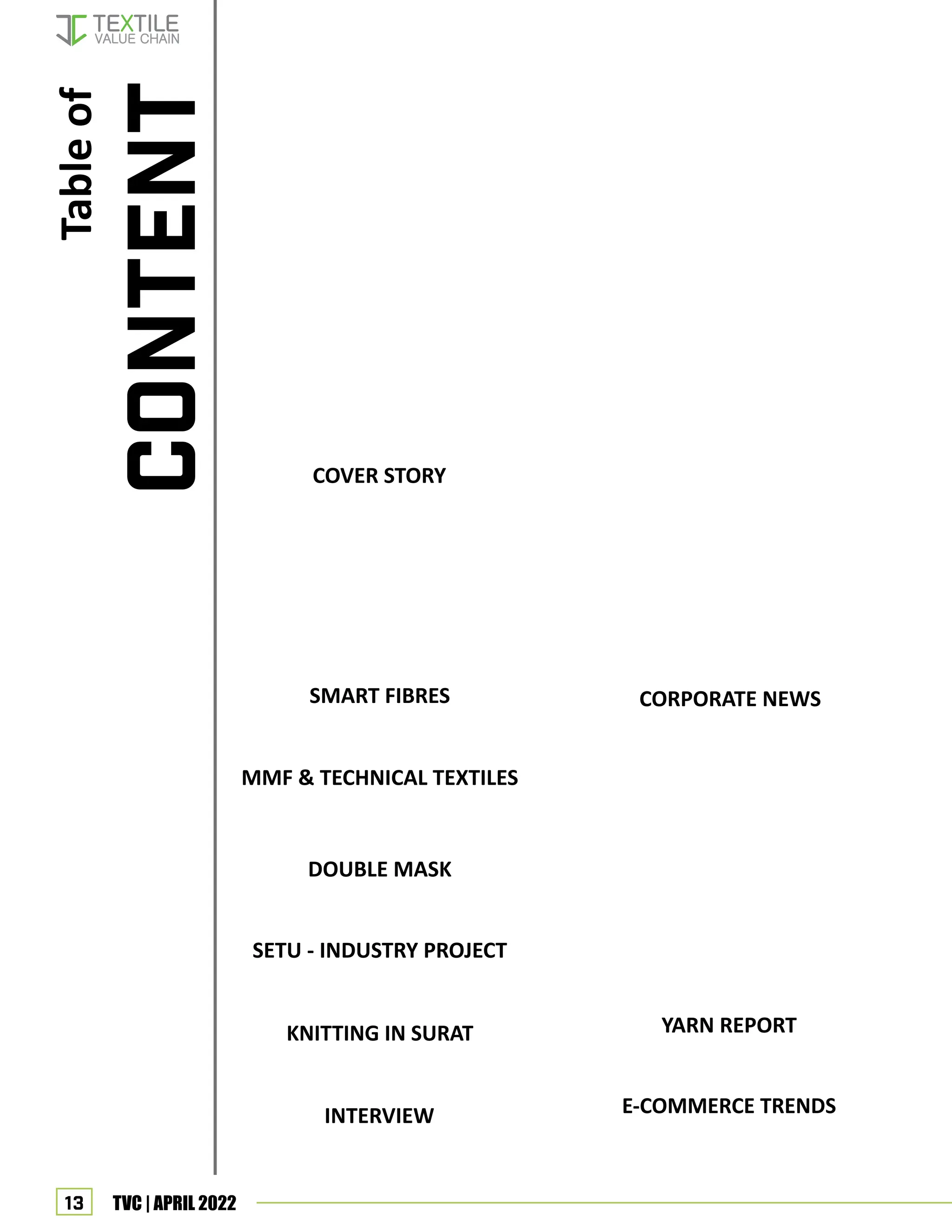
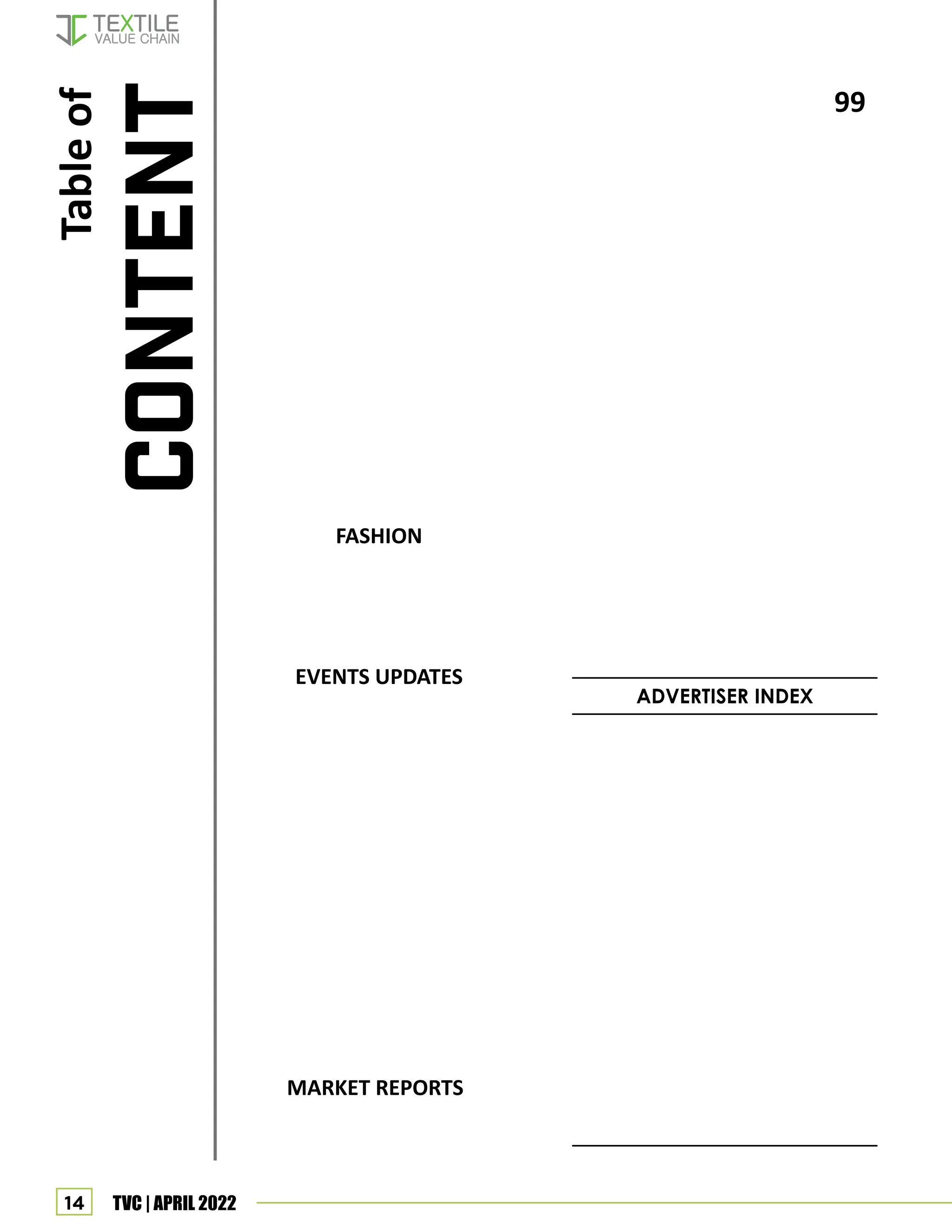
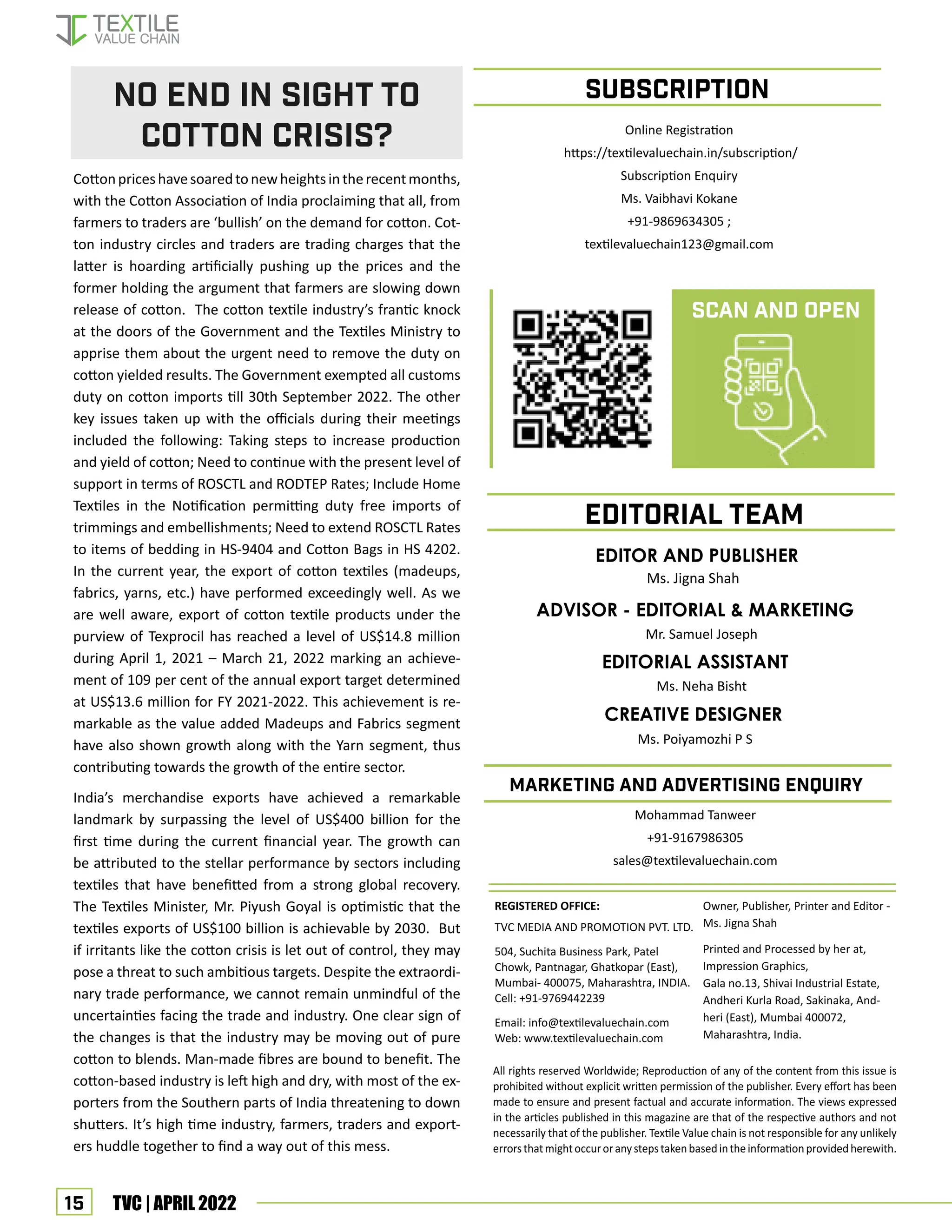

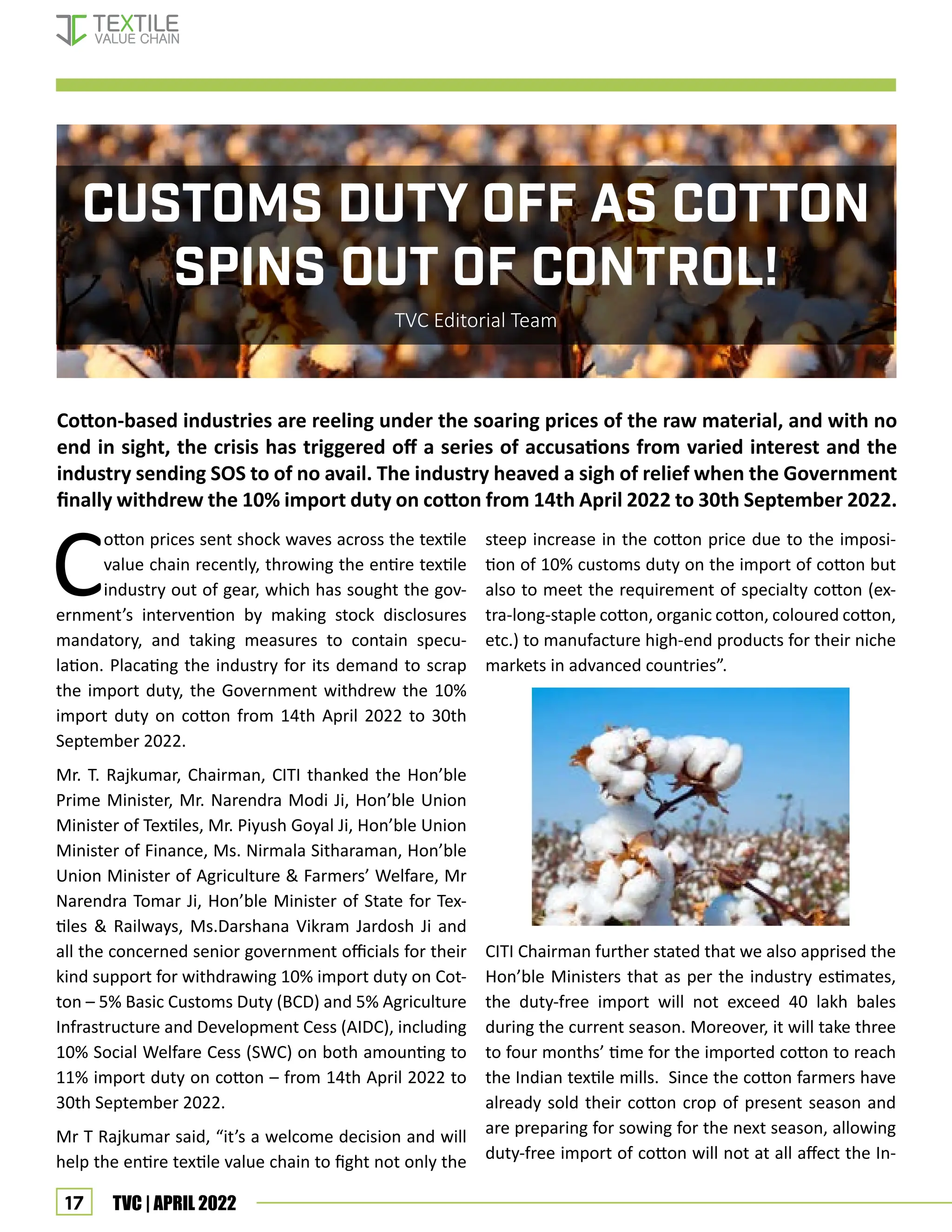
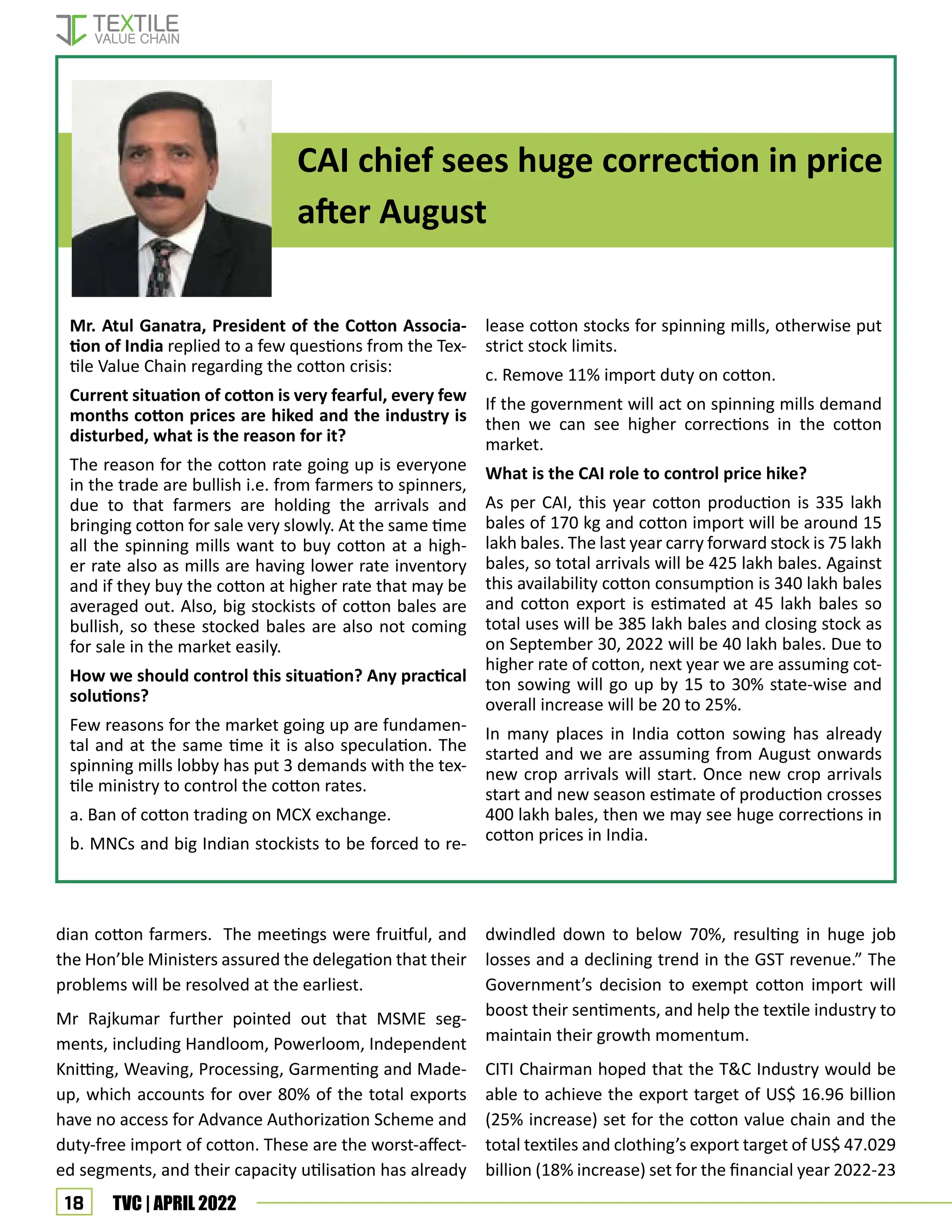

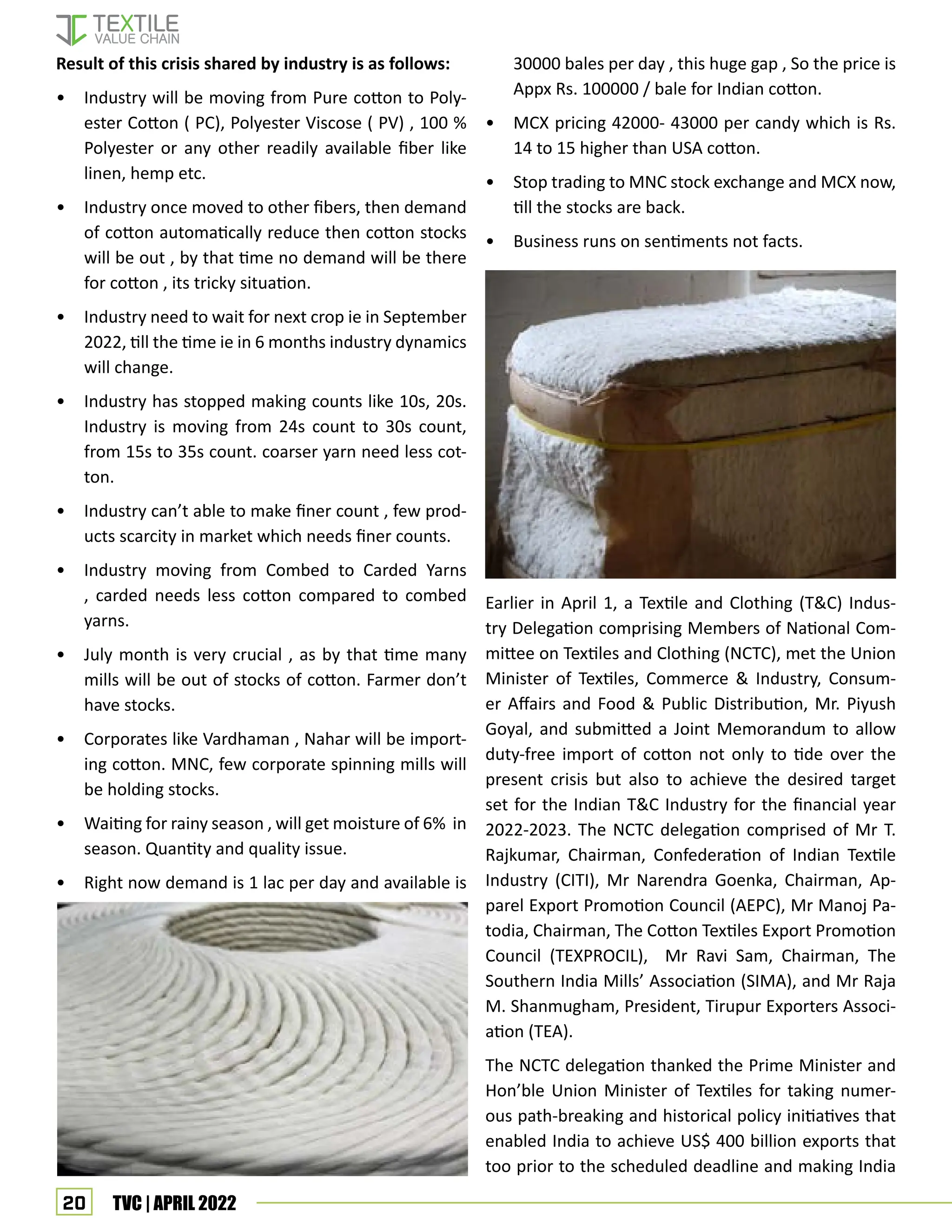
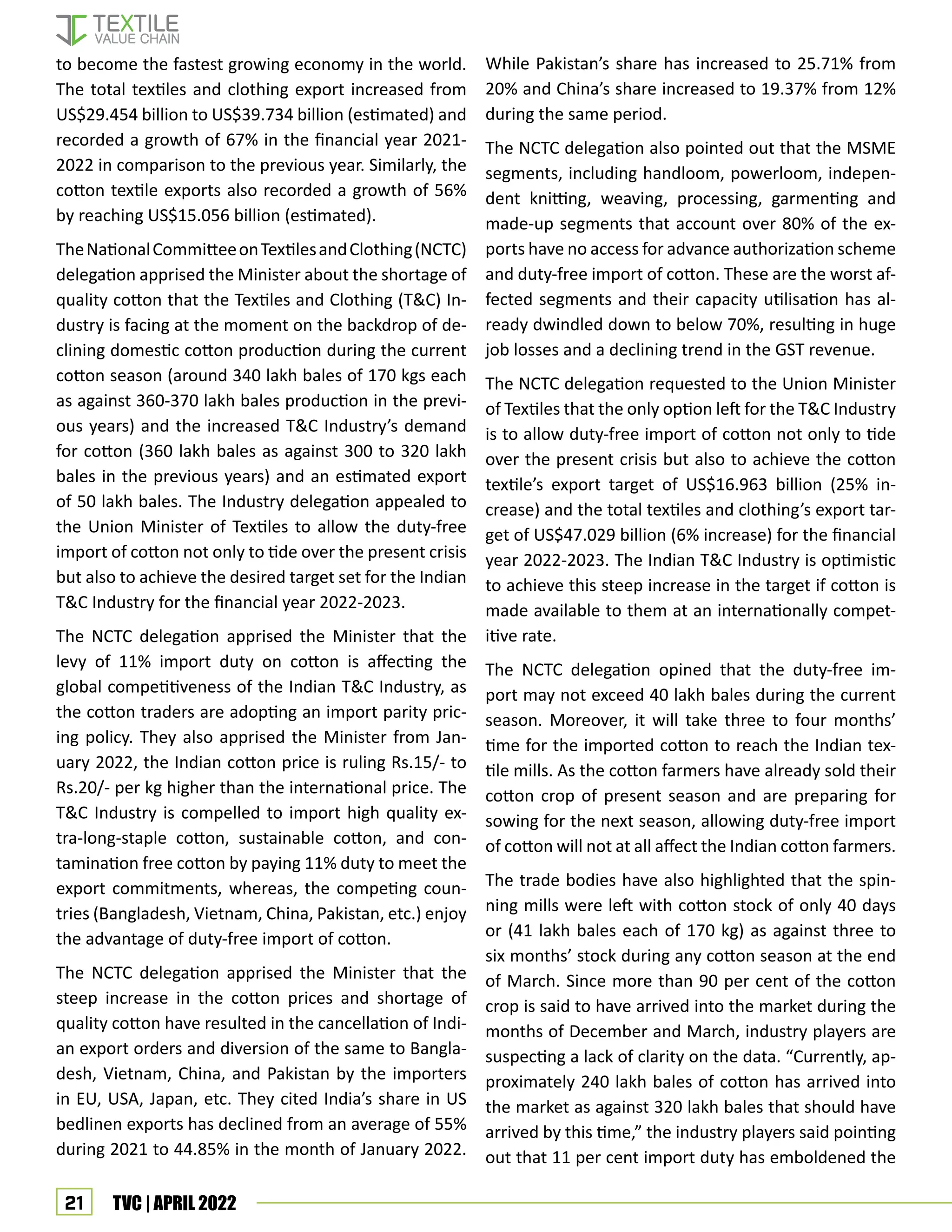
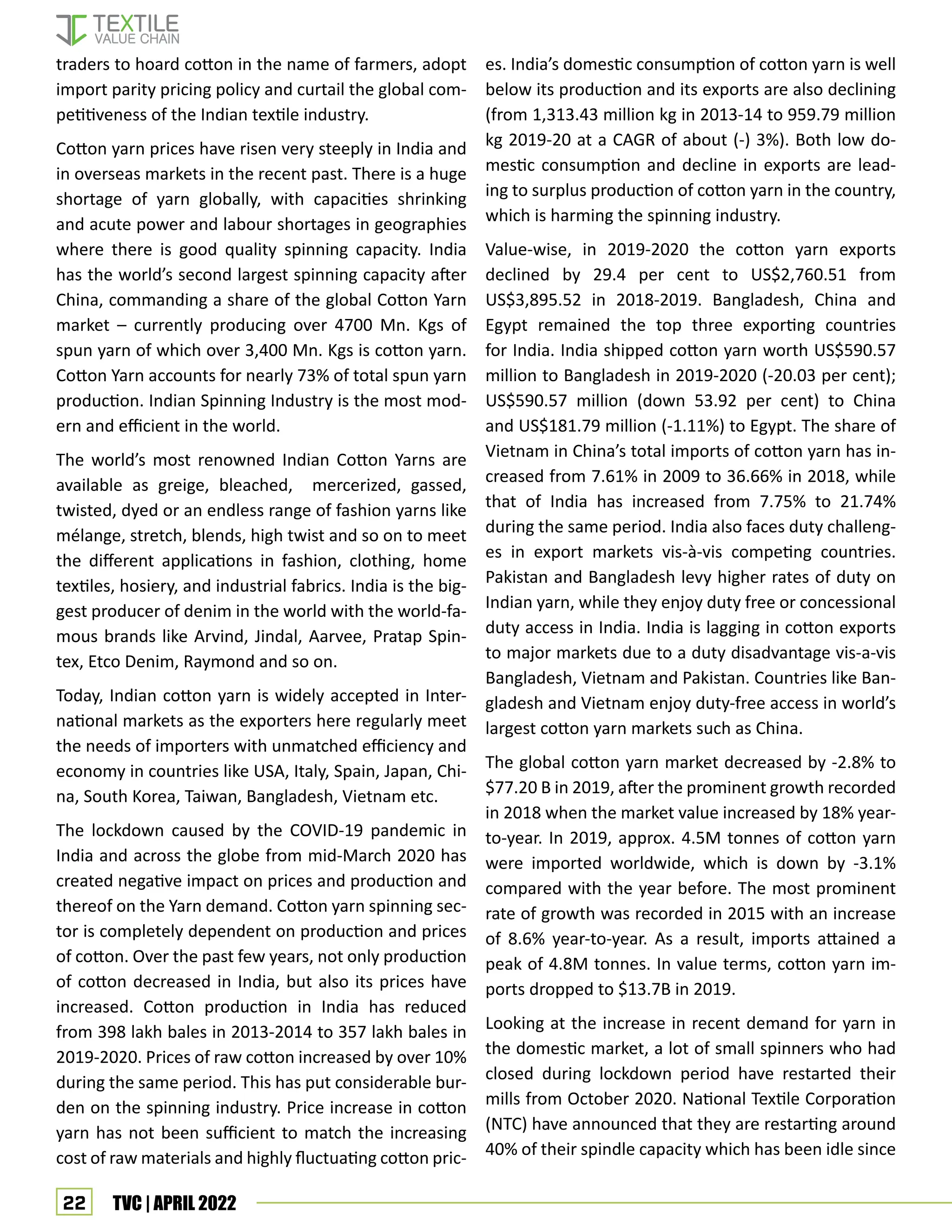
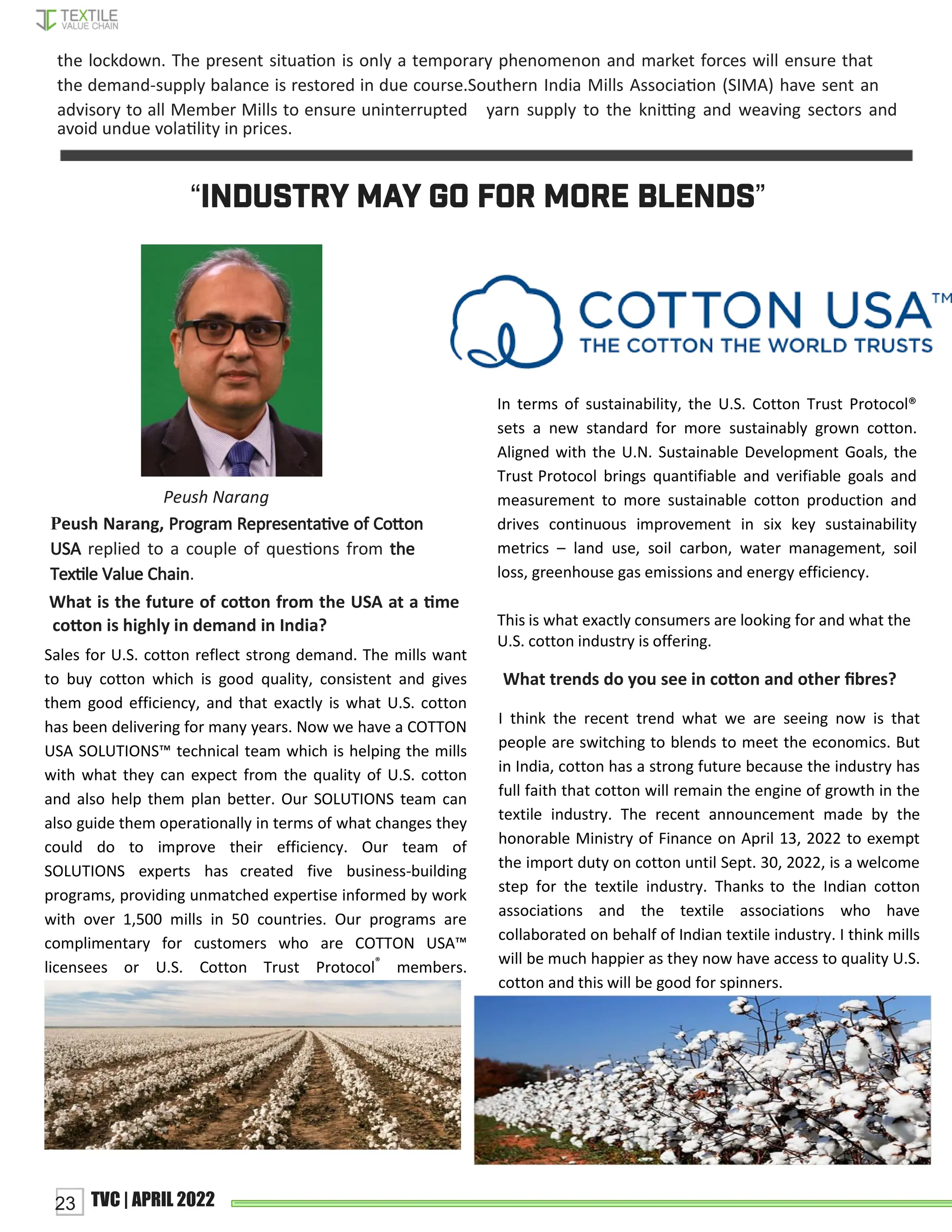
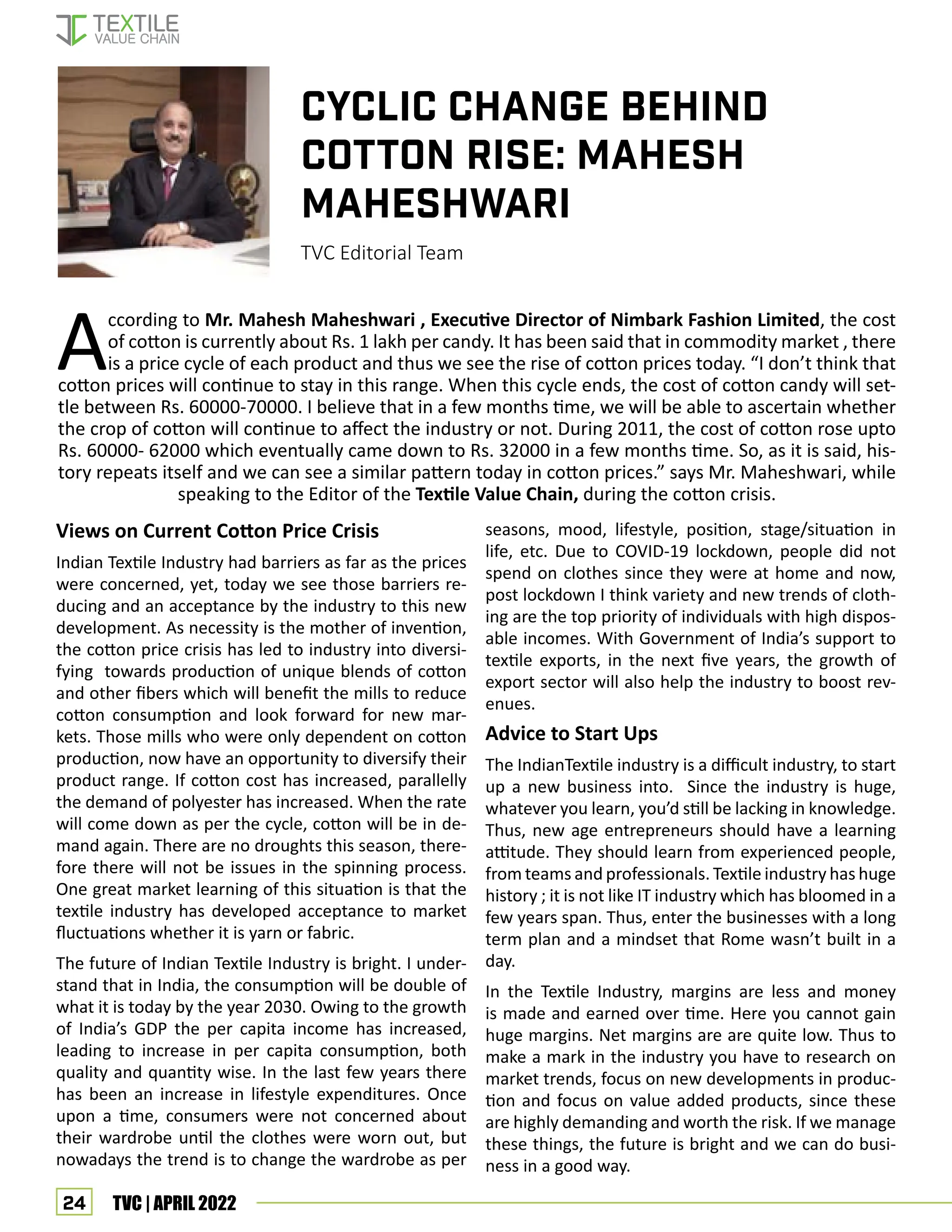
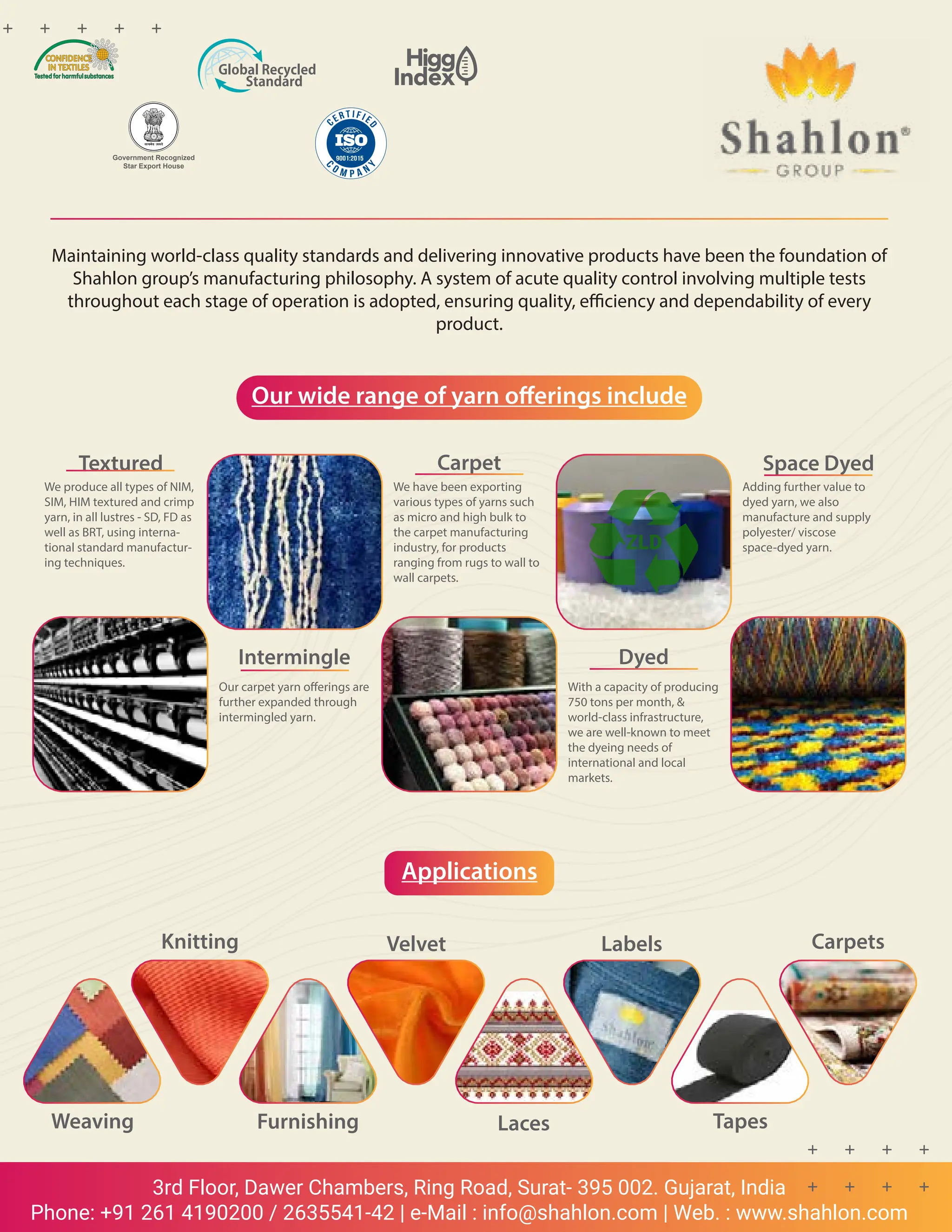
![26 TVC | APRIL 2022
OVERVIEW OF SMART FIBRES
Sakshi Khool
D.K.T.E’S Textile & Engineering Institute, Ichalkaranji
ABSTRACT
O
ver the past few years, smart fibres have seen tremendous growth, especially in terms of
research funding and development of start-ups. However, succeeding in reaching the con-
sumer market are a very few products. Indeed, one of the main challenges remains the lack
of standardised test methods to evaluate properties and performance of smart fibres. In this review
paper, we will talk about the history, applications, future readiness of smart fibres. Smart textiles
synonymously known as electronic textiles, e-textiles, intelligent textiles, and alike is a class of ma-
terials, where textiles play a vital role but where functionalities from other disciplines are added.
In technical textile area significant progresses have been achieved in last few years. There are many
separate and distinct fields of science and engineering. Considerable movement and convergence
has takes place between these fields of endeavour and results have been astonishing. One of these
results is Smart technology for materials and structures. Smart textiles are one of the exciting new
frontier technologies in engineering and manufacturing. Due advantages in many technologies cou-
pled with advances in textile materials and structures smart fibres are possible. Biotechnology, in-
formation technology, microelectronics, wearable computers, nanotechnology and micro electro-
mechanical machine are included in partial list.
There are three categories in which smart fibres are classified according to their function. Results in
an outcome named as smart textiles are the amalgamation of electronic components and advanced
fibres with manmade textiles extend the field of material science and digital electronics. Often even
before we do the world of fashion knows what we want to wear. Be it the trending hemlines or the
latest accessories, designers around the world predict and often create the future when it comes to
preference. Smart fibres is one thing that has been picked up by a lot of such visionary designers.
Smart fibres are created by modified textile material and miniaturised electronic devices [3].
Definition
Smart fibres and structures can be defined as mate-
rials and structures that can sense and react to envi-
ronmental conditions or stimuli , such as those from
mechanical, thermal, chemical, electrical, magnetic
or other sources. Smart fabrics have been defined as
fabrics which are defined and manufactured to include
technologies that provide to the user increased func-
tionality.
Classification
Fibres can be divided into three materials according to
Smart Fibres](https://image.slidesharecdn.com/tvcapril2022-digital-231017111127-81362480/75/Textile-Value-Chain-April-2022-26-2048.jpg)
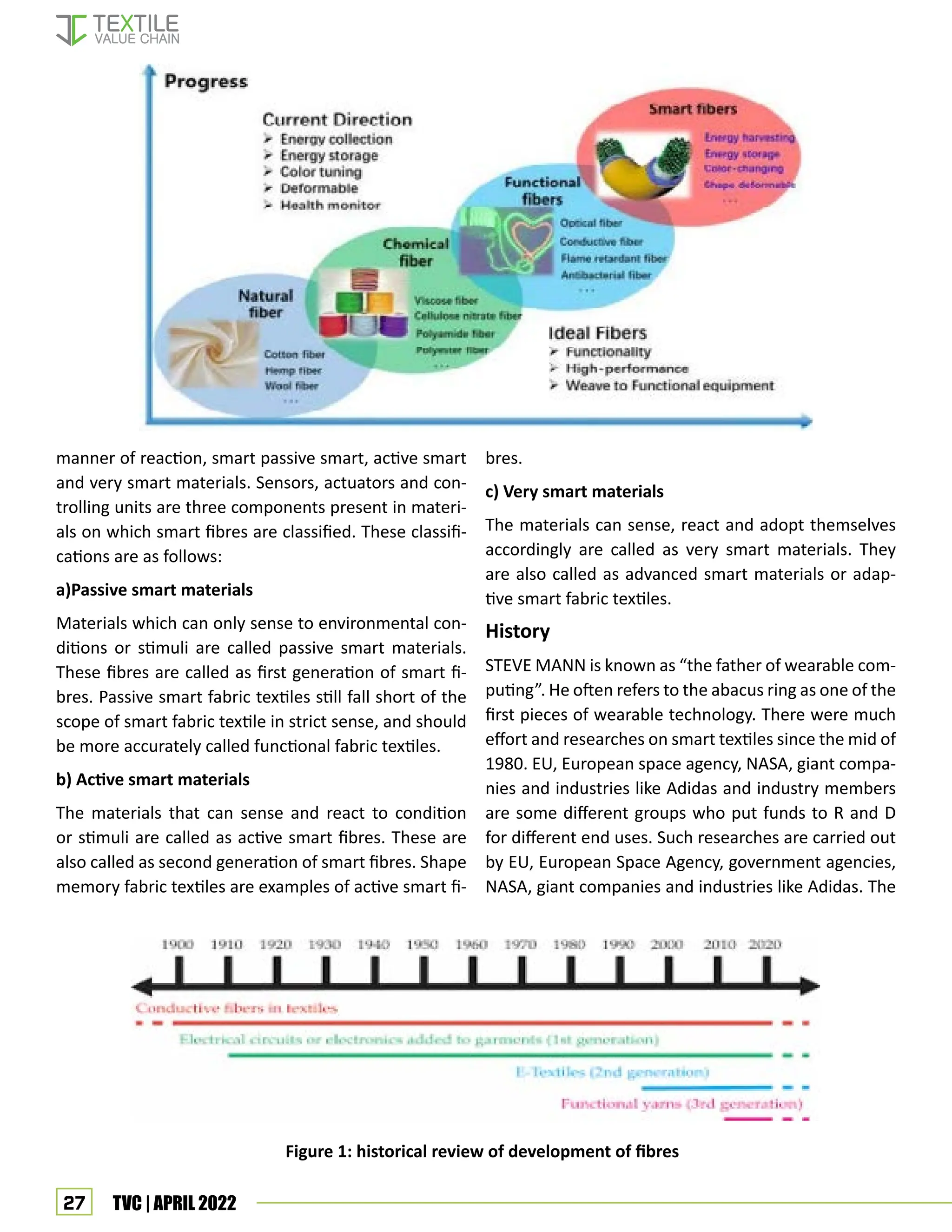
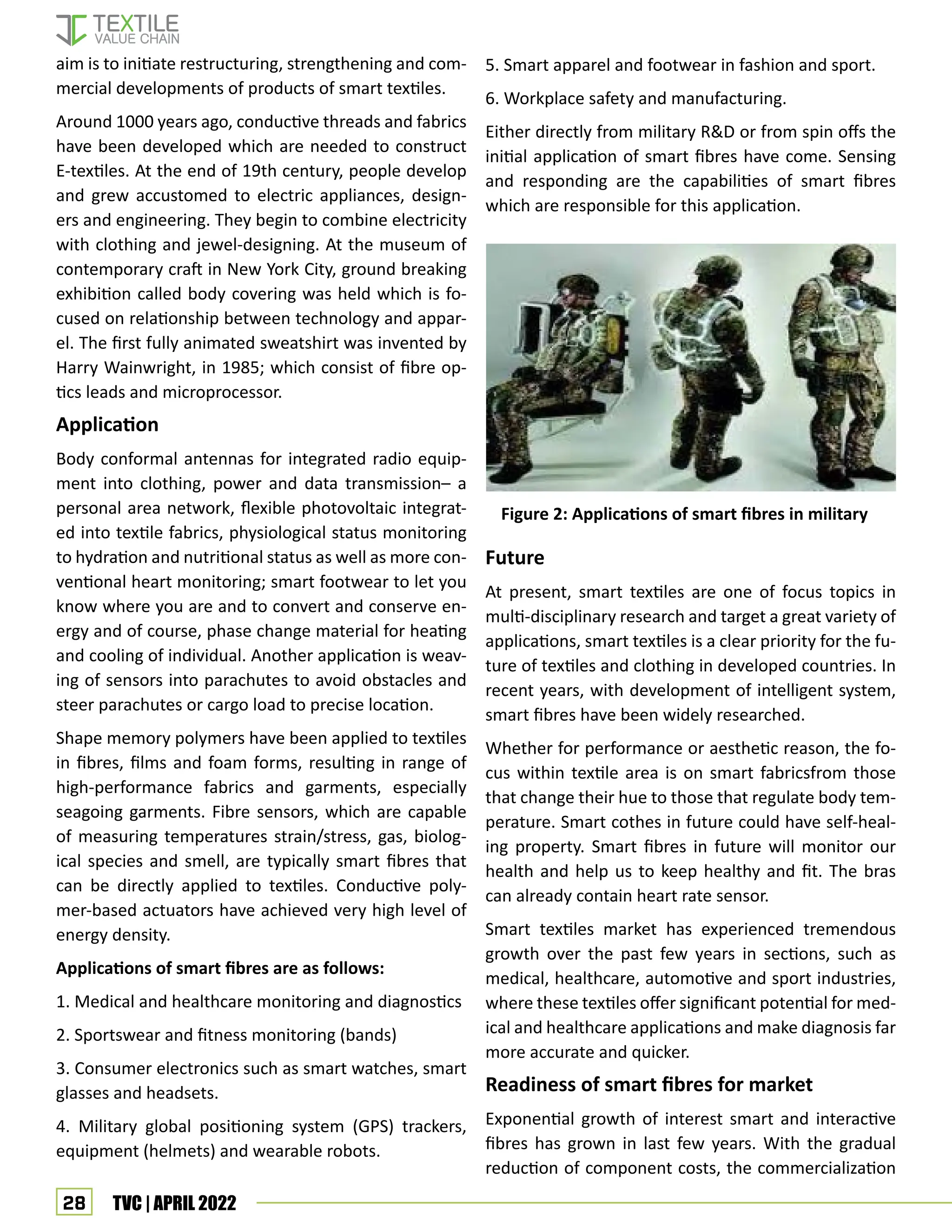
![29 TVC | APRIL 2022
of many of the smart technologies becomes achiev-
able. The demand for intelligent materials to develop
electric textiles (e-textiles) and smart apparel is rap-
idly growing up for industrial application such as sen-
sors, electrostatic discharge, steel corrosion, electro-
magnetic interference, shielding, dust free clothing,
monitoring, military application and data transfer in
clothing and all other field [3]. Smart textiles are not
yet ready for the market at large scale, even if smart
textiles are gained a certain level of maturity [5].
Numerous fields of applications including different
trends fields in leisure and sports, some lifesavings in
health care, security and military are new developing
sectors captured by smart fibres. Printed electronics
and energy harvesting technologies are evolving to
meet the demands of new, wearable formats. A lot
of work has been performed to make washable ready
to market smart textile products and wash ability of
smart textile has gained attention now days [5].
Risks involved in using smart fabric
The obvious flip side of using smart fibres is the po-
tential misuse of their capabilities. There is also per-
manent risk of unwanted or unintended body sur-
veillance and the erosion of any remaining sense of
privacy. One of challenges for manufacturing of smart
fabric is achieving seamless and invisible integration of
electronic into fabric. Consequently, researchers need
to provide fibres with desired electronic functionality
without compromising strength, comfort and aesthet-
ic apparel [4].
This technology gives uncomforted sensing of the
wearer, and a major challenge in wearable comput-
ing is how to interconnect these components with
soft textile, and find alternatives to silicon, metal, and
components with difficult to integrate them in textile.
However, the disadvantage of this kind of textile is that
the electric component must be removed before wash-
ing and it cannot be washed with an electric machine,
and so expensive. Both the textile and electronics field
should be compliant with requirement by commercial
smart textiles.
Conclusion
Advanced material, polymers, micro-electronics, com-
puters and information technology are the areas in
which number of researches and development are
conducting. These researches are done to develop and
advancement of new materials and better commu-
nication. Textiles are also changing day by day. There
are lots of developments which include lots of appli-
cations, which make the life easy and healthy. These
products are lifesaving, have protective clothing and
importance for medical and healthcare.
References
1. Ana M Grancaric, I. j. (2018): Conductive Polymers
for Smart Textile Application, Journal of Industrial
Textiles, 612-642.
2. Asis Patnaiik, S. P. (2020): Fibres to Smart Textiles .
CRC Press.
3. Meinander, H. (2014): Smart and Intelligent Textiles
and Fibres, Textiles in Sports , 120-133.
4. S. Lam Po Tang, G. S. (2006): An Overview of Smart
Technologies for Clothing Design and Engineering.
5. International Journal of Clothing Science and Tech-
nology .
6. SU Zaman, X. T. (2018): Market Readiness of Smart
Textile Structures--Reliability and Washability, Material
Science and Engineering.
7. Tang, S. L. (n.d.).
8. Tao, X.-M. (2001): Smart Fibres, Fabrics and Clothing:
Fundamentals and Application, Woodhead Publishing
Limited.
Figure 3: Shape memory fibres](https://image.slidesharecdn.com/tvcapril2022-digital-231017111127-81362480/75/Textile-Value-Chain-April-2022-29-2048.jpg)

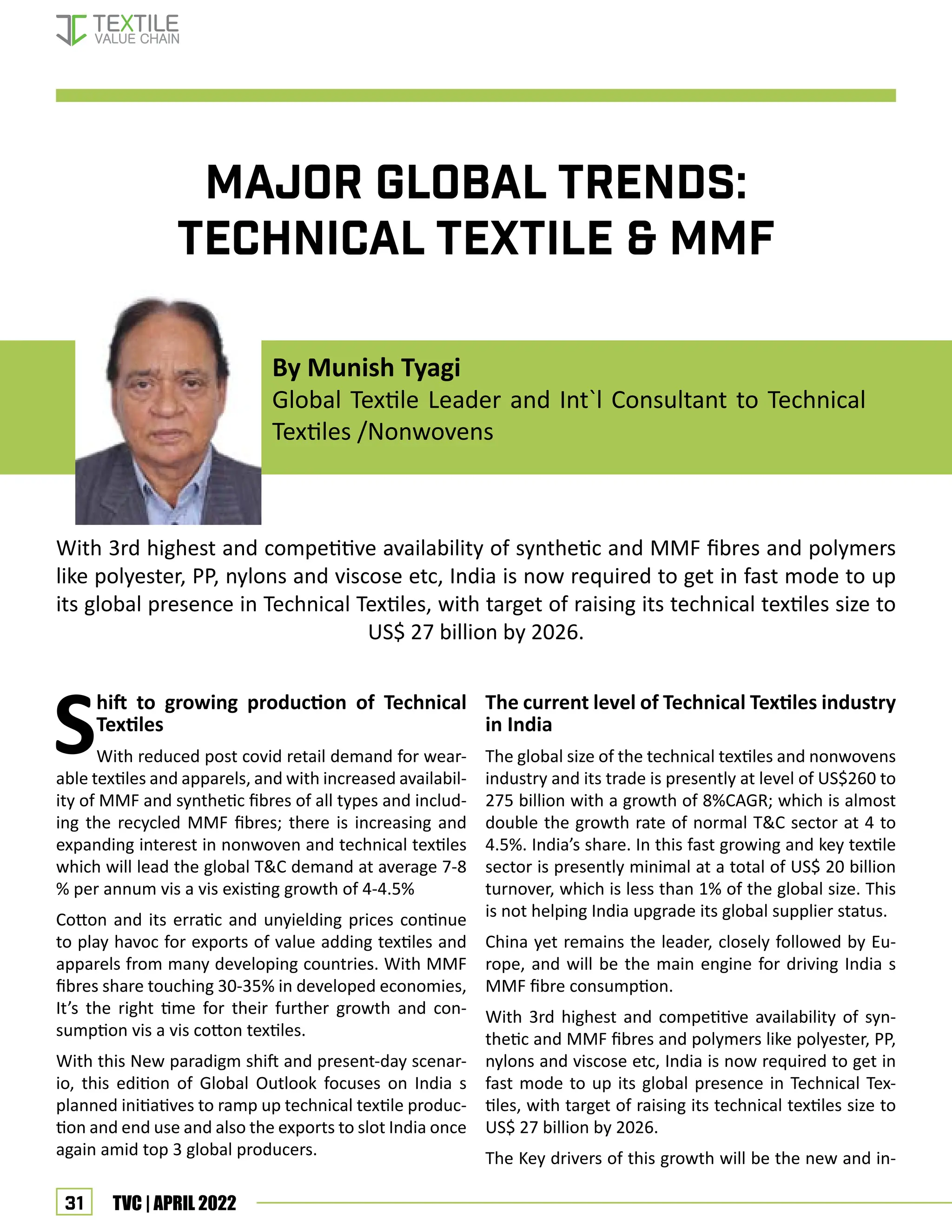
![32 TVC | APRIL 2022
creased focus on production of speciality industrial
textiles to be end-used in hi-growth and strategic sec-
tors like the medical textiles, geotechnical textiles,
Aerospace and high-altitude end use where India is
very upbeat, the Indian Defence and civil infrastruc-
ture segments for creating high speed rail network,
new ports, new airports and tunnels and road in high
altitude areas like Kashmir, Ladakh and North East and
also including a string of new highways, etc.
It is now further endorsed that, with double the `de-
mand `growth rate versus the traditional T&C textiles,
the global textile recovery post Covid is to be led by this
new industrial textile sector led by increased availabil-
ity of MMF and synthetic fibres/filaments and growing
industrial use of `speciality` and advanced materials
based on new age fibres like Carbon, Aramide, Ceram-
ic and glass fibre, etc.
INDIA’s 4 Aces, that is 4 most impactful new policies to
help drive the production and use of technical textiles.
The Indian Government is now ready to provide to the
textile industry with its 4 new aces which will be the
key engines of growth for technical textile sector, as
also for pushing India’s global T&C share:
a. The TTDS scheme, with an outlay of Rs. 160,000
million is being launched to replace the 25-year-
old TUF scheme for incentivising the new invest-
ment in textile sector. However, the focus will be
advanced technology and such indigenous ma-
chinery development capabilities.
b. The NTTM scheme [that’s is National Technical
Textiles Mission spearheaded by Textile Ministry/
GOI] scheme, is being continued with a budget of
Rs.10,000 million for the textile industry to venture
into high tech projects in technical textiles arena.
c. The PLI or the production linked scheme is anoth-
er new mega investment scheme to rope in large
corporate and global investors into textile industry.
The PLI scheme will bring in large output produc-
tion and with focus on both MMF fibre use and
manufacturing of technical textiles. Already more
than 70 serious applications and project Intents
have been registered.
d. The launch of the MITRA scheme for development
and operations of large size or mega Textile Parks
to attract large global investment into such world
class `play n plug` manufacturing zones in different
corners of the country and ideally placed close to
the fibre production centres and seaports.
India’s competitive advantages v/s global
competitions
To be able to enhance India’s textile sector size to
US$100 billion plus by 2024, and slot itself with aver-
age of 8% share in global T&C/Tech textiles trade, India
has to emerge as leading China +1 global supplier and
lead from front using the competitive advantages such
as; Availability and access to all key raw materials and
MMF fibres,
2. However, India has to make a strong thrust into de-
velop and production of speciality fibres like carbon
fibres, Aramides, ceramic, glass and other fibres with
special focus on high tech textile end uses that are
based on `sustainability` and green issues.
3. India does have the advantage of competitive wag-
es, and yet needs to scale up for the production and
new markets.
India yet needs to address the deficiency and
critical gaps areas below
India needs to actively pursue free-trade agreements
(FTAs) with major export destinations like the EU ,and
the US to push apparel shipments amid increasing
competition from fast growing rivals like Vietnam,
Bangladesh, Turkey, Egypt, and Cambodia that enjoy
tariff concessions, under liberal duty free trade agree-
ments like GSP+ and TPT 11 and others.
India has traditionally enjoyed a comparative advan-
tage in the cotton-based textile sector, including ap-
parels, and they constitute a major chunk of India’s
export basket. However, India’s shift to MMF textiles
now has to be immediate and a serious call to enhance
its share in the global T&C trade to more than 5% and
also to take its rightful place as China+1.
Project No. Project Title Project Capacity
1 Export focussed YARN SPG
MILLS,OF 25 K spdls,for BCI/
Organic yarns,for Knttg &wvg
Approx..20 TPD
2 Cotton Yarn Mill with Ring and
OE spg,withInhouse Knitting
unit
15 to 20 TP-
D,with 5TPD
knttg.
3 3.Integrated Yarn Spg.unit of
20 TPD Ring +OE yarns with
10TPD Terry Towelunit
15 to 20 TPD
New Textile Projects _3 Nos export oriented
*Mail us for Turnkey Proj. Execution.](https://image.slidesharecdn.com/tvcapril2022-digital-231017111127-81362480/75/Textile-Value-Chain-April-2022-32-2048.jpg)


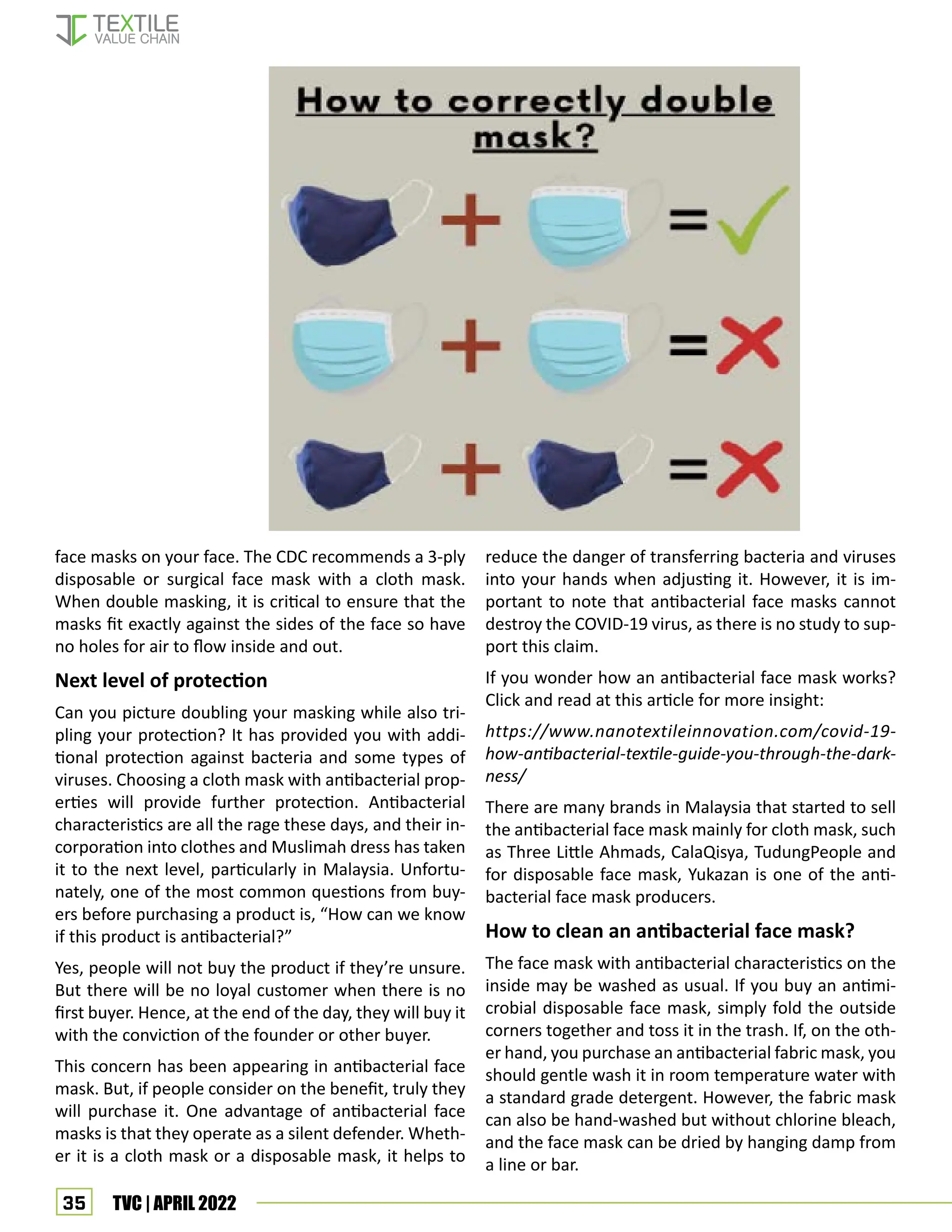
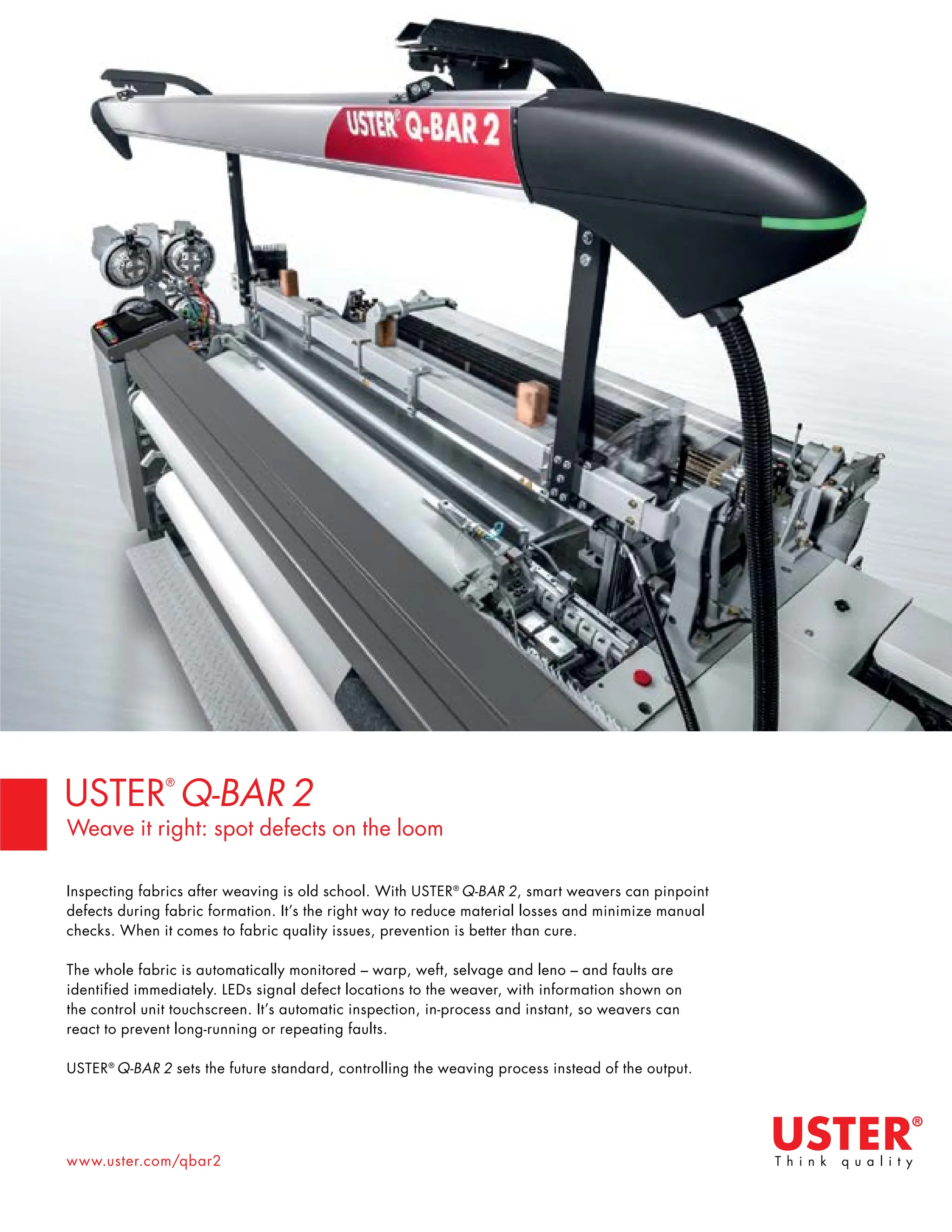
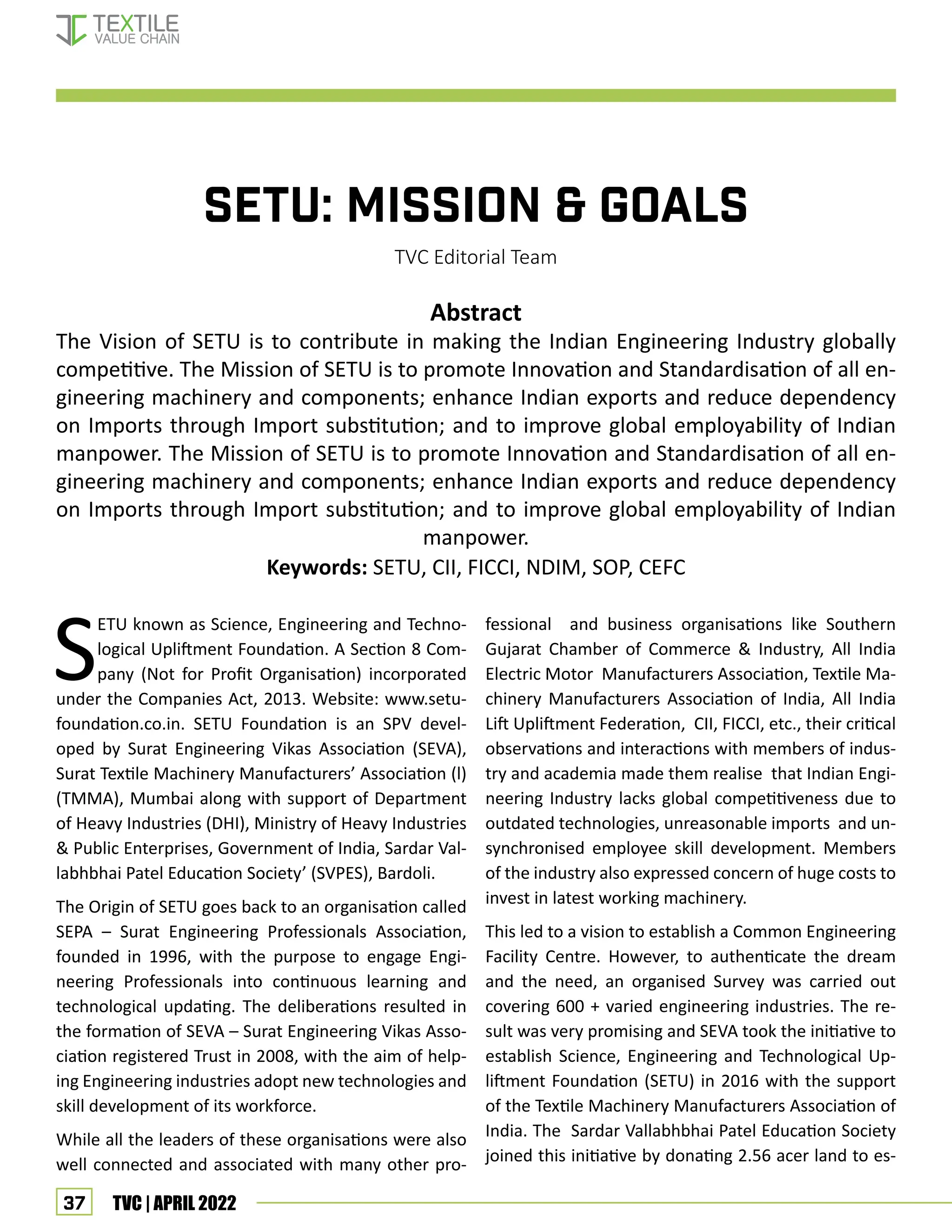
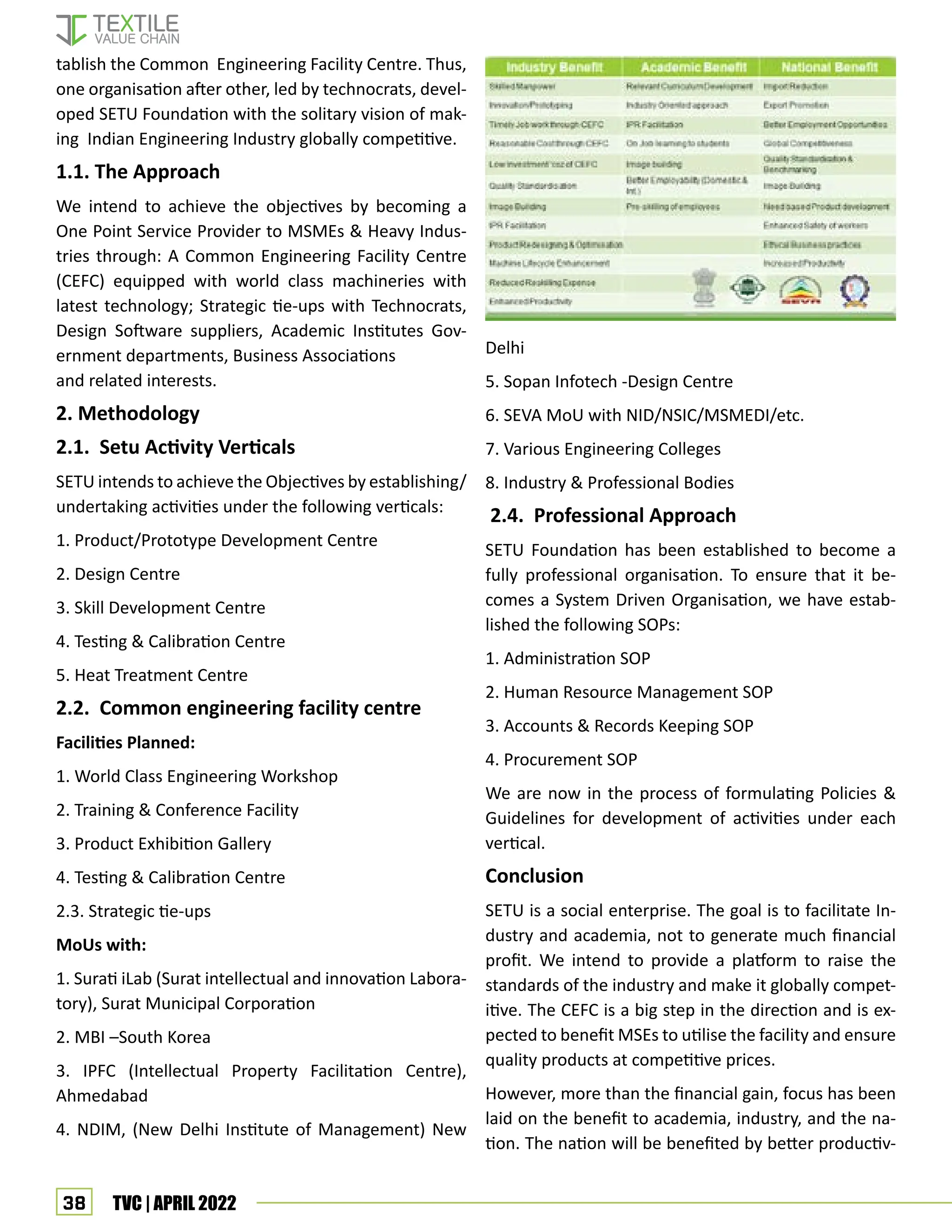
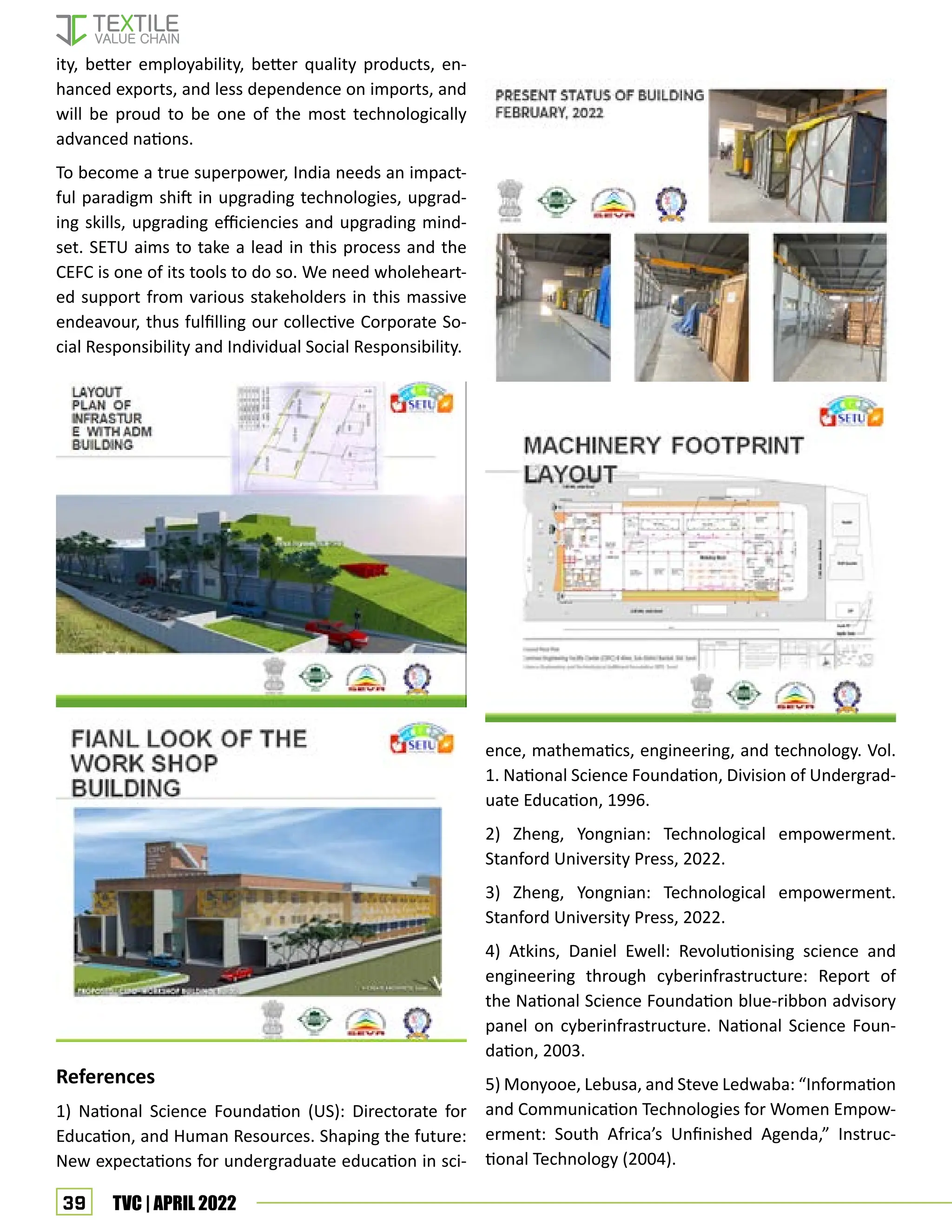
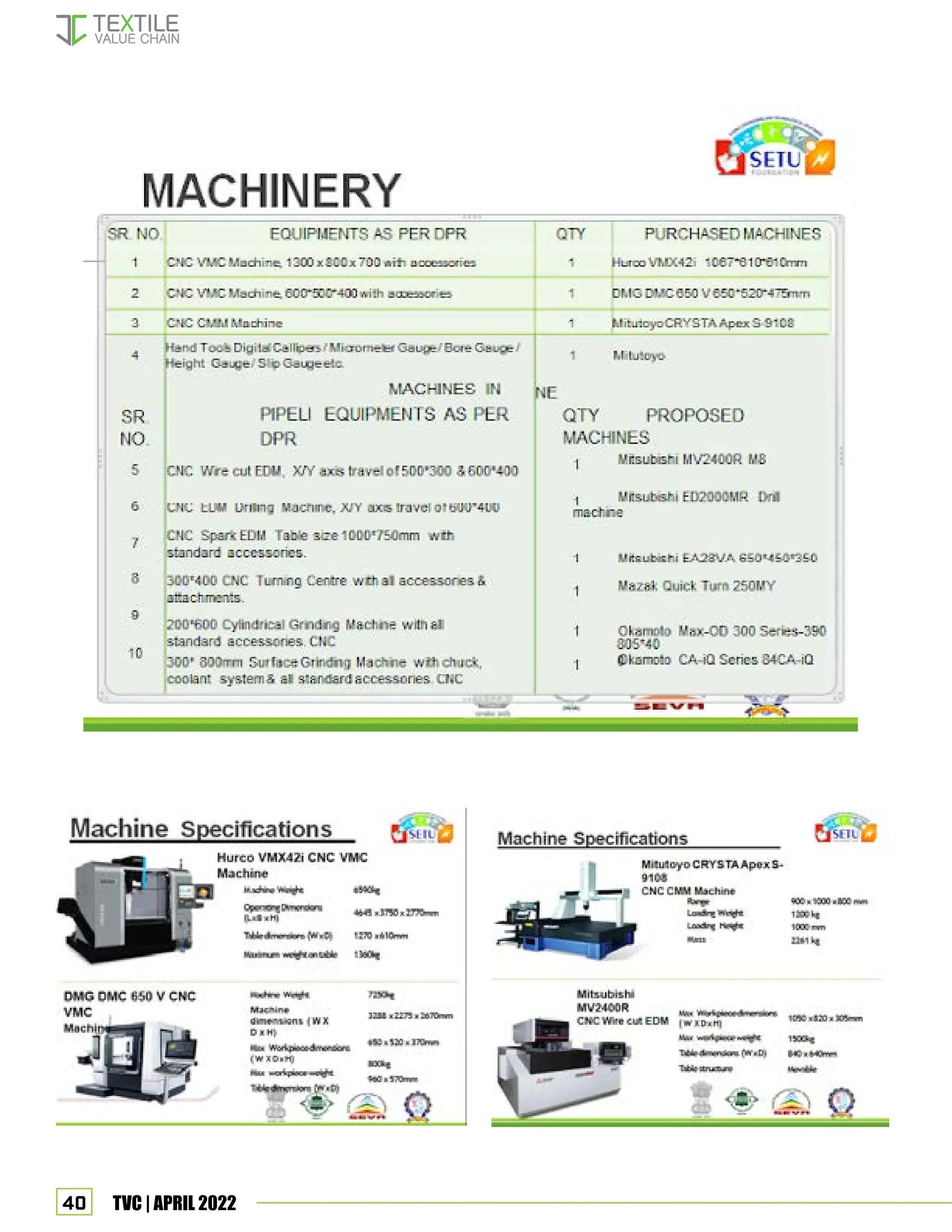
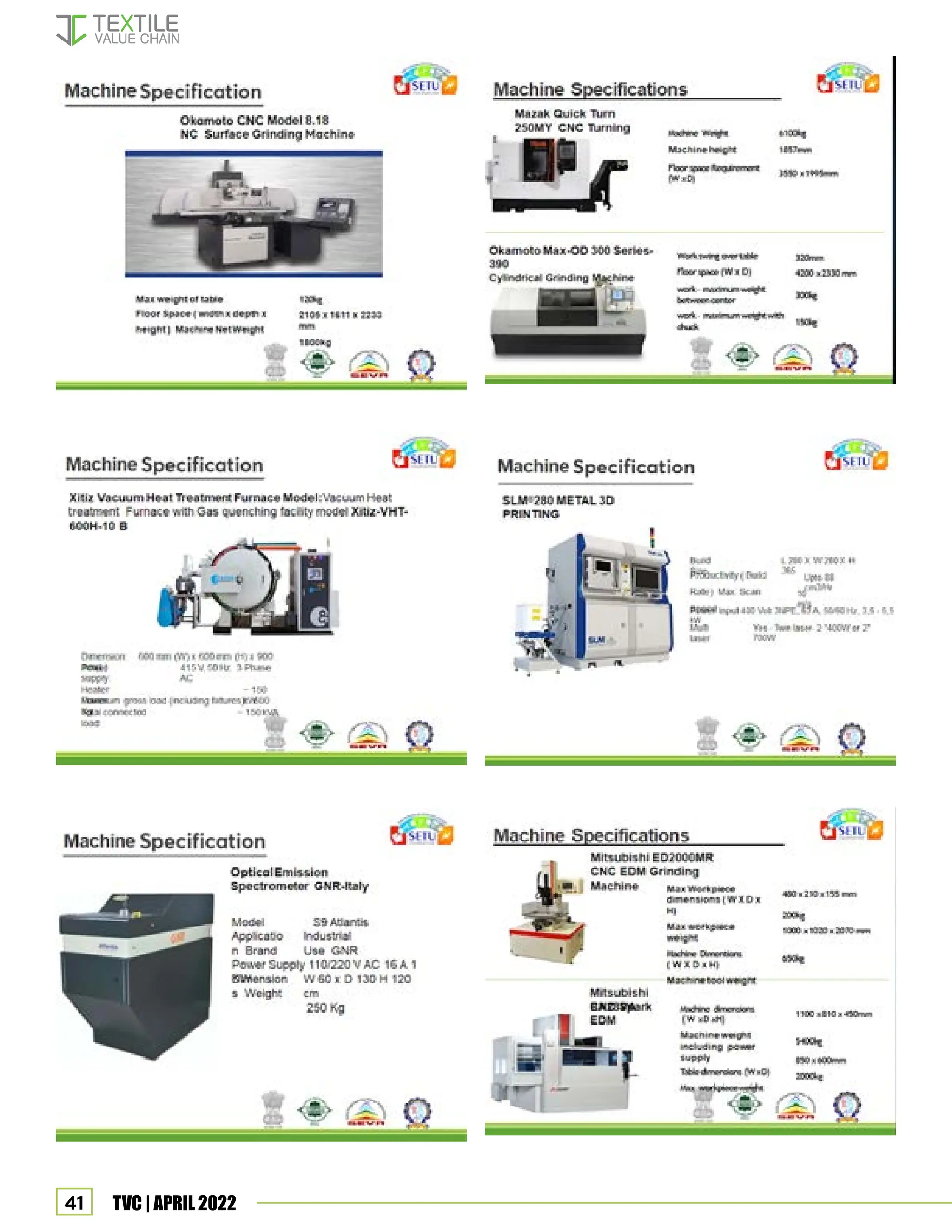
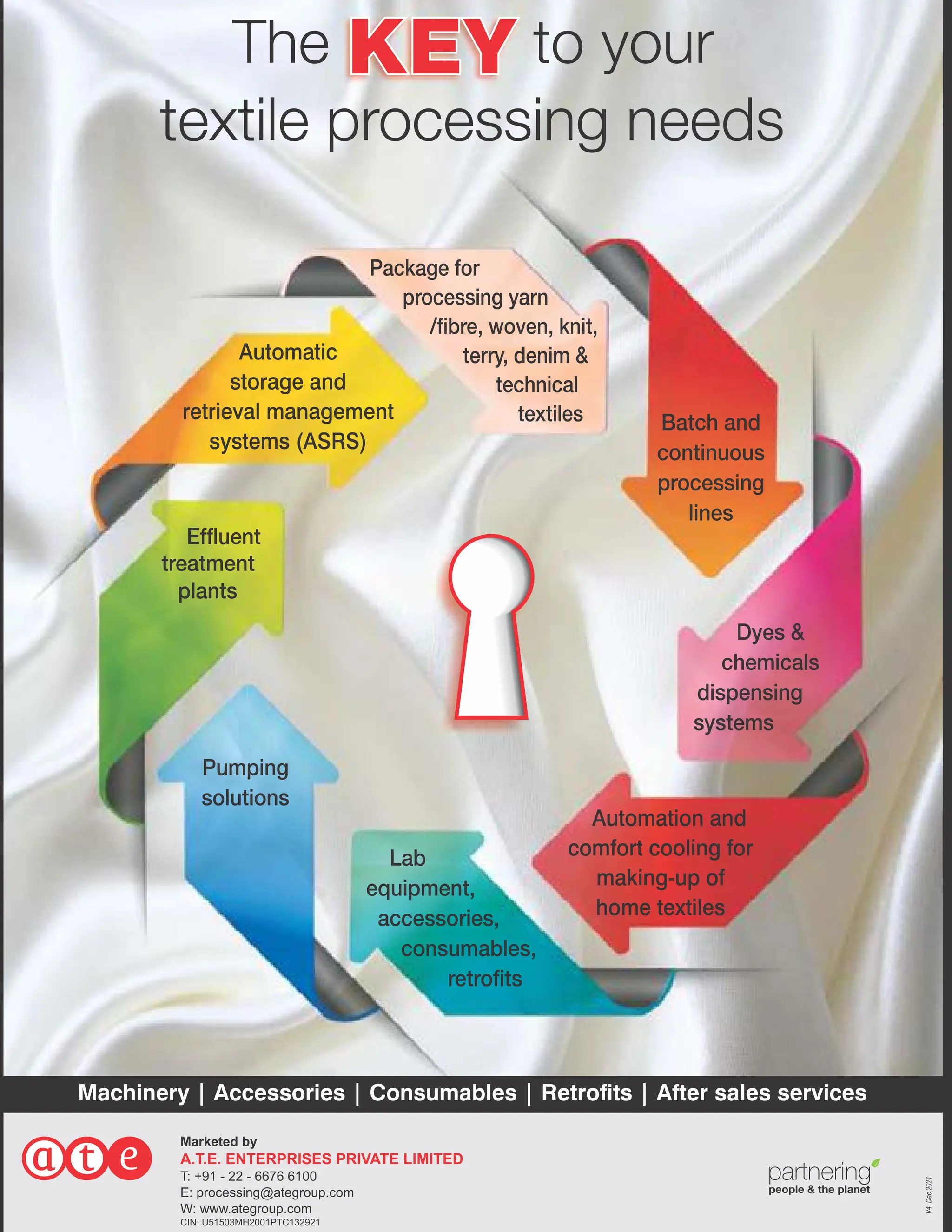
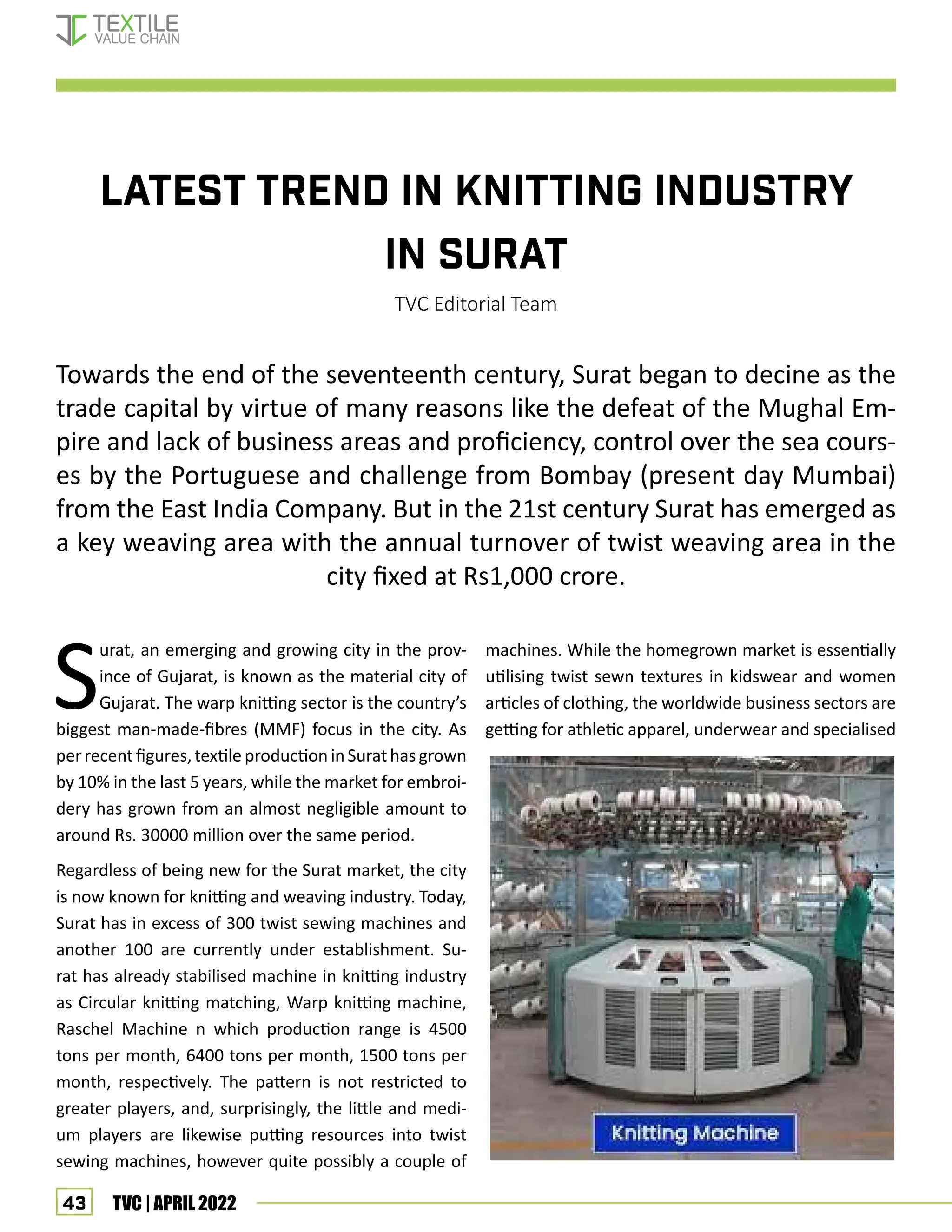
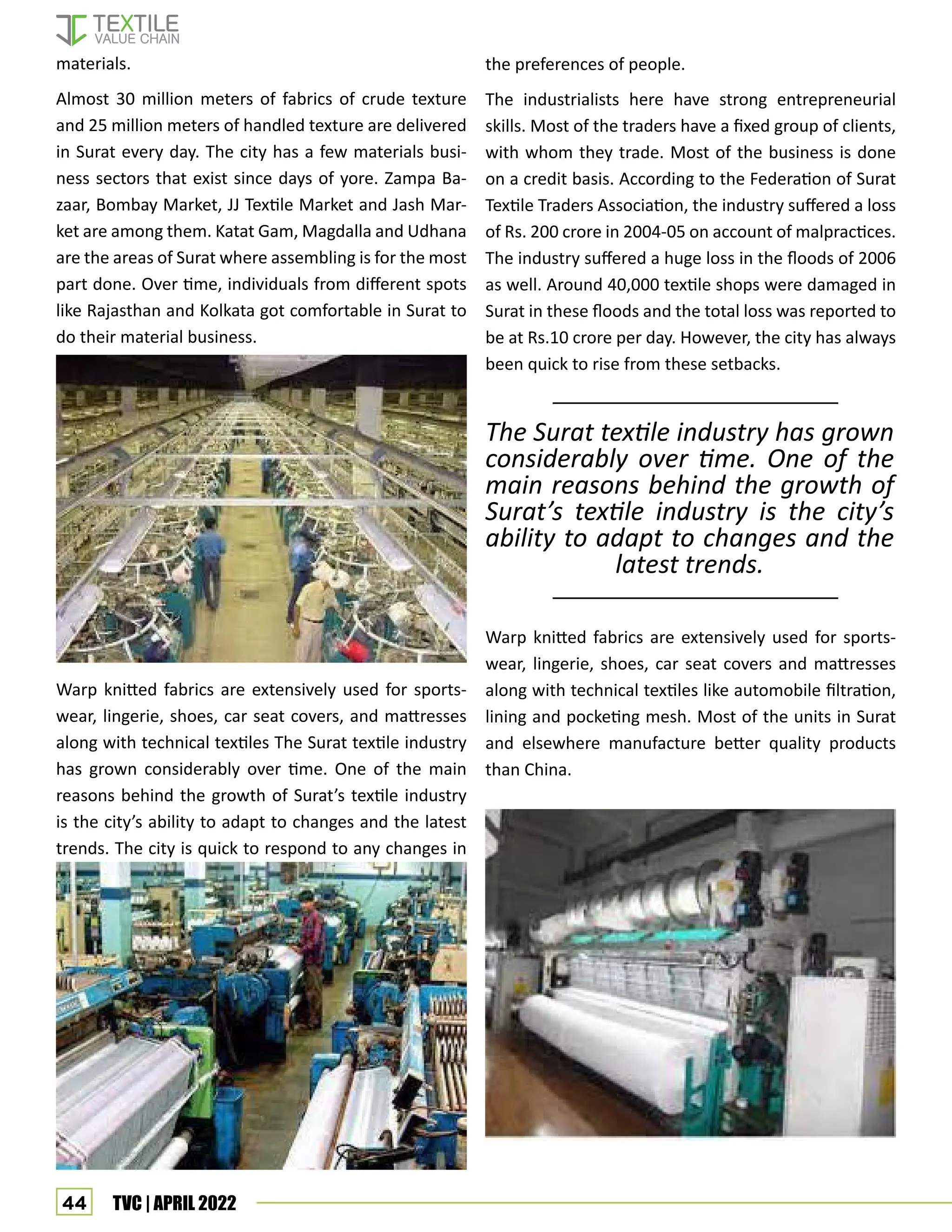
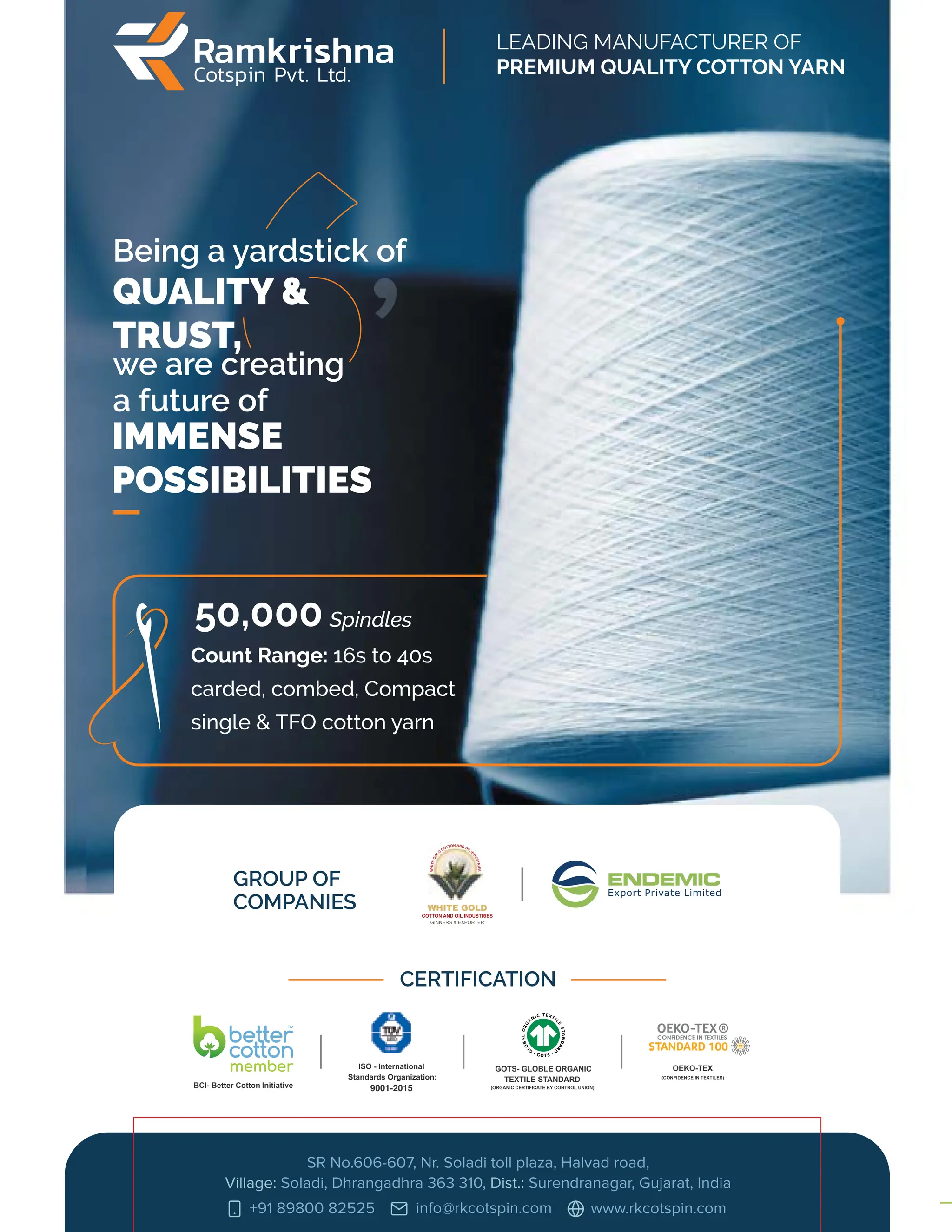
![46 TVC | APRIL 2022
“Gimatex ALWAYS FOCUSES
ON COTTON VALUE ADDITION”
TVC Editorial Team
Gimatex replied to a TVC Questionnaire. Ex-
cerpts:
Mohota Group has a glorious history of over 125
years in the textile industry. Tell us about some
of the important highlights, achievements, mile-
stones during this journey. The Graph below
tells you the story so far…..
[From Left to Right: Vineet Kumar Mohota – Director (Finance),
Basant Kumar Mohota – Chairman, Prashant Kumar Mohota – MD,
Anurag Kumar Mohota – Director (Works)]
interview - Gimatex](https://image.slidesharecdn.com/tvcapril2022-digital-231017111127-81362480/75/Textile-Value-Chain-April-2022-46-2048.jpg)


